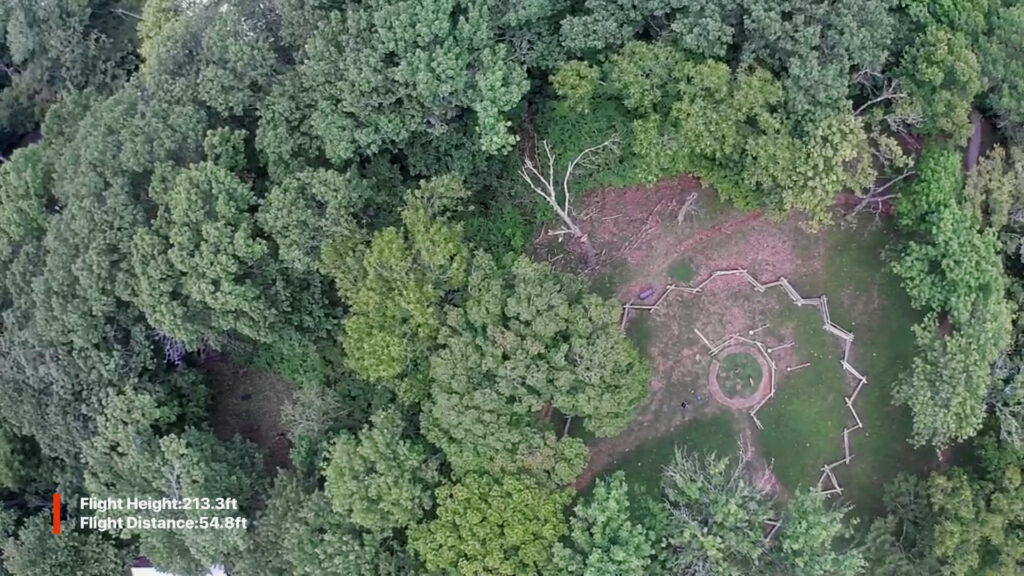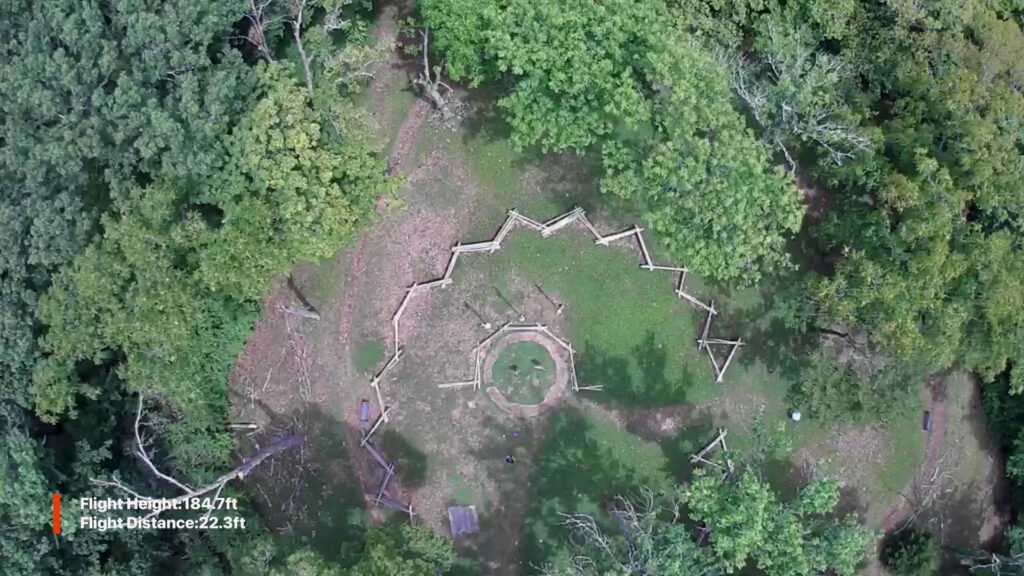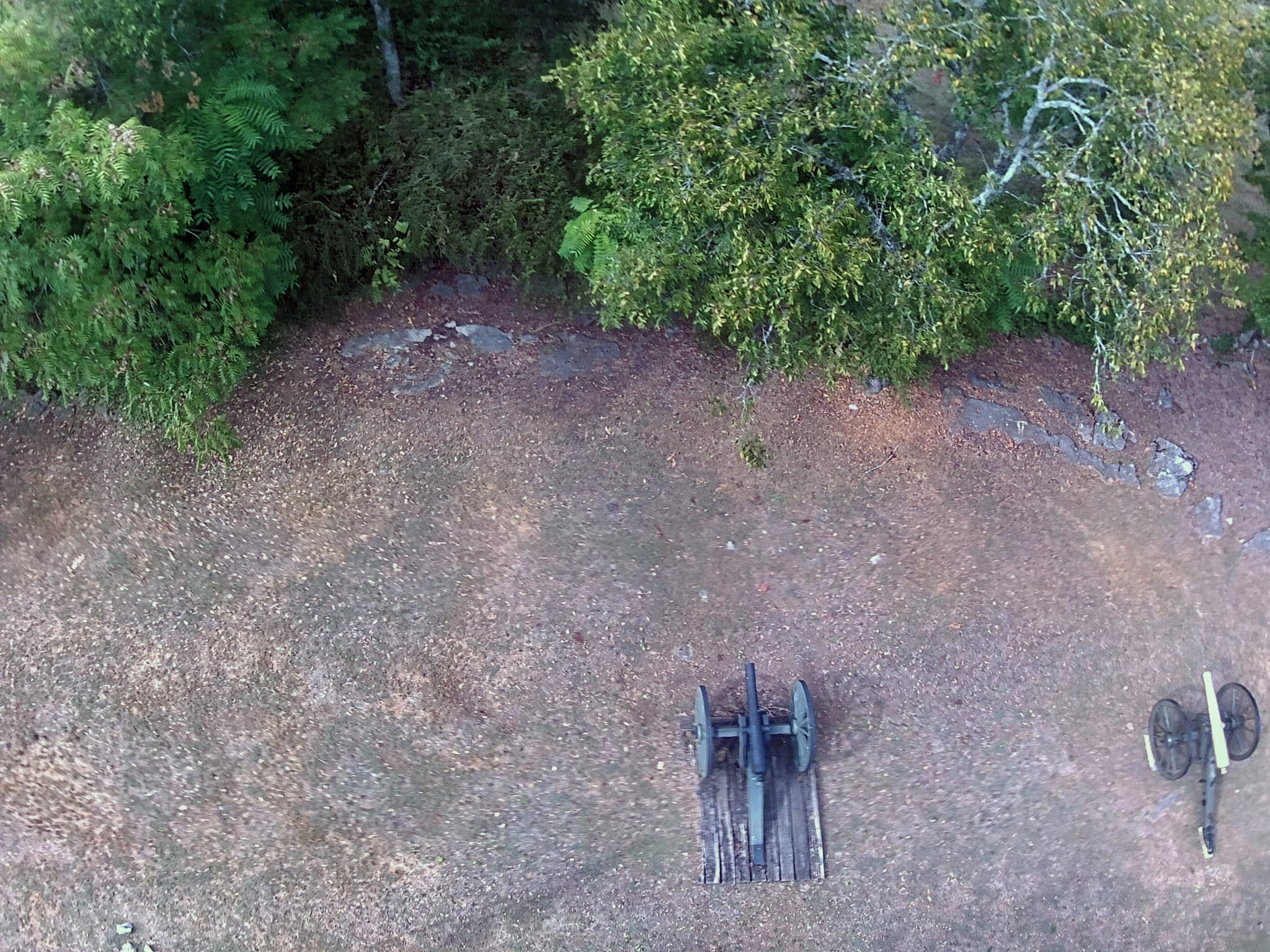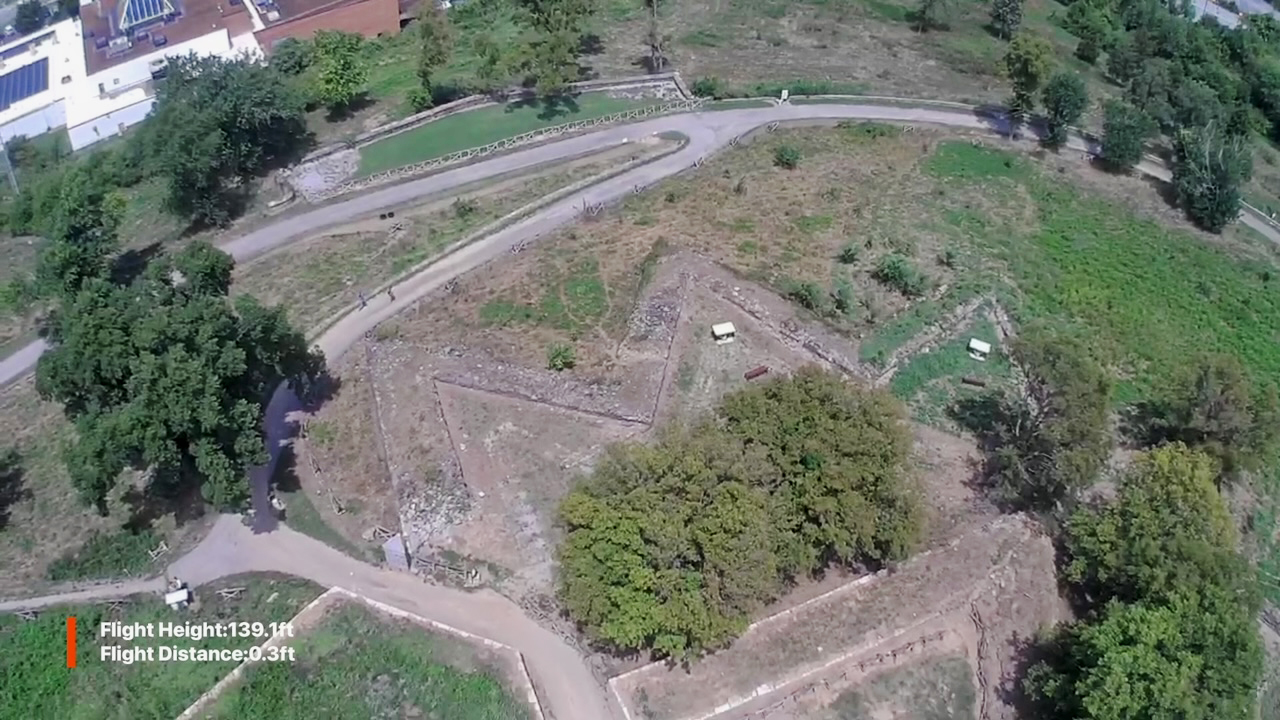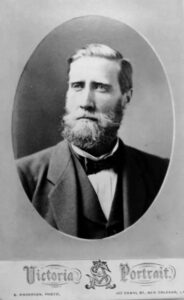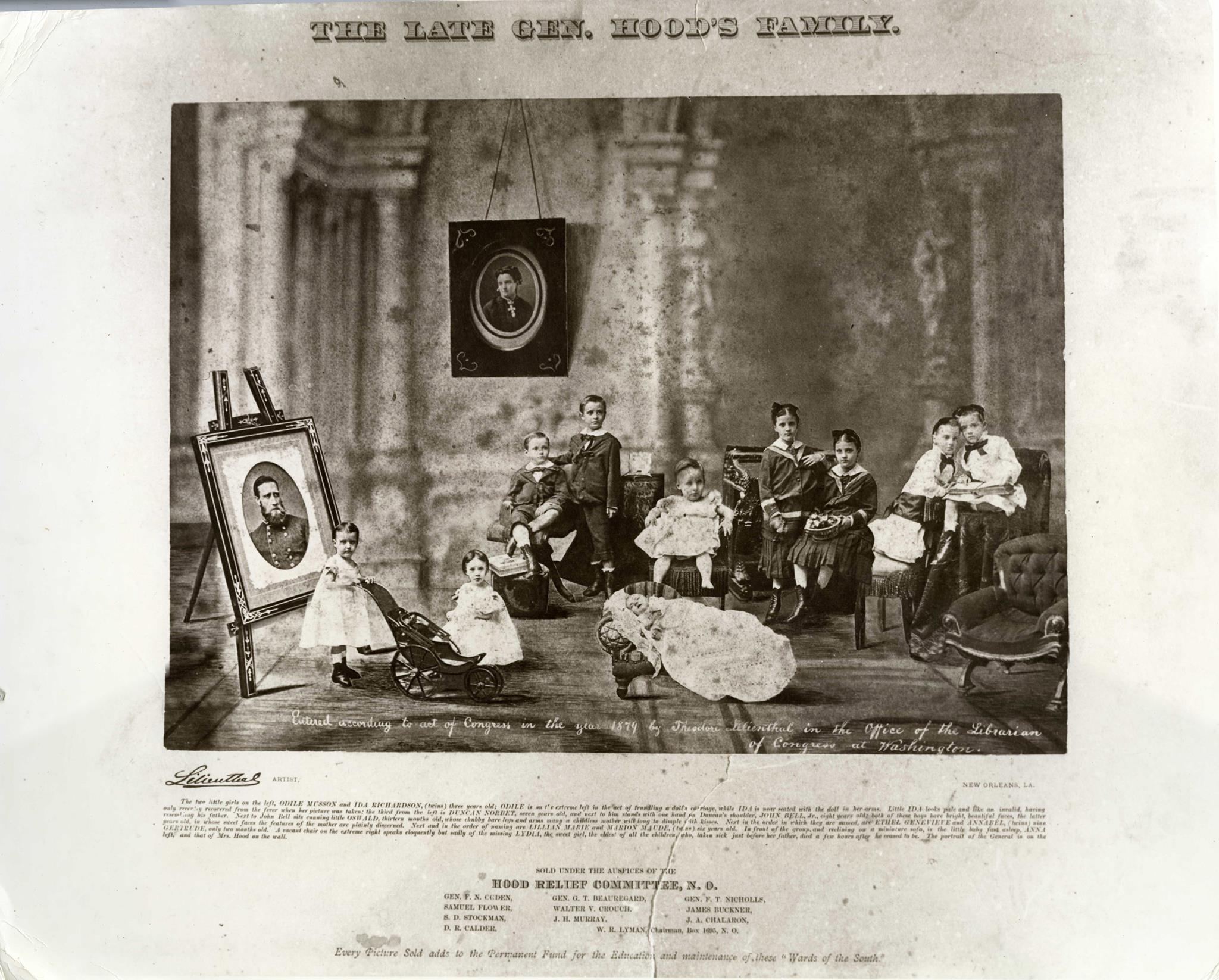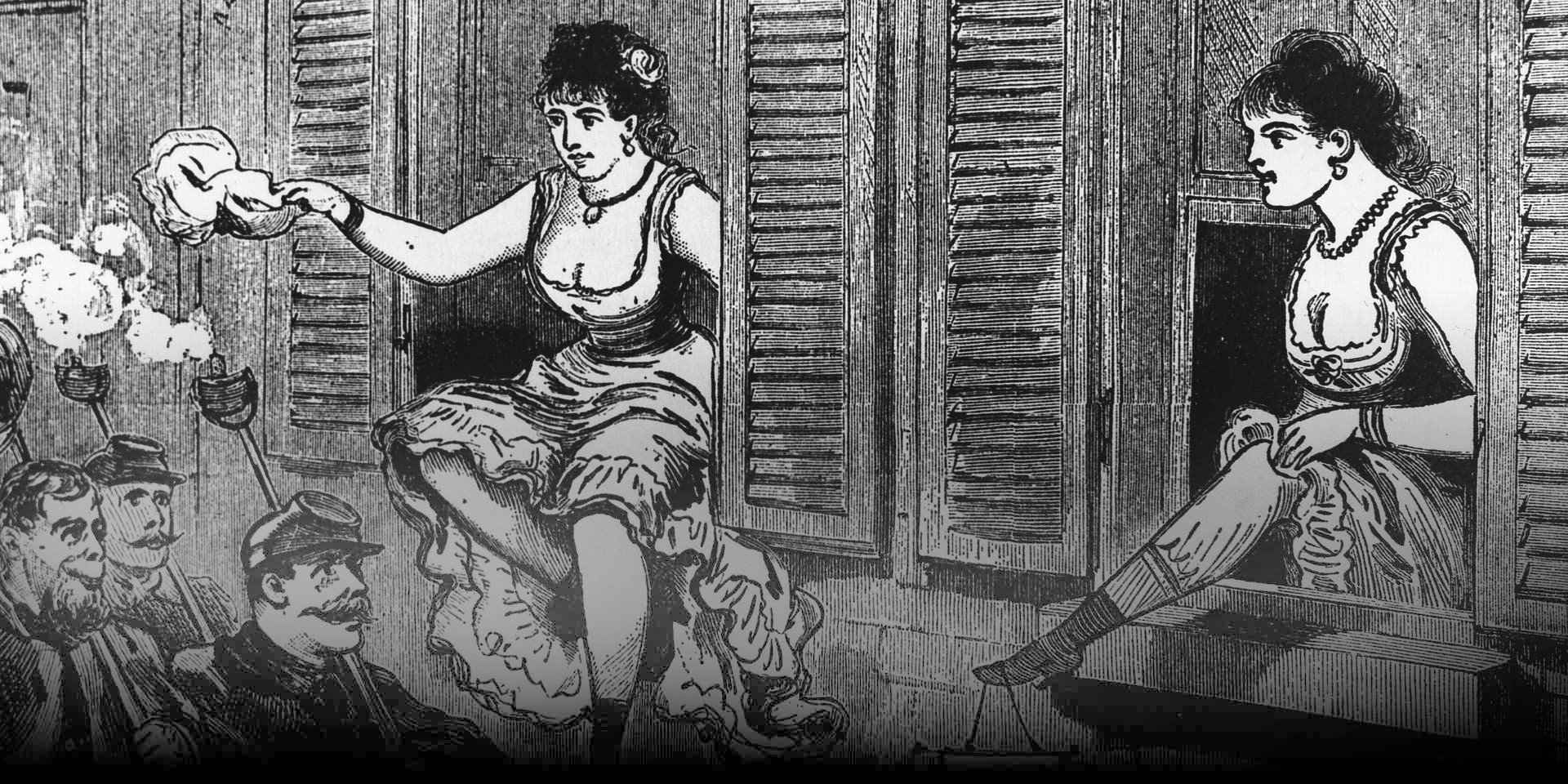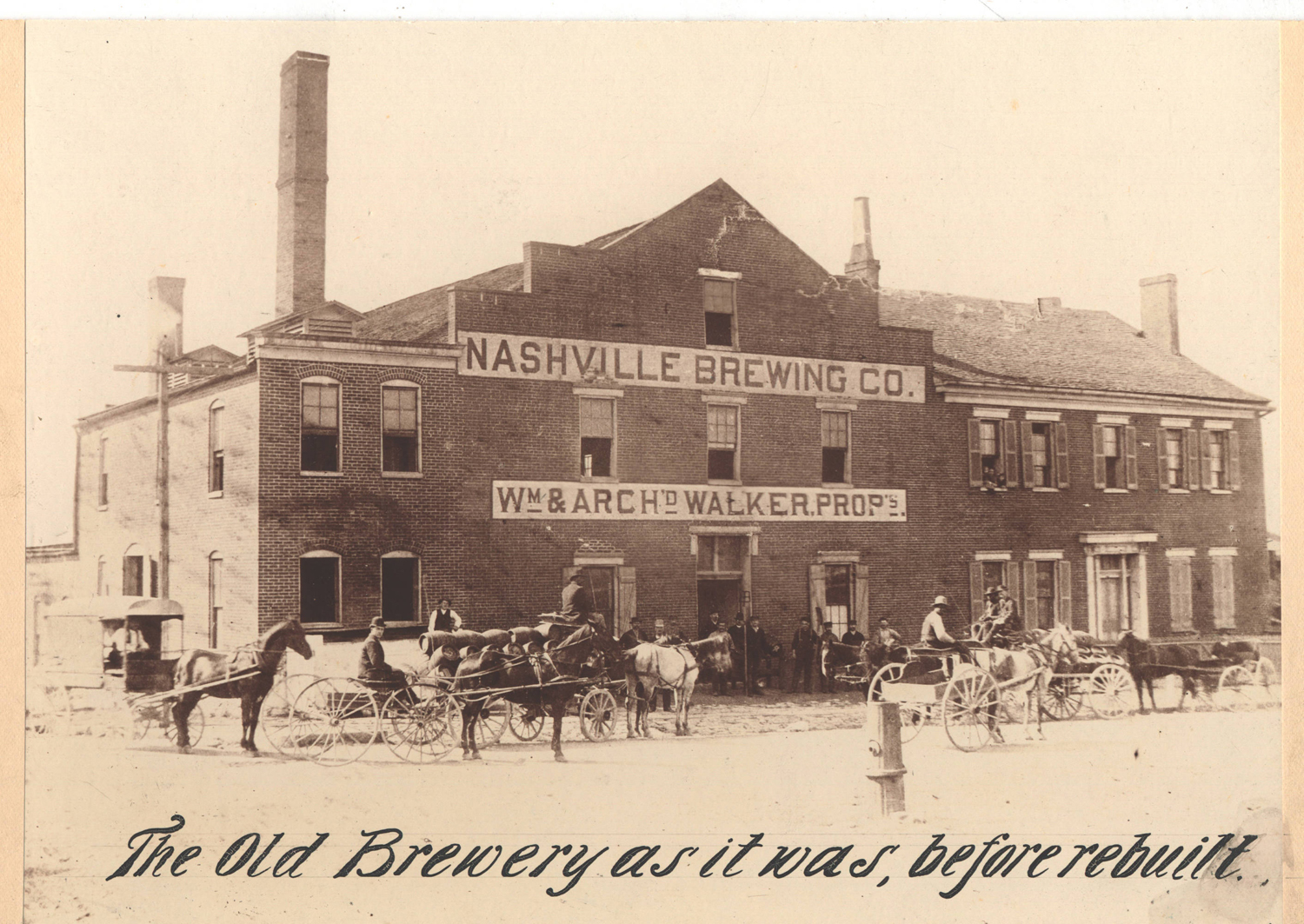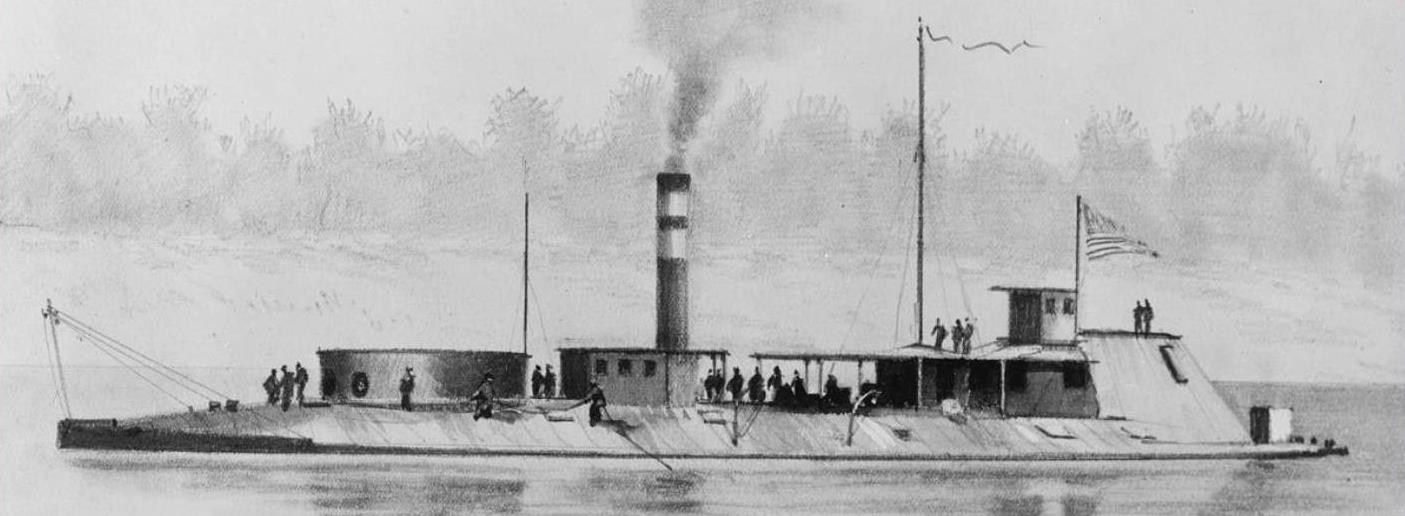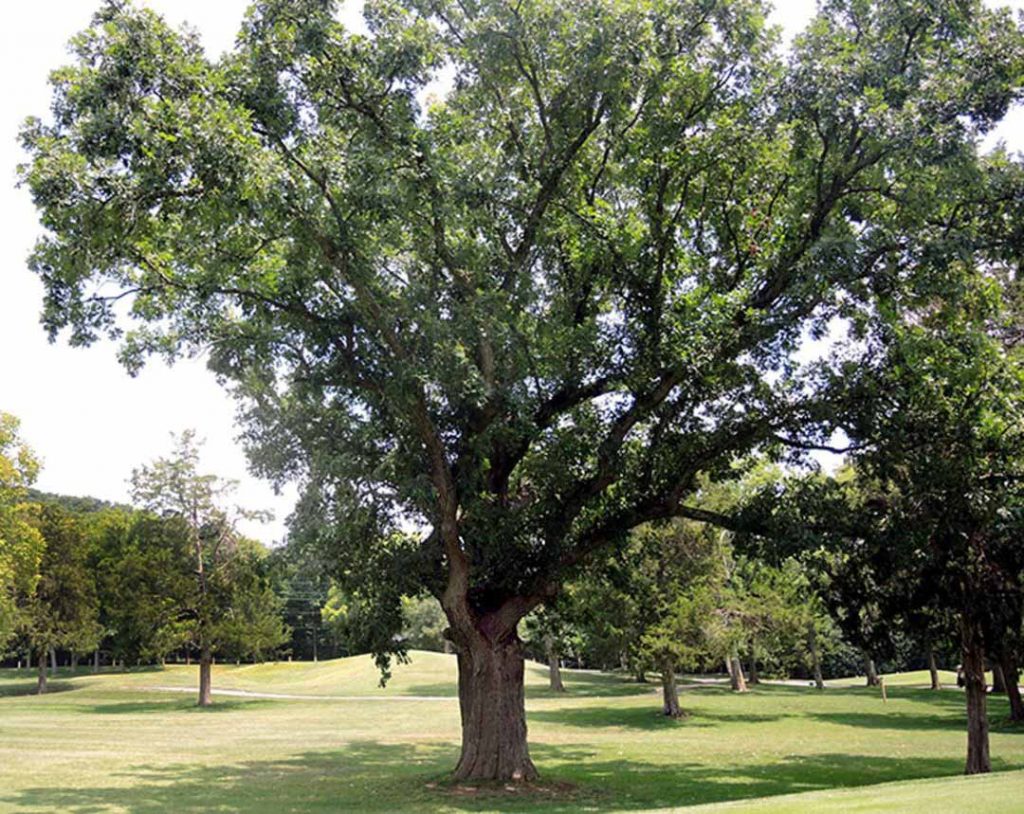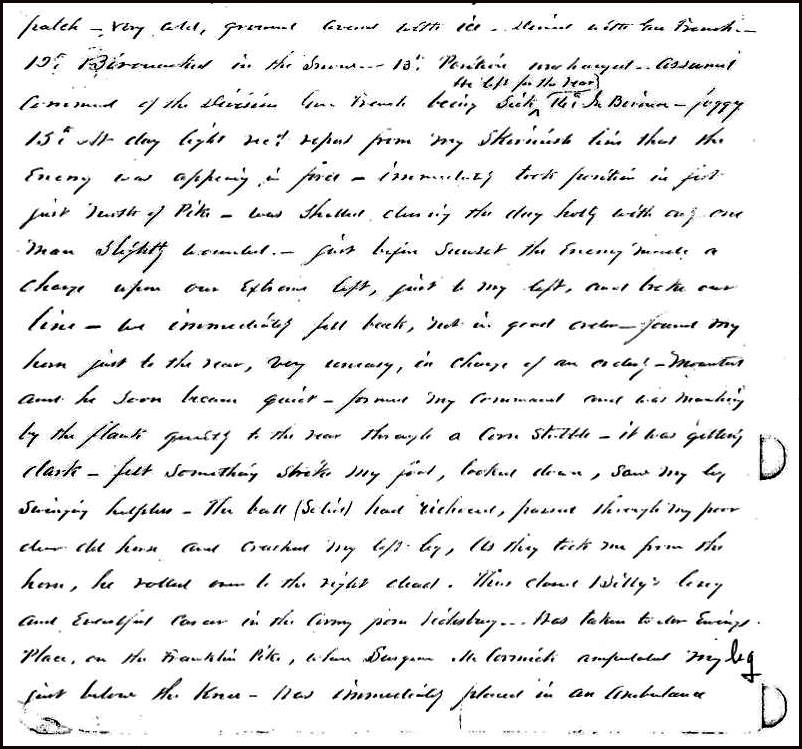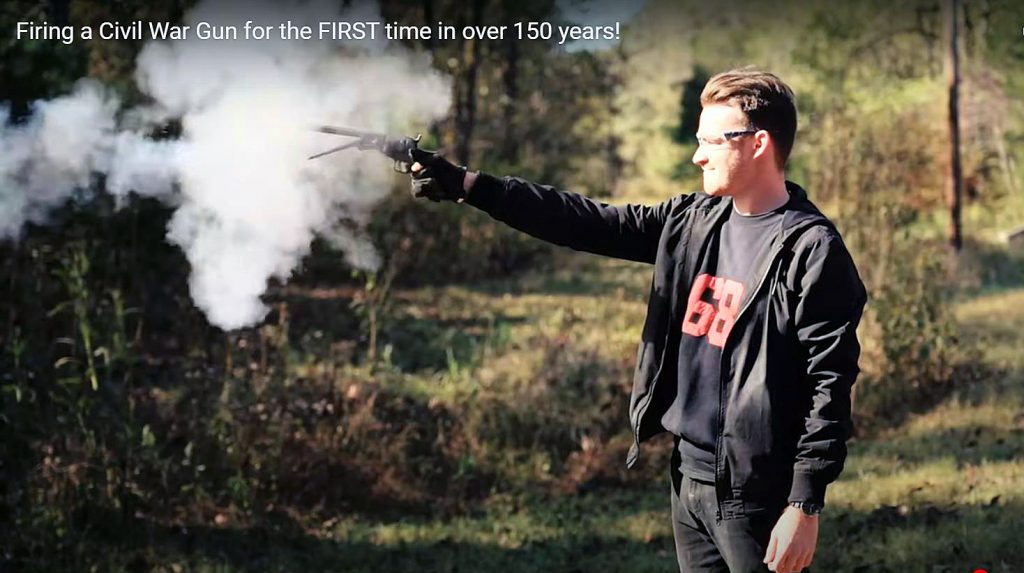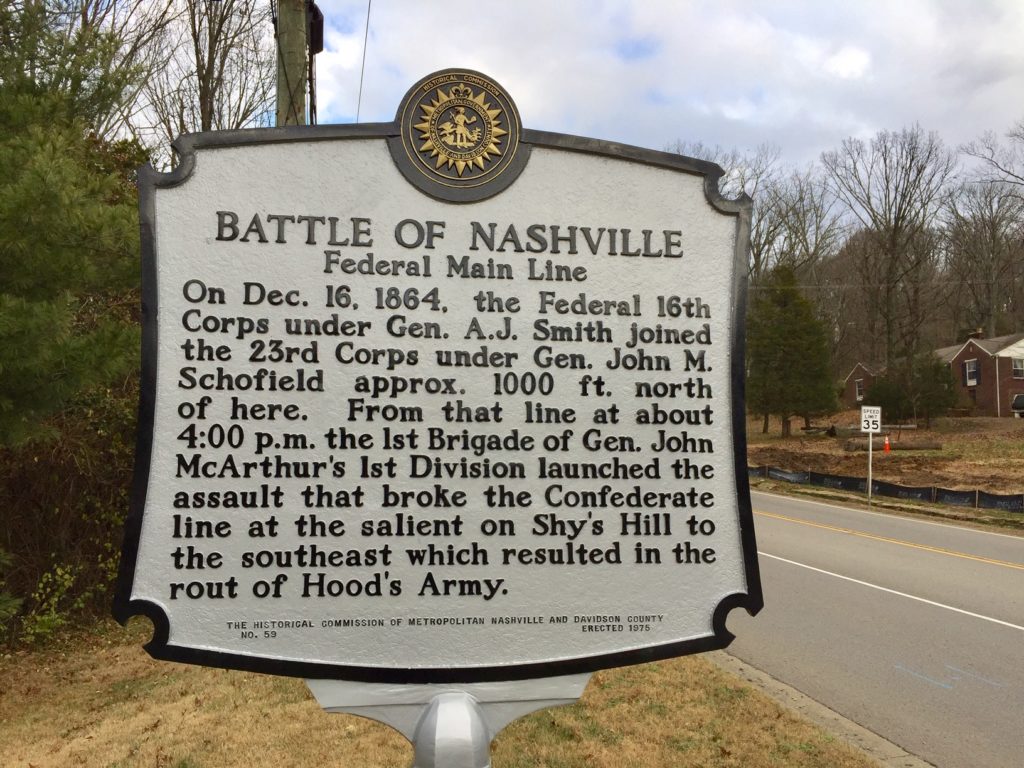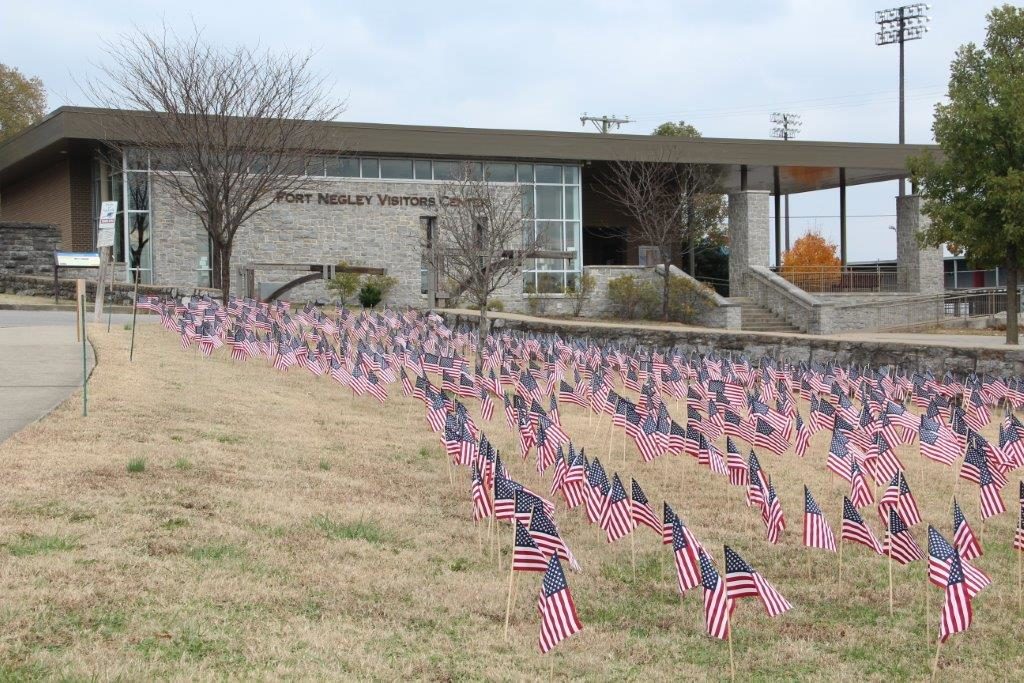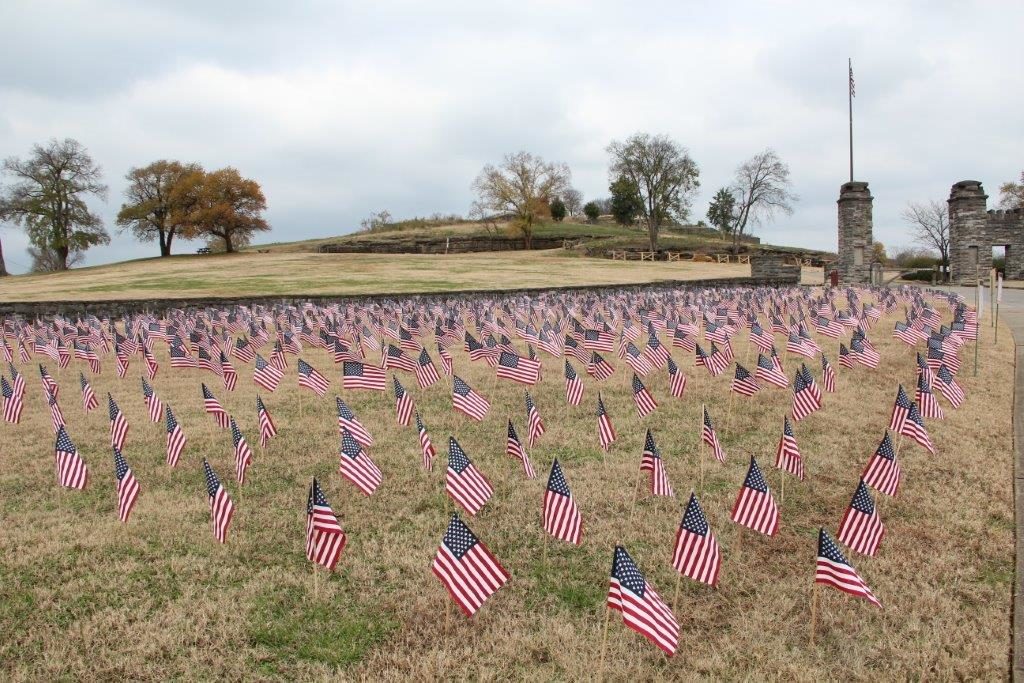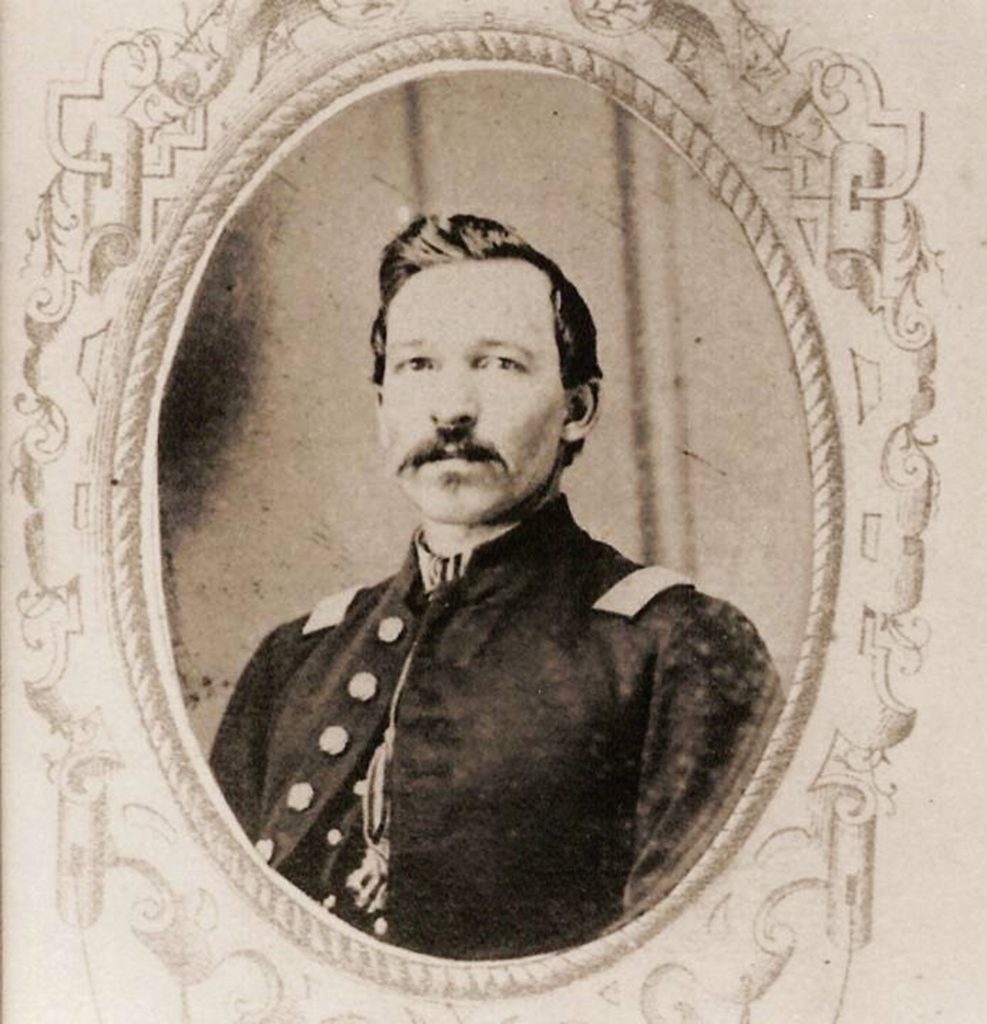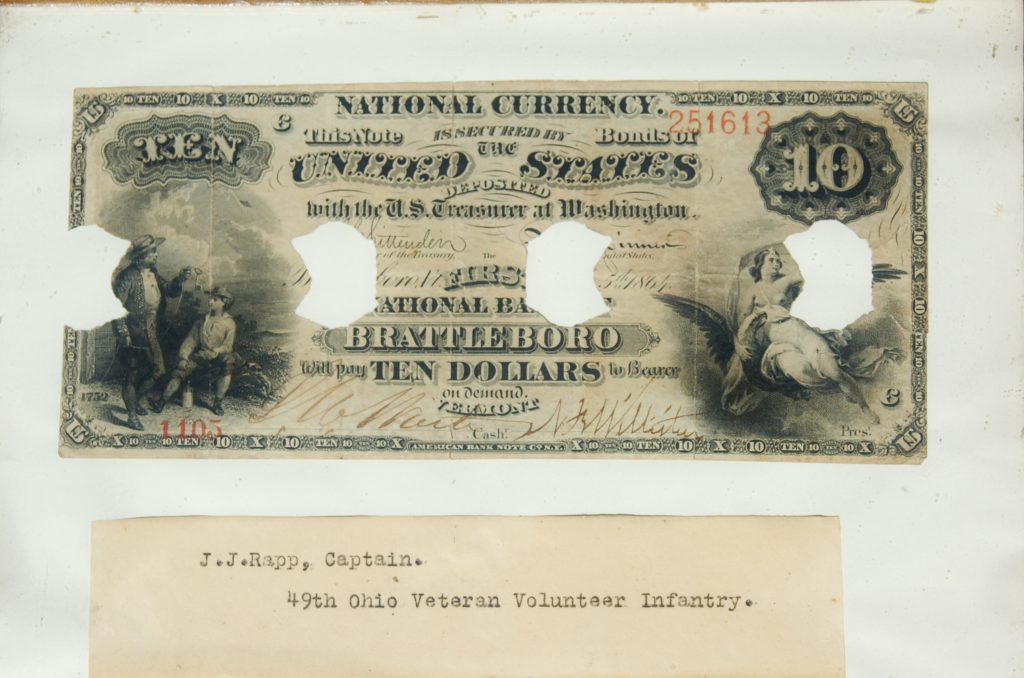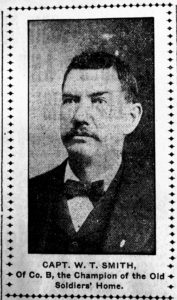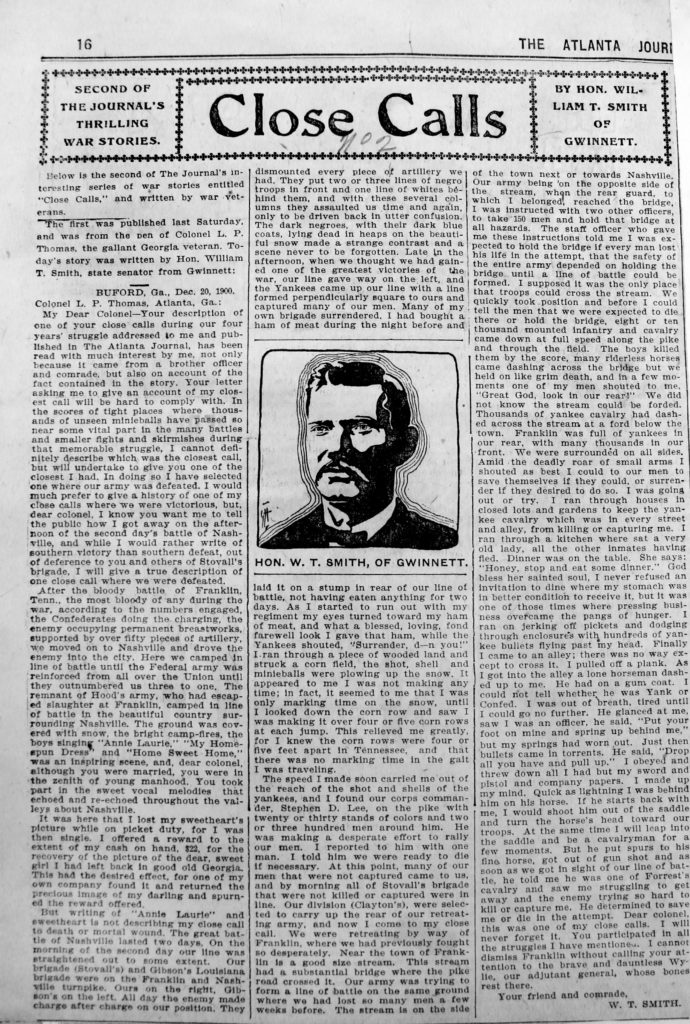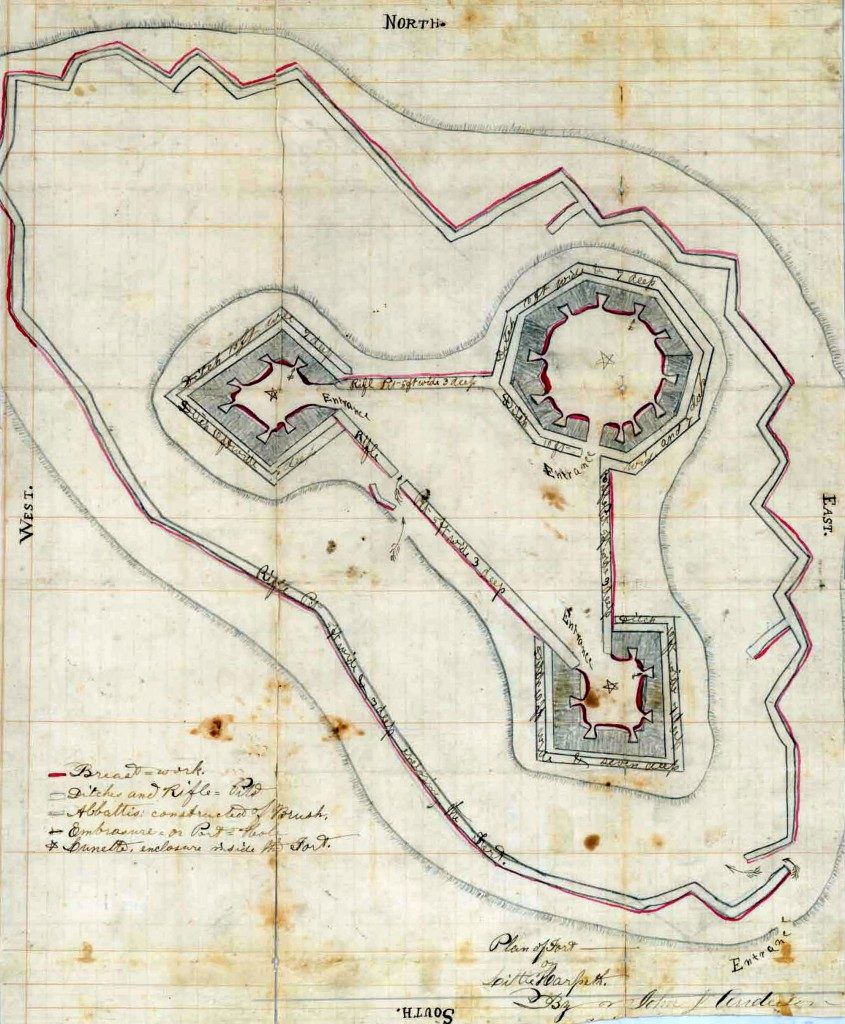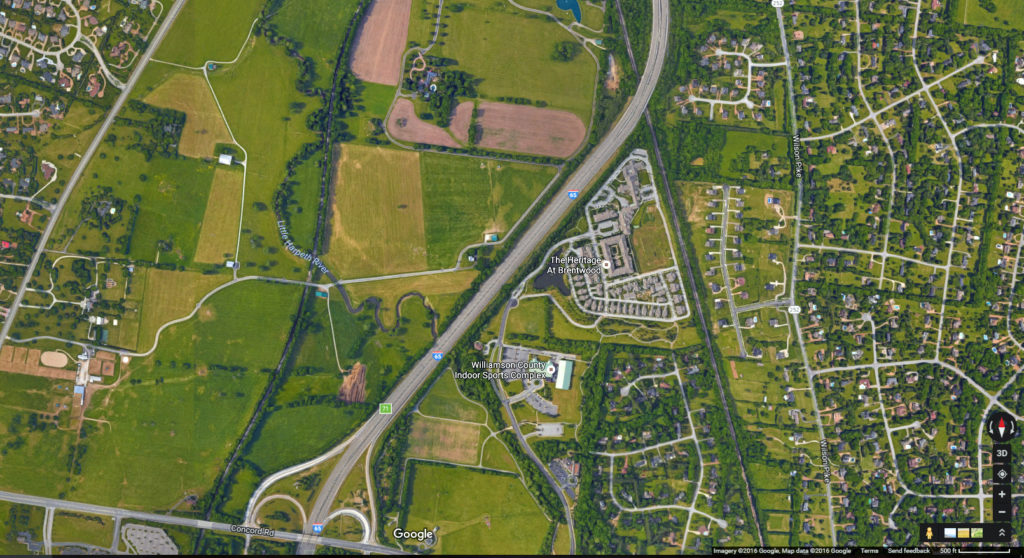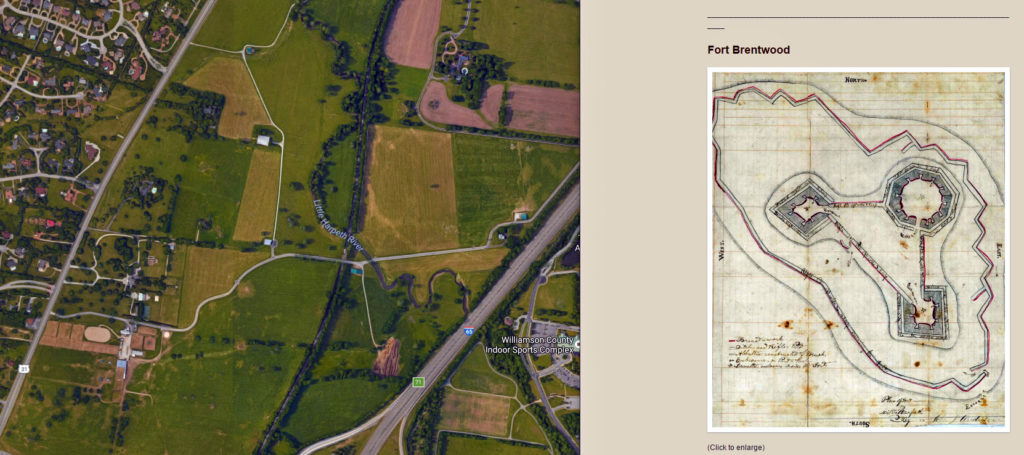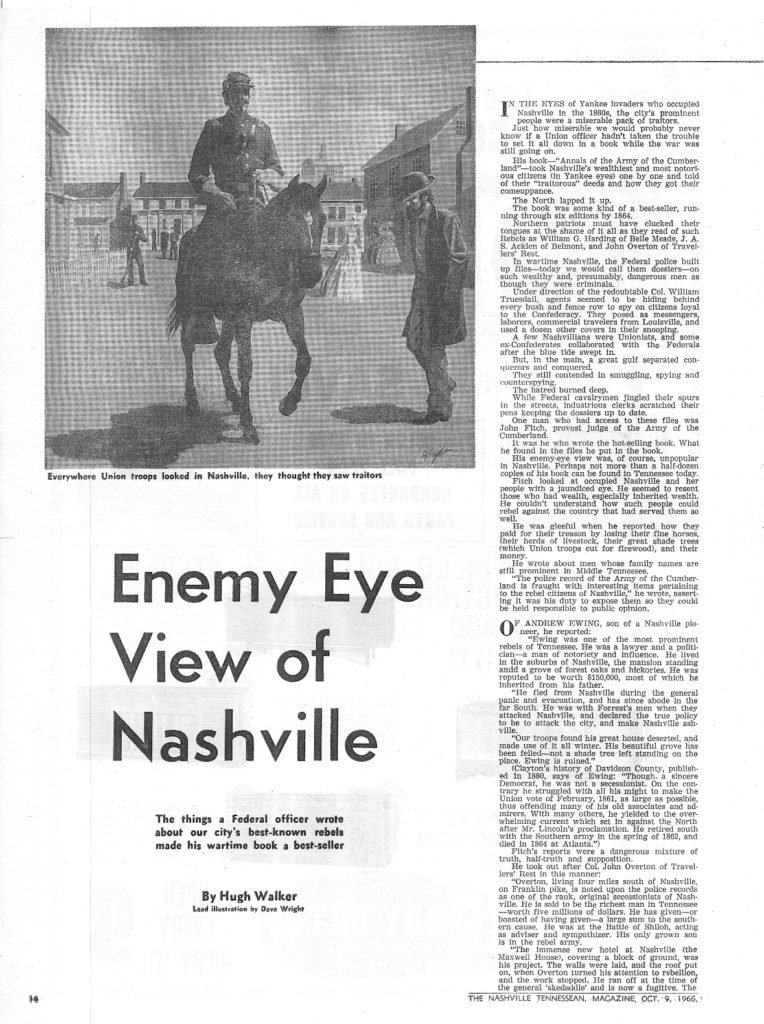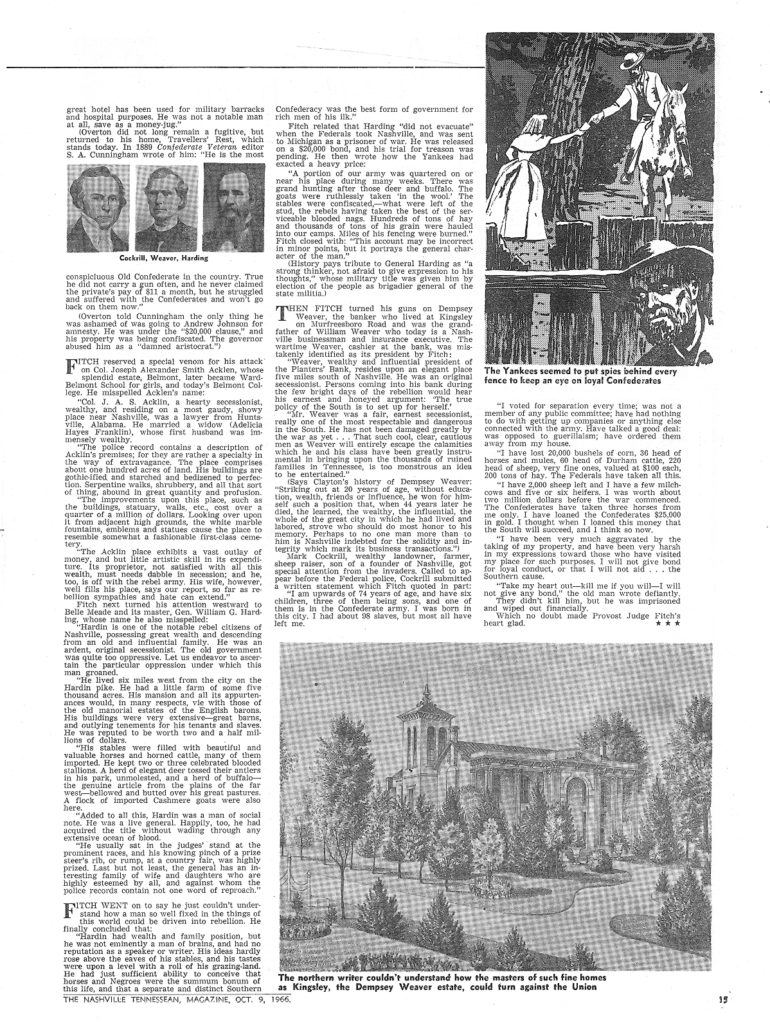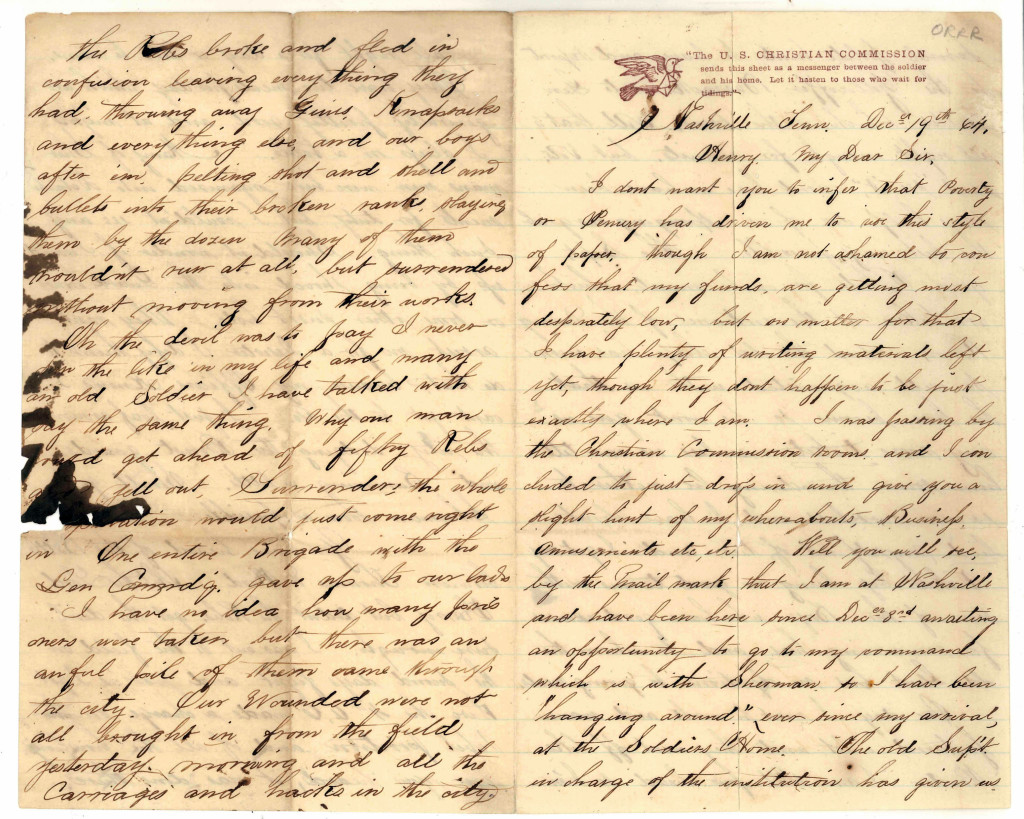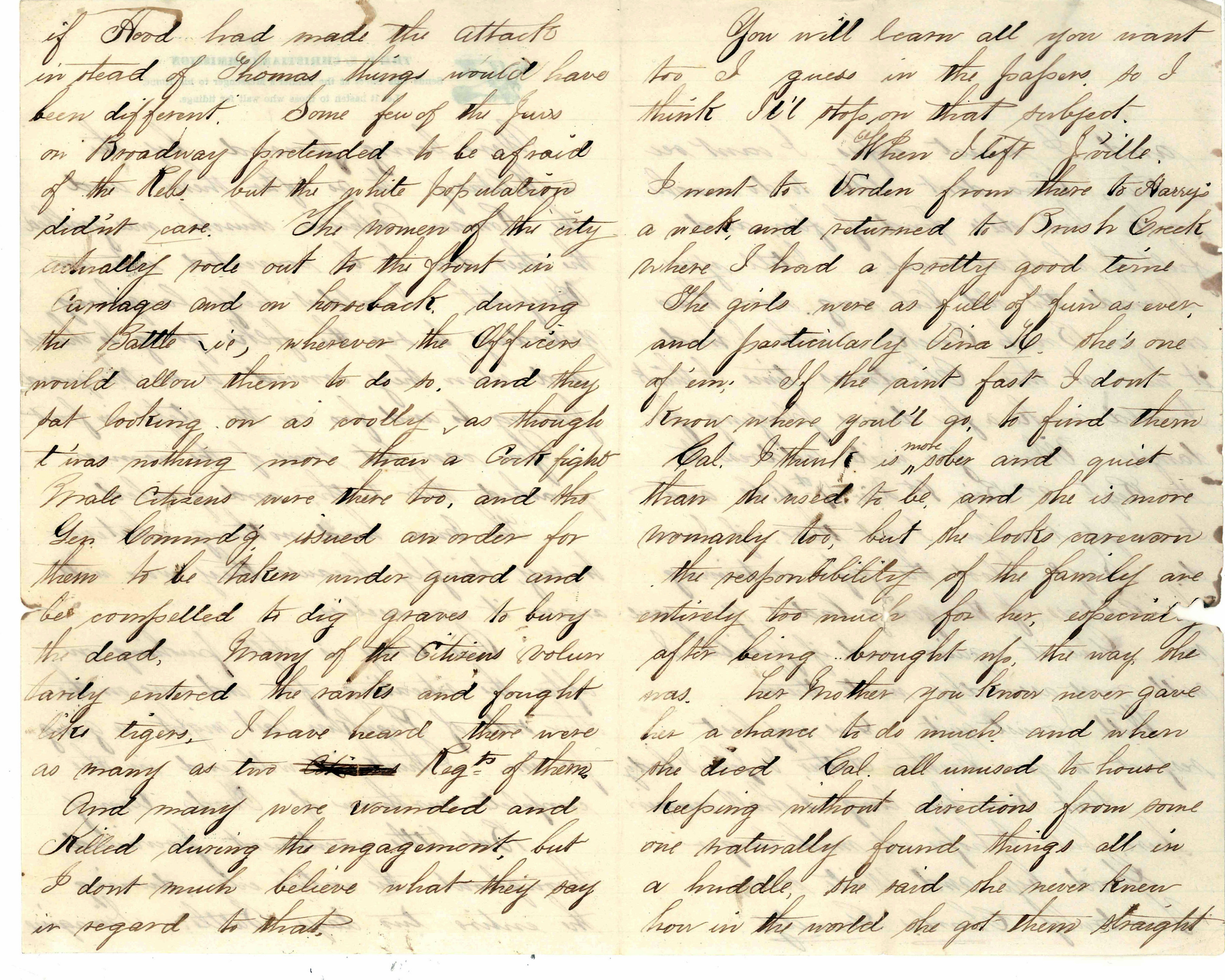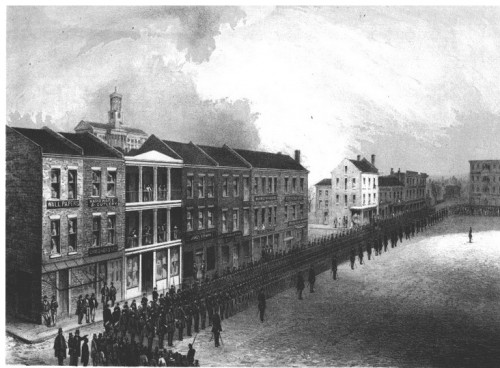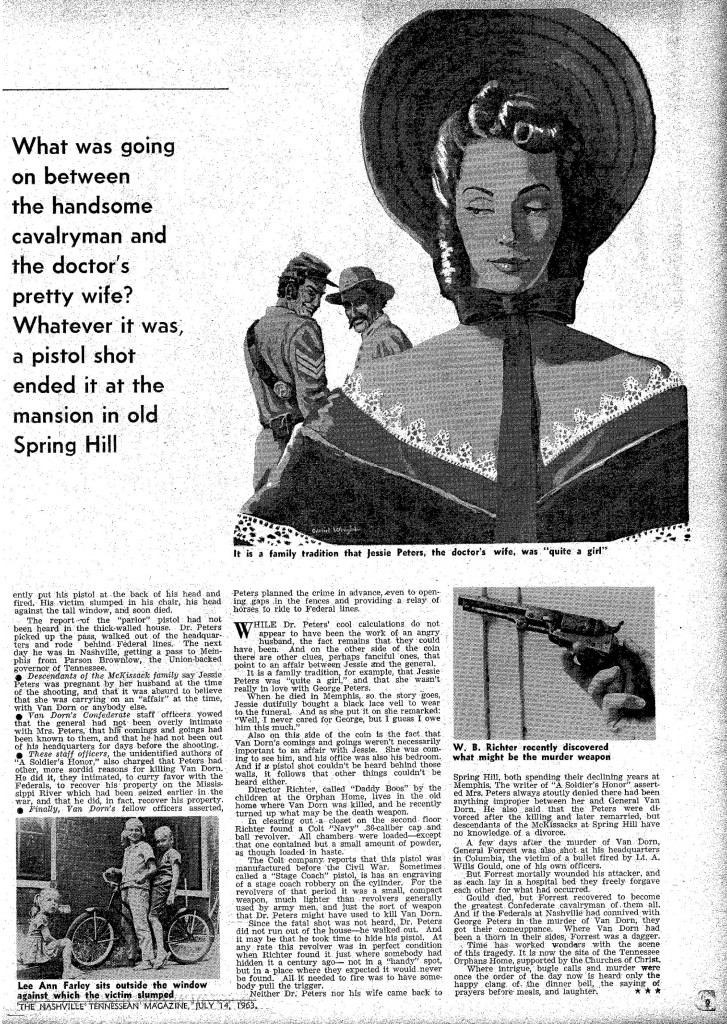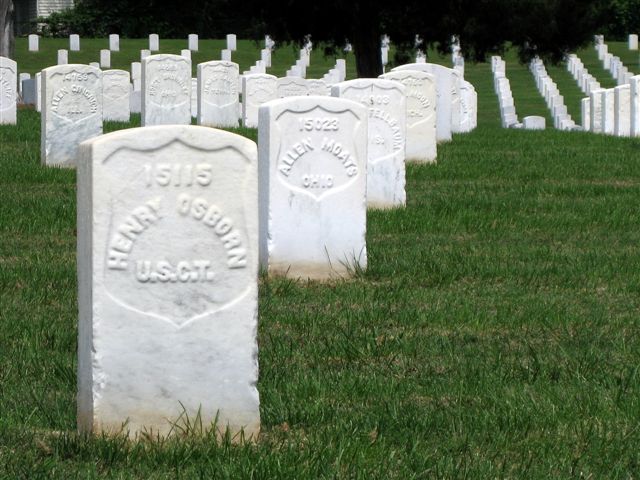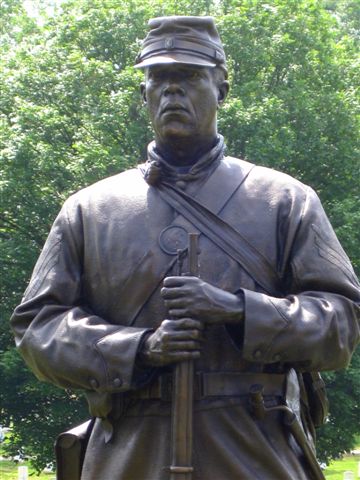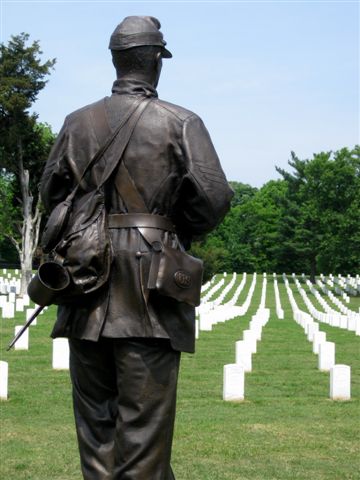February, 2025
PANORAMIC SKYVIEWS OF NASHVILLE BATTLEFIELD FROM DRONE PILOT JOHN BANKS
John Banks, Civil War historian, author, and blogger, has become an accomplished drone pilot recently and has been providing his popular Blog pages as well as the Battle of Nashville Trust with some remarkable sky-high photos of iconic parts of the Nashville Battlefield. Below are a couple of John’s panoramic views shot from his three-gimbal pano camera mounted on his latest drone, far above ground that was a raging scene of Civil War mayhem on Dec. 15-16, 1864. Anyone interested in the Battle of Nashville, or the Civil War in general, should make a regular habit of checking in with his “John Banks Civil War Blog” and its Facebook page.
Below: Panorama view shot directly above Confederate Redoubt No. 1 on Benham Avenue. For a large and more interactive view, click on the image to see more detail from John’s Blog page. Suggestion: scroll down to the artillery pieces on the Redoubt’s earthern North wall and scroll upward to see the cannons pointing towards the city of Nashville in the distance. On Dec. 15, 1864, shelling was aimed at Confederate troops in this fort from the huge guns at Fort Negley. Scroll to the left, around to Woodmont Christian Church (the very tall slender steeple to the southwest) to scan the area from which Federal troops came to overrun Redoubts 3, 2 and finally No. 1 on the afternoon of Dec. 15. And finally, scroll in the opposite direction of the Redoubt’s cannon barrels to see the distant hills which would become the battlefield on Dec. 16, including famous Compton’s Hill, later known at Shy’s Hill as it is today.
Below: Panorama view shot directly above Shy’s Hill. Again, for a large and more interactive view, click on the image to see more detail from John’s Blog page. Suggestion: scroll down to inspect the summit of the Hill, and locate the BONT trail which winds down the east slope of the Hill to the trailhead on Benton Smith Road. From there, scroll to the left and look north for a major roadway, Harding Place (which generally tracked the Confederate line at that time), and above it, the skyline of Nashville is visable in the distance. Slighty farther to the left of the city is the Green Hills Mall and shopping district. Continue scrolling left to the west and southwest to see the hills on which the remainder of the Confederate left flank were strung out towards present-day Tyne Blvd.
August, 2024
POINT OF VIEW: THE NASHVILLE BATTLEFIELD FROM THE PERSPECTIVE OF AN ARTILLERY SHELL
Civil War blogger, author and historian John Banks has a new hobby which is giving battlefield terrain a new look – from 399 feet above.
Or at least, that’s the maximum birds-eye-view that his Ruko F11 Pro drone can fly, and one of his first flights took its camera over Shy’s for a view never before seen (by humans) of this Battle of Nashville landmark. Think of it as what a Union Hotchkiss shell may have seen on Dec. 16, 1864. To watch his flight over the Hill below as you imagine what it must have looked like in late, misty afternoon of Dec. 16, 1864, click either image above.
He has since added the hawks-eye-view to photos of BONT’s other signature property, Confederate Redoubt No. 1, as seen in mid-August, 2024.
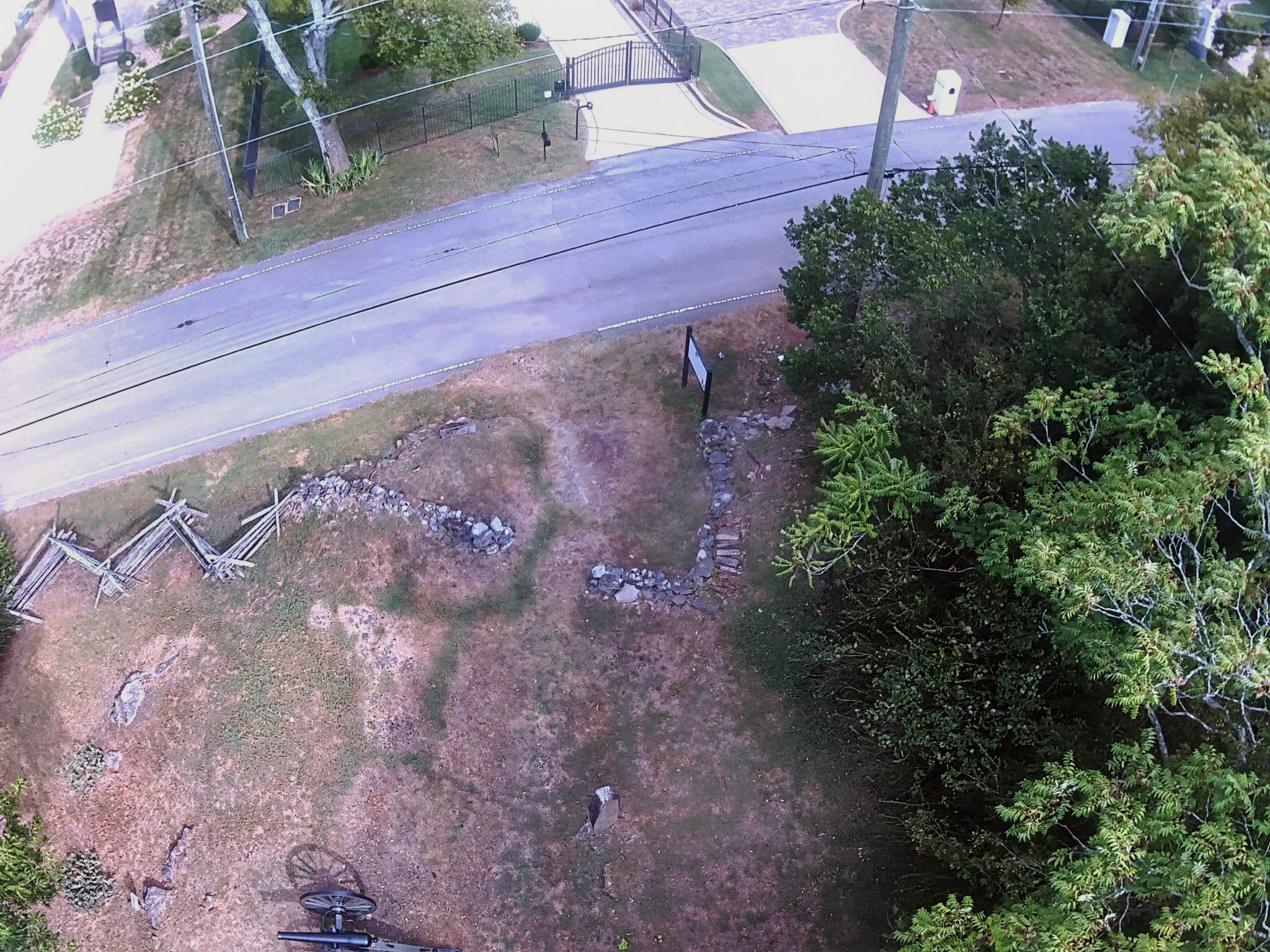 And finally, to cap off his fly-overs, he added a few aerial still photos and video of Fort Negley depicting its classic star design and proximity to the city of Nashville. To see the video, click on the photo below.
And finally, to cap off his fly-overs, he added a few aerial still photos and video of Fort Negley depicting its classic star design and proximity to the city of Nashville. To see the video, click on the photo below.
In conjunction with his postings on John Banks Civil War Blog, he is expanding his sky-lens views to other historic locations related to the Civil War, including Ashwood Hall, site of Polk brothers’ mansion destroyed by fire in 1874; Bethel Place plantation near Columbia in Maury County, TN; and Fort Granger in Franklin.
December, 2023
THE DEADLY ENEMY THAT HOOD COULD NOT SURVIVE
The Lower Mississippi Valley suffered a deadly Yellow Fever epidemic in 1878, and among the estimated 20,000 deaths left in its wake was a victim central to the history of the Battle of Nashville — Gen. John Bell Hood.
After his surrender and parole in May, 1865, Hood eventually moved to New Orleans. After swapping his uniform for a suit, he entered the business world as president of an insurance company, and was involved in the cotton brokerage business. In 1868, he married a 19-year-old woman from a prominent Louisiana family, Anna Marie Hennen. He and Anna had 11 children in 10 years (including 3 pairs of twins).
When he was 48 years old, the Yellow Fever epidemic erupted in river towns along the Mississippi River, causing commerce as well as normal life in those cities to shut down. Thousands of citizens fled to escape the epidemic. Hood and his family withstood the epidemic through 1878, moving out of the city for a time, but upon their return, Hood, his wife Anna and his eldest daughter Lydia all contracted the virus and died within a week of each other in August, 1879.
Retired U.S. Army Maj. James D. Campbell Jr. [Editor’s note: Maj. Campbell is related by marriage to BONT historian and board member Jim Kay] has written a piece for The Military Review, the professional Journal of the U.S. Army, that describes the devastating impact of the epidemic on Memphis and other river towns, and how the U.S. Army mounted a risky mission to bring them relief.
Entitled “A Mission of Mercy Amidst Terror, Death, and Despair: The Story of the National Relief Boat in the Great Yellow Fever Epidemic of 1878,” (May-June, 2022), Campbell notes the similarities between the Yellow Fever Epidemic and the 2020 coronavirus pandemic, though the former impacted a smaller region. His description of the Army’s high-stakes relief effort not only illuminates the widespread devastation that brought the Mississippi Valley to a halt in 1878-79, and but also provides an insight into the uncontrollable disease which took the life of Gen. Hood, a West Point soldier and officer who until then had survived a 12-year military career of close calls on the battlefield including the loss of an arm and amputation of a leg.
The remarkable photograph above shows the 10 remaining children of John Bell and Anna Hood, made by the noted New Orleans photographer Ted Lilienthal in 1879, and was produced as part of the effort to support the Hood orphans. Note that the children are accompanied by portraits of their late parents, and an empty chair to the right, representing the place for their missing eldest sister, Lydia. The photo was sold for the benefit of the “Hood Relief Committee,” which notably included Gen. P.G.T. Beauregard. The notation at the bottom states: “Every Picture Sold Adds To The Permanent Fund For The Education And Maintenance Of These “Wards Of The South.”
Nov. 14, 2023
THE DIRECT-DESCENDANT GRANDDAUGHTER OF A CONFEDERATE SOLDIER WALKS IN HER ANCESTOR’S FOOTSTEPS ON SHY’S HILL
Editor’s note: Meredith Whitson, a senior at Ensworth High School in Nashville, was inspired to write this narrative essay after her father, BONT board member Bobby Whitson, took her and some of her classmates to the battlefield where her ancestor had fought 159 years before. Pvt. George W. Vaughn, Co. H, 20th Tennessee, hailed from Williamson County and was with his unit, commanded by Col. William Shy and Brig. Gen. Thomas Benton Smith, on Shy’s Hill on Dec. 16, 1864. Pvt. Vaughn, 37 at the time, had already been wounded twice (at Murfreesboro and Chickamauga) before Nashville. He was captured in January, 1865, and returned to farming and the home near Leipers Fork, TN, where he had left his two young daughters and wife when he enlisted in 1861. Meredith’s family is steeped in Civil War legacy, with two other Confederate soldiers also on the family tree: Thomas J. Alford, Co. E, 45th Tennessee Infantry, Rutherford County, and James D. Summars, Co. C., 22nd Tennessee Cavalry, Cannon County. Below are her thoughts on walking the ground where her 4th-great-grandfather went to war, and where others died, in the Battle of Nashville.
By Meredith Whitson
Those who fail to learn from the past are destined to repeat it. Studying the past is vitally important to understanding how we got to where we are today. By doing so, we can appreciate the sacrifices of those who came before us. The sad fact is that my generation, some of whom were born and raised in Tennessee, have no idea that the routes they take to school, home, shopping, etc. every day traverse the exact grounds their relatives were fighting on 159 years ago. They have no idea that their house is sitting on a Civil War campsite, a battlefield, or even the spot where a soldier lay in his dying moments.
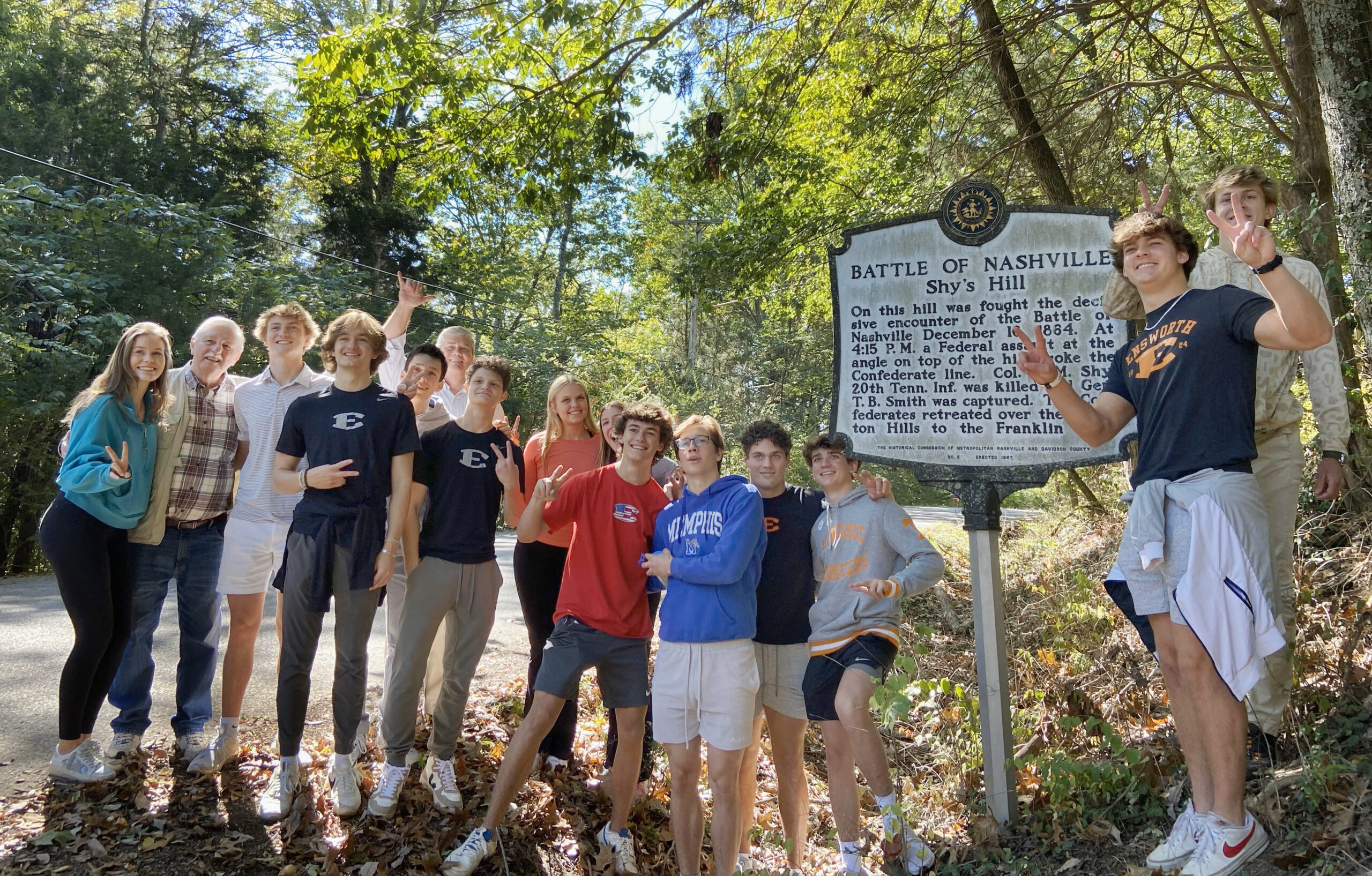
Ensworth students finishing tour of Shy’s Hill. L-R, Meredith Whitson, History teacher David Chanaca, Simon Heering, Braden Cooke, James Johnson, BONT board member Bobby Whitson, Nolan White, Lola Bird, Ruthie Clements, AJ Dale, Harry Phillips, Grier Short, Nathan Sadler, Peter Darst, and Grant Watts (click to enlarge)
That is why on October 10th, 2023 seeing the eyes of my classmates light up when standing on Shy’s Hill while Mr. Whitson had them stand in a line so that they were looking down as if the Federal troops were attacking up the hill as they did on December 16th, 1864, has such an impact on us that respect our history so much. The fact that these kids got to understand, hear stories, and see visuals of how important not only the Battle of Nashville was, but Nashville’s role as a whole in the Civil War was, is so important.
Someday everyone who is teaching the real history of our state will die and their knowledge will leave with them, and that is why it is so important that we [my generation] start taking in this knowledge of our elders and writing it down; because, we are the ones who must carry it on, but we must start absorbing this knowledge now; because, if we don’t, then who will?
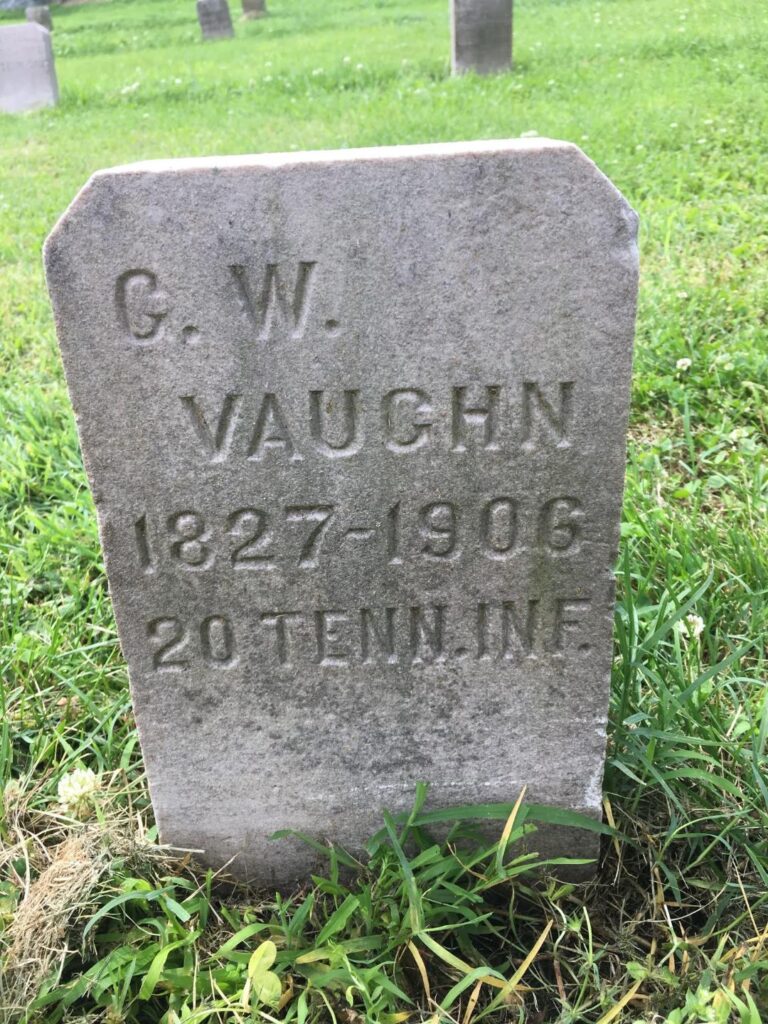
Headstone of George W. Vaughan of the 20th Tennessee, who died in 1906 at the age of 79. The grave is located in the former Confederate Soldiers Home cemetery in Hermitage, TN.
As the 18-year-old boys in my grade truly started to realize that the boys fighting in the Civil War were their age, the level of engagement increased intensely. As my peers learned, many of them who live in the area just around Shy’s Hill can pick up a metal detector and simply search in their backyards for bullets, buttons, artillery fragments, etc., that their relative or someone in their relative’s regiment could have fired/dropped. They had no clue that the boys from the 20th Tennessee and other Tennessee regiments who were fighting on December 16th, 159 years ago, came from where they are from, including Williamson County, Davidson County, Wilson County.
The fact that they now will go home and research their past and be able to drive past the places they do every day, but now with a much deeper understanding and respect for the sacrifices of our ancestors, whether they are related to them or not, is exactly what our generation needs to kickstart our learning of the past and then to be able to pass it on to those who come after us.
I am so passionate about bringing this knowledge and growth of knowledge to my generation; because, I am a direct descendant of a young Williamson County man from the 20th Tennessee, George W. Vaughn. To many, knowing that you have direct relatives who sacrificed greatly during that time just becomes a cool fact, but for me, that understanding and appreciation instills within me a desire and a responsibility not just to live but to live greatly. I must carry on the legacy of my ancestors who fought and sacrificed for their families, for their communities, for their states, and for what they believed in, and to have that knowledge makes life for me so much more meaningful and valuable.
September, 2023
VISITOR TO BATTLEFIELD TAKES YOU ALONG FOR THE RIDE
The Battle of Nashville Trust works hard to acquire, maintain, and interpret parts of the Nashville battlefield for visitors to enjoy and explore, and occasionally, our visitors return the favor in a special way.
This past summer, James Cosgrove of St. Augustine, FL, not only visited the battlefield sites, but made a video of his impressions and thoughts along the way. He is an Army vet and firefighter who “loves all things military,” which led him to create “Project Past” in June, 2021. His intent was to tour battlefields and historic sites, and share his adventures on YouTube so that “we can better understand our country’s past.”
The photo below shows James at the Battle of Nashville Monument. Click on the photo to join him on his tour of the battlefield, and get a feel for how visitors to Nashville experience and understand the Battle. The video is a production of “Project Past” and is presented by BONT with permission.
June 16, 2023
CIVIL WAR NASHVILLE: POPULATION GROWTH BRINGS THE FLOURISHING OF INDUSTRY AS WELL AS PROSTITUTION
The occupation of the city of Nashville during the Civil War from 1862 to 1865 resulted in a huge surge in population, mainly from the military presence and related businesses, causing the city to experience tremendous change including the growth of industry as well as prostitution.
Brandon Hulette, a Vanderbilt professor and Board member of the Battle of Nashville Trust, has overseen projects by two of his Buchanan Fellowship students which illuminate both of these trends of the time. He was assisted by Stacy Curry-Johnson, Vanderbilt Librarian for Geospatial Data and Systems.
Student Riley Black explored the industrial revolution in Nashville, creating a map of the industries that arose in the city between 1860 –1889, ranging from the Nashville Brewing Company to James Morton’s United States Army and Navy Leg Company.
Student Cooper Donovan looked at one of the “seedier” stories of Nashville, focusing on the city’s efforts to combat uncontrolled outbreaks of venereal disease among Federal soldiers stationed here. The Provost Marshal of the time, Col. George Spalding, put in place a licensing system for the “public women” of the city, requiring prostitutes to register with the provost marshal, pay a licensing fee, and submit to weekly medical examinations in order to practice the world’s oldest profession legally without fear of arrest.
Both “story maps” reveal a glimpse of the Civil War in Nashville from a different perspective, away from the battlefield but equally as real to the population, and to history. NOTE: To view the stories, click on the images below.
Fancy Ladies: A mapped history of Nashville’s prostitutes
Cooper L. Donovan | Vanderbilt University
Industrial Change in Nashville During the Civil War
By Riley Black
December 15, 2021
1864 LETTER TO EDITOR DESCRIBES LIFE IN THE STREETS OF NASHVILLE ON THE FIRST DAY OF THE BATTLE, LAMENTS THE IMPACT OF THE WAR’S HUMAN TOLL
 John Banks, author and BONT board member, has unearthed this letter written by a person identified only by his initials, and published in the The Iowa Transcript, a Toledo newspaper, on Dec. 22, 1864 — a week after the Battle of Nashville erupted on the morning of Dec. 15, 1864.
John Banks, author and BONT board member, has unearthed this letter written by a person identified only by his initials, and published in the The Iowa Transcript, a Toledo newspaper, on Dec. 22, 1864 — a week after the Battle of Nashville erupted on the morning of Dec. 15, 1864.
It offers a snapshot of the frantic activity, tension, and rumors that filled the streets of the city on that Thursday, 157 years ago today. His topics range from a description of the frenetic military activity in the city — “a living mass of mules, dragontrains, battery wagons, infantry and cavalry” — to his thoughts on the Battle of Franklin, “Old Hood” and his army, and his opinion that newspapaers of the era were significantly under-reporting the human casualties of the Civil War.
Note: click the image of the article to enlarge it and read the letter as it was printed.
Nashville, Tenn.
Dec. 15th, 1864
Editor of The Transcript:
On the 29th of Oct., at this place by order of surgeon of Hospital 15, where I am now I was granted the pleasure of a short furlough for the purpose of recruiting my health and visiting my friends, many of whom I had not seen for a long time. My health recovered somewhat, and visit made, which was very agreeable, I then returned to Nashville where I found grand change in things since I was here before. It is not only a change to Nashville but to me quite a change. When I arrived in sight of the place the first thing I heard was a very heavy outburst of canonading which sounded very familiar although I don’t exactly admire the reality of it. Old Hood and his army are in our front and well intrenched some three miles south between us and Murfreesboro, and everything in the city looks as if something was going to be done soon. The streets are a living mass of mules, dragontrains, battery wagons, infantry and cavalry, but they are all moving to the front, therefore I don’t apprehend any danger in Nashville. A soldier just came up from the front says that old Hood and his ragged butternuts were coming to town to night. I told him that I could not see it in that light but if they do come to town he will come over more dead Yankee soldiers than he has live rebels in his own ranks.
This place cannot nor never will be evacuated. Its importance as a base of supplies is great. There was some fighting on our left yesterday and some skirmish firing today. They are cleaning out all the hospitals here and sick and wounded are being sent north as fast as possible; this also indicates an early engagement. Five days rations was issued to the troops here last night and that looks like fighting. Our army are in good condition and high spirits. I have seen and talked with a great many men and officers who were in the fight at Franklin, 23 miles from here, and they all agree that our loss in the fight was not less than twenty-five hundred, which would be five times as many as was at first reported. This is too often the case, that our losses are underrated.
Everyday we see in the newspapers our loss very slight, only one killed, five or seven wounded. Everyday the sunlight of some happy home is forever extinguished, a breach made in some family circle, a bright jewel stolen from the treasury of some fond mothers love, yes, every hour some one falls at his post of duty and is thrown from the ramparts of time into eternity. Only one, the careless reader scans the word without a pang. Only one? Who is this only one? Perhaps a boy in years, a mothers darling, a youth whose happy laugh was but yesterday as the gush of a summer rill in a bower of roses, whose young life was the happiness of an aged mother’s declining years or [unreadable] was one just entering manhoods years, hopeful and generous, whose brow was crowned with fresh laurels, and whose path was strewn with flowers, whose great soul panted to do great and noble deeds in his country’s defense, but that lion heart is still now. Victory will never light that bright eye or flush the bronzed cheek with joy again.
From your friend,
TWC
September, 2021
NEWLY-ACQUIRED PHOTOS SHOW HOW NASHVILLE BATTLEFIELD MAY HAVE APPEARED IN 1864
There are no known contemporaneous photographs of the Nashville battlefield where actual fighting occurred, but the Battle Of Nashville Trust has gained access to a small treasure trove of black and white photos that give us the best view to date of what the terrain looked like in 1864. (The best photographs taken on December 15-16, 1864, in Nashville can be viewed on our PHOTOS page.)
In 1899, 35 years after the Battle of Nashville, Dayton, Ohio, attorney and photography hobbyist Albert Kern came to Nashville to record images of the battlefield. It was one of many stops he made between 1890 and 1910 as he traveled the eastern United States, preserving Civil War battlefields in pictures.
Kern had not been a veteran of the war. He was 14 when hostilities began, and ultimately graduated from the University of Michigan Law School and became a successful lawyer in Dayton. His passionate interest in history and photography led him to his 20-year travels around the battlefields. He also wrote a book entitled History of the First Regiment Ohio Volunteer Infantry.
As can be seen clearly from the photos he made in Nashville, the geography of South Nashville had not yet erupted into the sprawling residential neighborhoods and shopping centers we see today. Instead, his images reveal fields, stone walls, split-rail fences, wagon wheel tracks on major roadways, and landscapes of places that are central to the history of the battle. As Kern’s 1899 photos show, Hillsboro Pike, Franklin Pike and Granny White Pike were still unpaved dirt or macadam roads, as they may have appeared in 1864 when each of them played a major role in the battle.
Kern, 1848 – 1925, used a form of dry glass plate photography to produce some 15,000 images, 13,000 of which depicted primarily battlefields. He had left the thousands of glass plates in his basement upon his death, where they remained untouched until 1971, when his three-story brick house in Dayton was sold to a doctor who planned to remove the plates for recycling. He made one phone call first, to the local historical society.
That call set off a chain reaction of historians reviewing the plates and ultimately realizing the immense historical significance of the images. Since that time, Kern’s photographs have been used in numerous historical settings, and especially by national battlefields and parks including Stones River National Battlefield, for the purpose of reimagining what the grounds looked like before – as in Nashville – the battlefields were virtually destroyed by urban development.
Kern’s plates ultimately became the property of The Montgomery County Historical Society in Dayton, which merged with the Carillon Historical Park in 2005 to become an umbrella historical entity for Dayton known as Dayton History, which owns the copyright on these images.
The Battle of Nashville Trust obtained permission to publish the 12 images of Nashville from the Kern Collection on this website. To get a more detailed perspective of the life and photographic history of Albert Kern, see the excellent article in the Baltimore Sun in 2002 entitled “Photos Show Early Views Of Civil War Battlefields,” by writer Jim DeBrosse.
The images are displayed below with their original captions. The Battle of Nashville Trust is in the process of having its historians review each photograph for the purpose of determining its importance in the battle, and its current location.
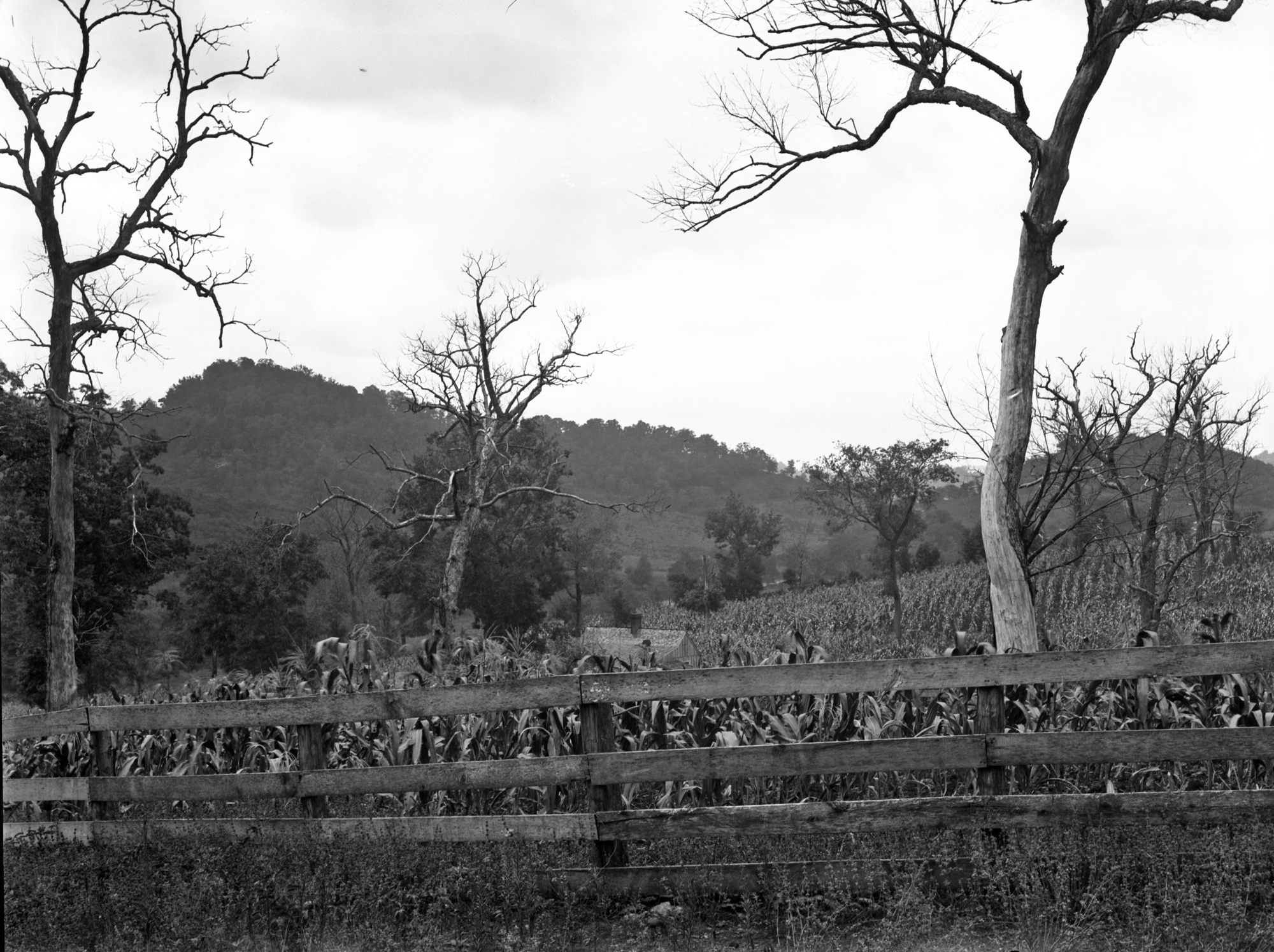
From the Collections of Dayton History. Copyright Dayton History. Title: “Stewart’s position – Hillsboro Pike” (Double click to enlarge)
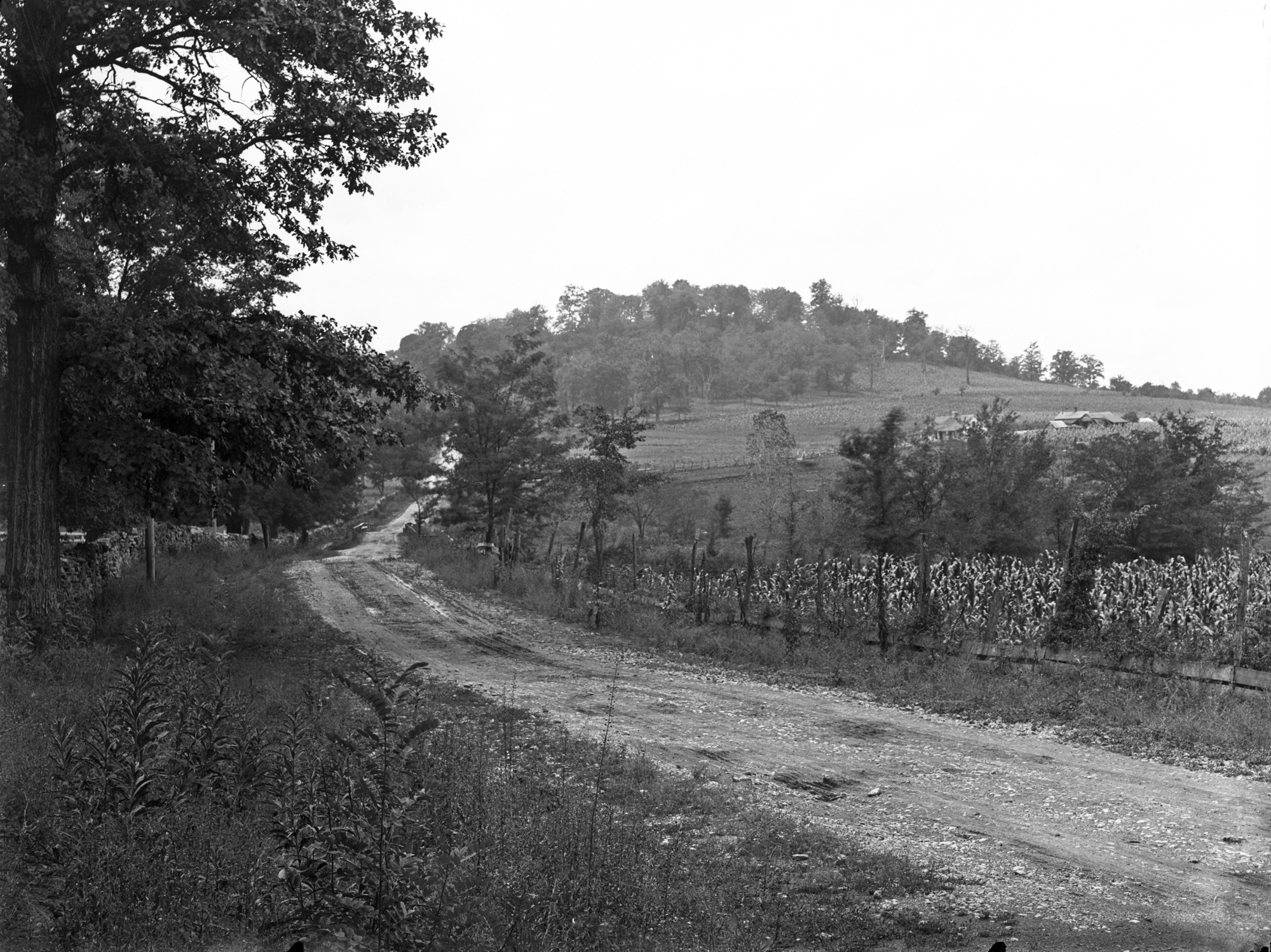
From the Collections of Dayton History. Copyright Dayton History. Title: “Hillsboro Pike where redoubt is” (Double click to enlarge)
The photo above shows Hillsboro Pike looking south from present day Green Hills shopping district. In the distance to the right is the high ground where Redoubt No. 5 was located. The redoubt has been obliterated but stood approximately where Jefferson Square gated community is today. BONT Board member John Banks has created a Then-and-Now comparison of the two views. His present-day photo was taken near the Hillsboro Pike-Burton Hills Blvd. intersection. Click Here and compare the views by moving the arrows on the center line .
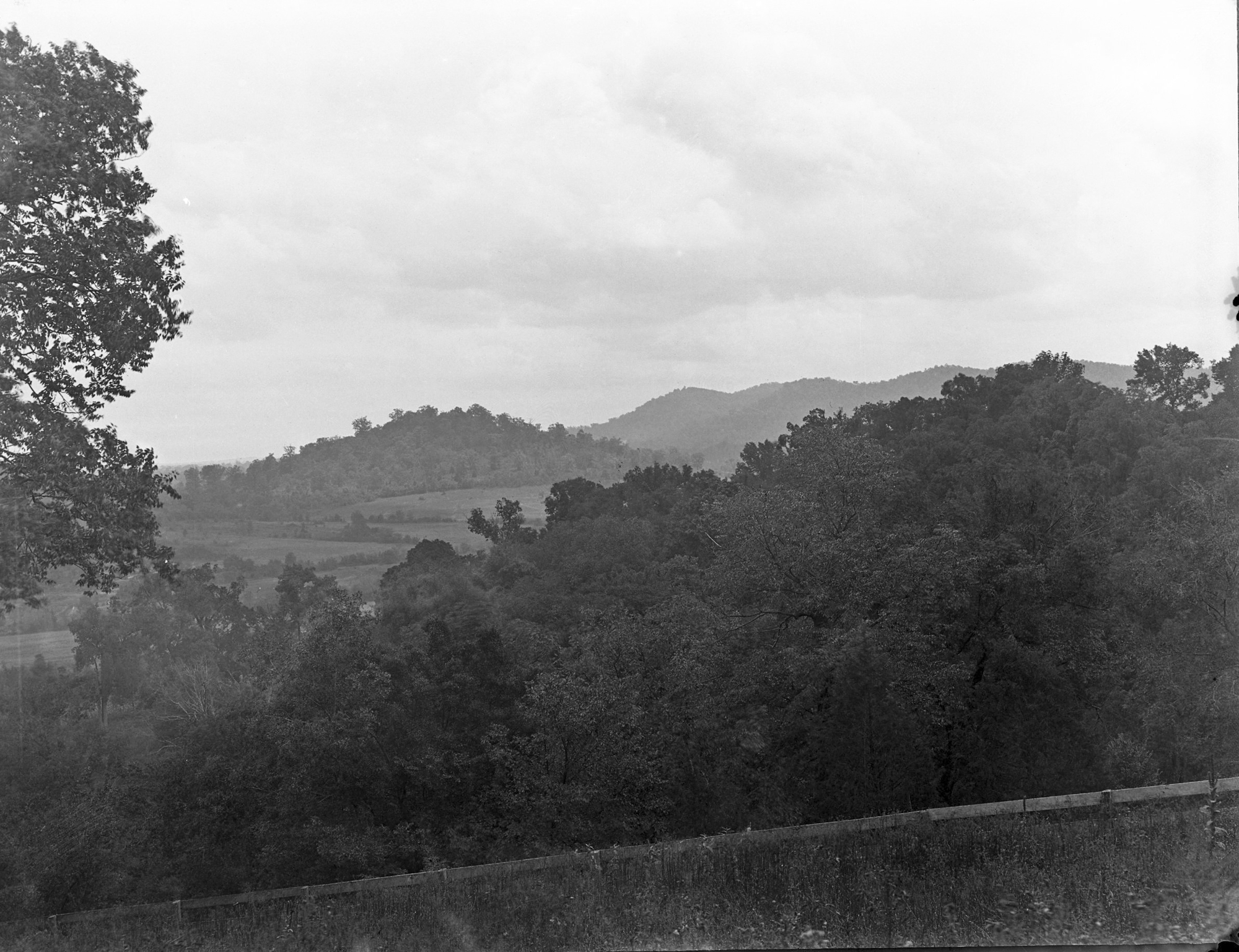
From the Collections of Dayton History. Copyright Dayton History. Title: “Overton Hills from redoubt on Hillsboro Pike” (Double click to enlarge)
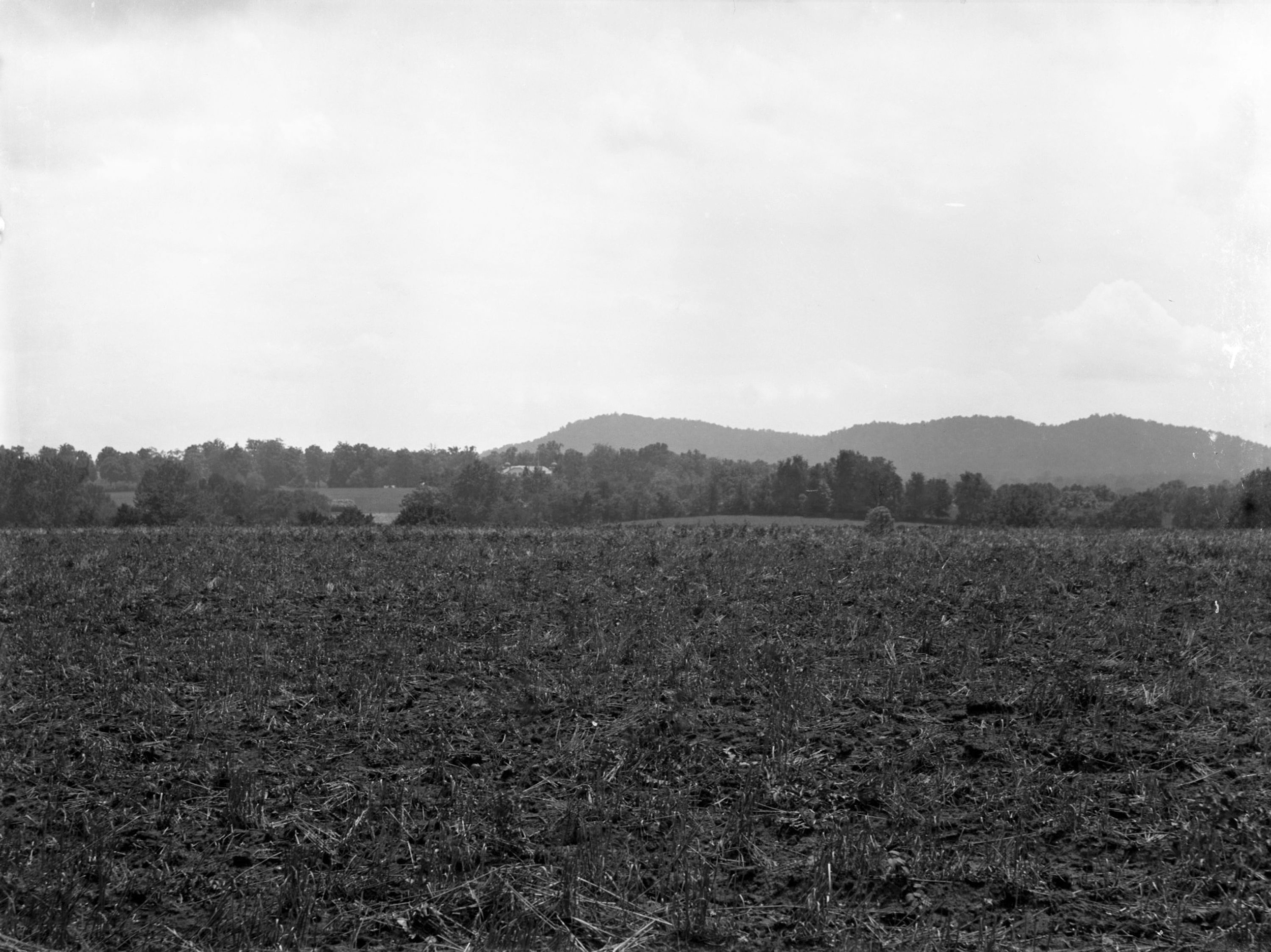
From the Collections of Dayton History. Copyright Dayton History. Title: “Overton Hills from Granny White Pike – July, 1899” (Double click to enlarge)
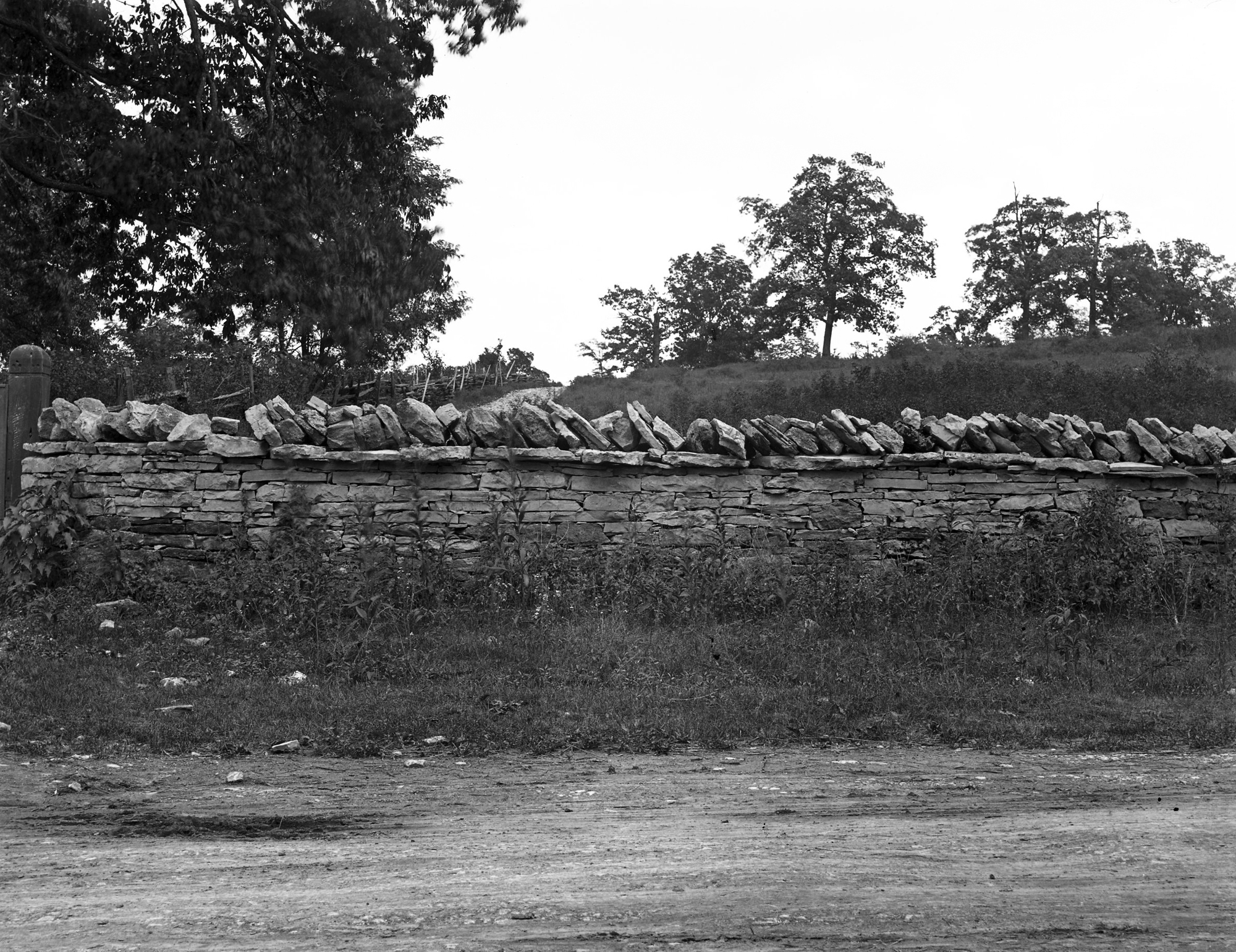
From the Collections of Dayton History. Copyright Dayton History. Title: “Franklin Pike hill entrenchment” (Double click to enlarge)
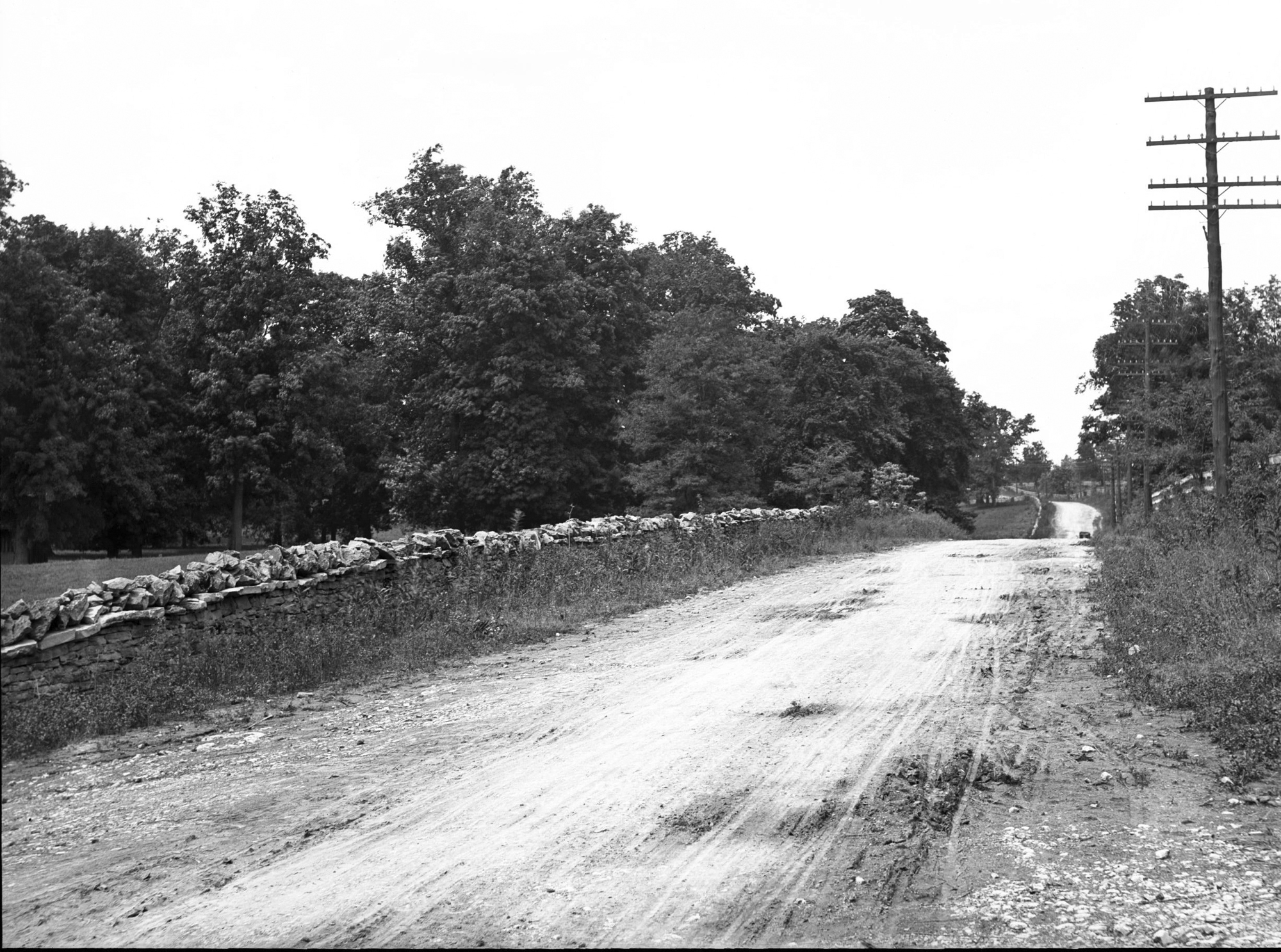
From the Collections of Dayton History. Copyright Dayton History. Title: “Franklin Pike looking north” (Double click to enlarge)
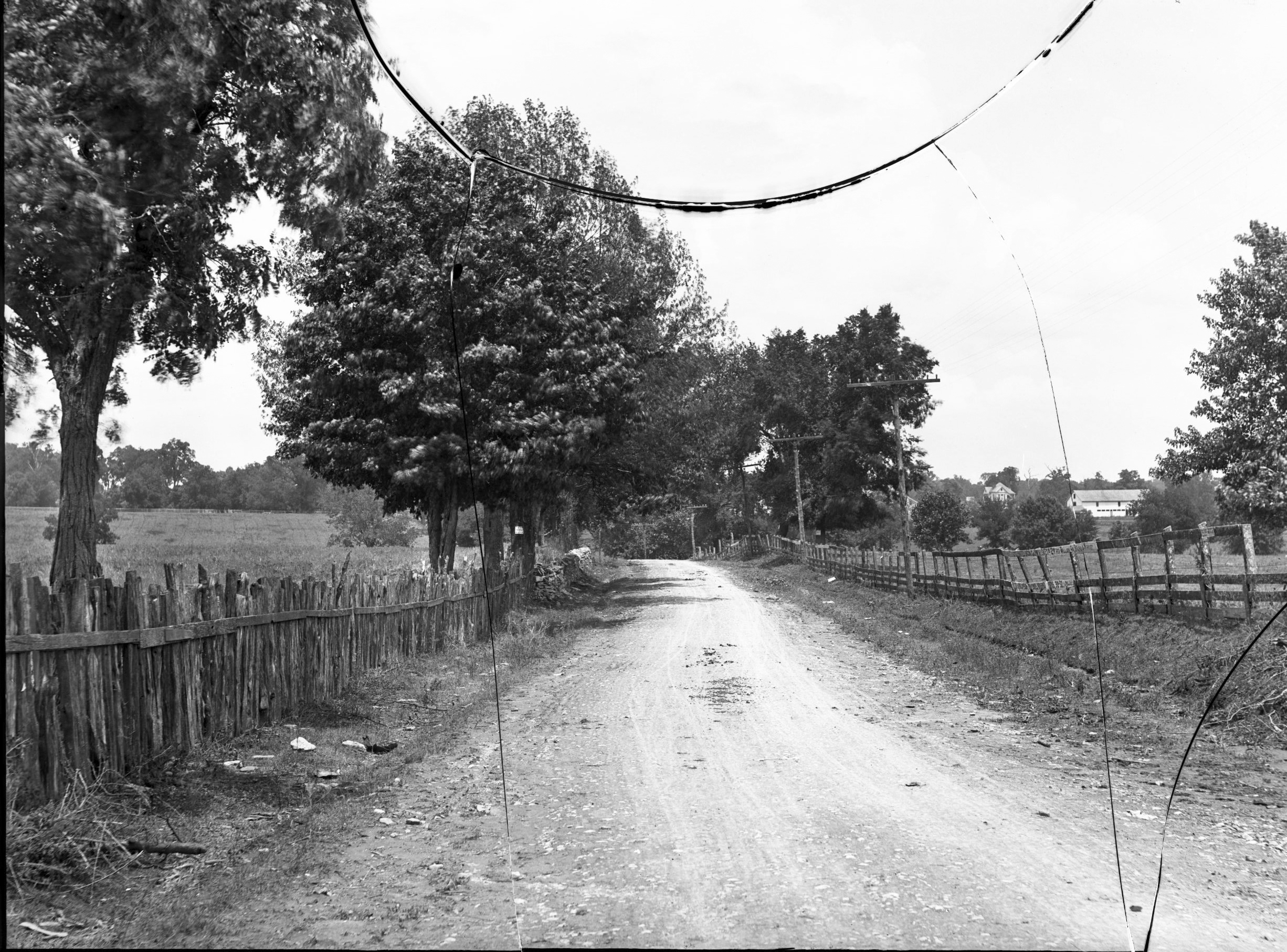
From the Collections of Dayton History. Copyright Dayton History. Title: “Granny White Pike” (broken plate) (Double click to enlarge)
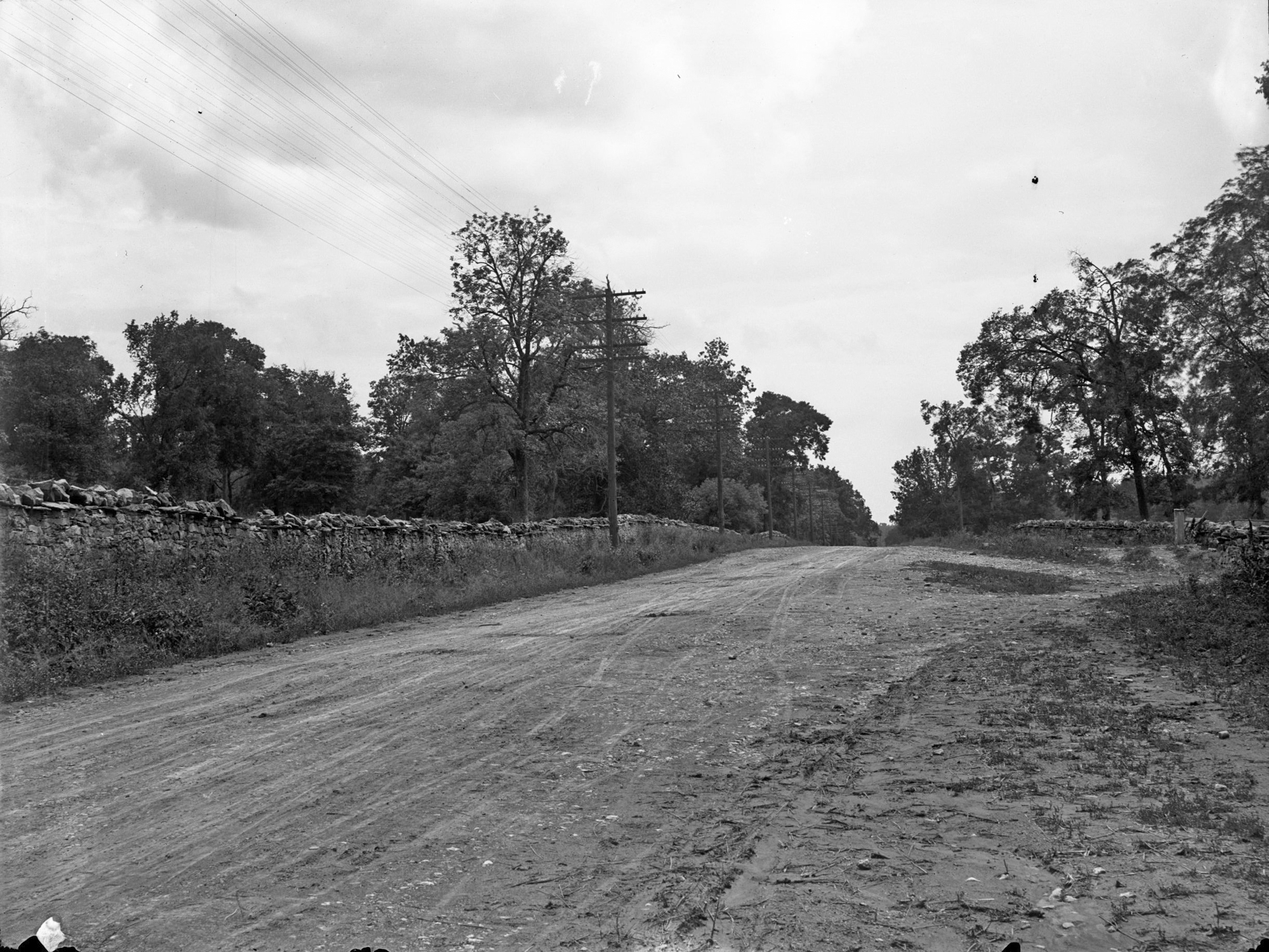
From the Collections of Dayton History. Copyright Dayton History. Title: “Granny White Pike” (Double click to enlarge)
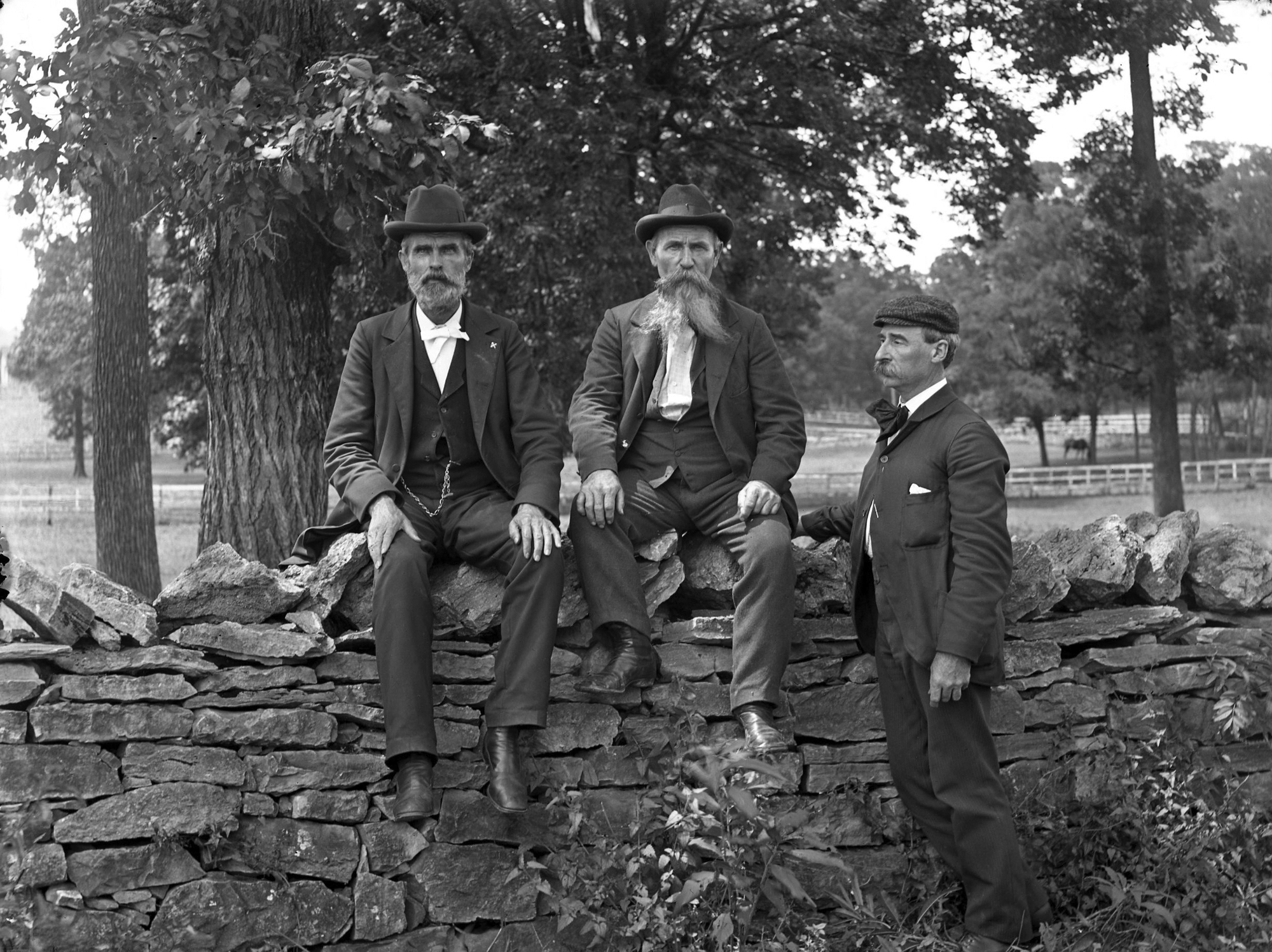
From the Collections of Dayton History. Copyright Dayton History. Title: “The group on Franklin Pike” (Double click to enlarge)
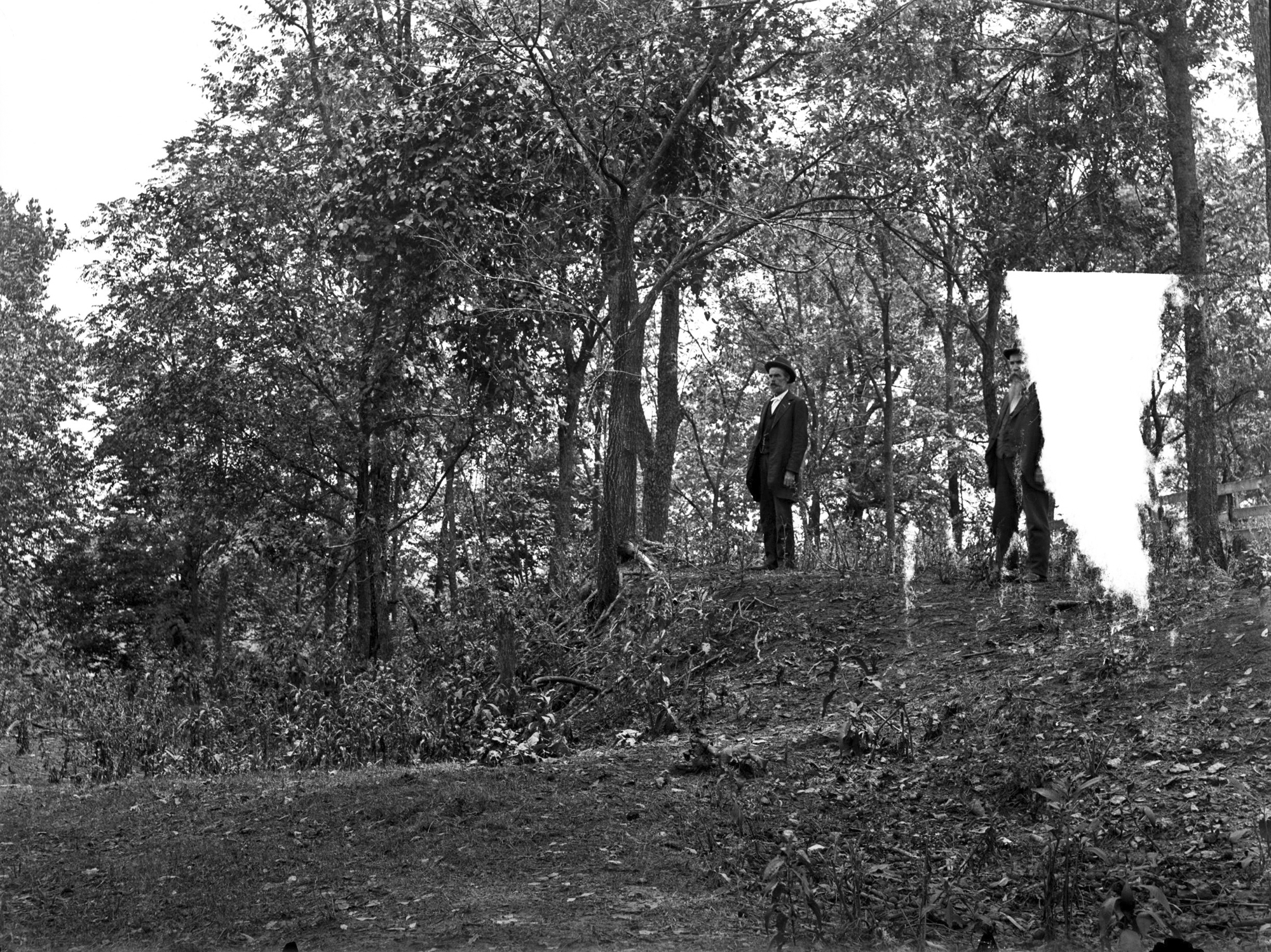
From the Collections of Dayton History. Copyright Dayton History. Title: “Munroe – Barnes on breastwork on redoubt” (Double click to enlarge)
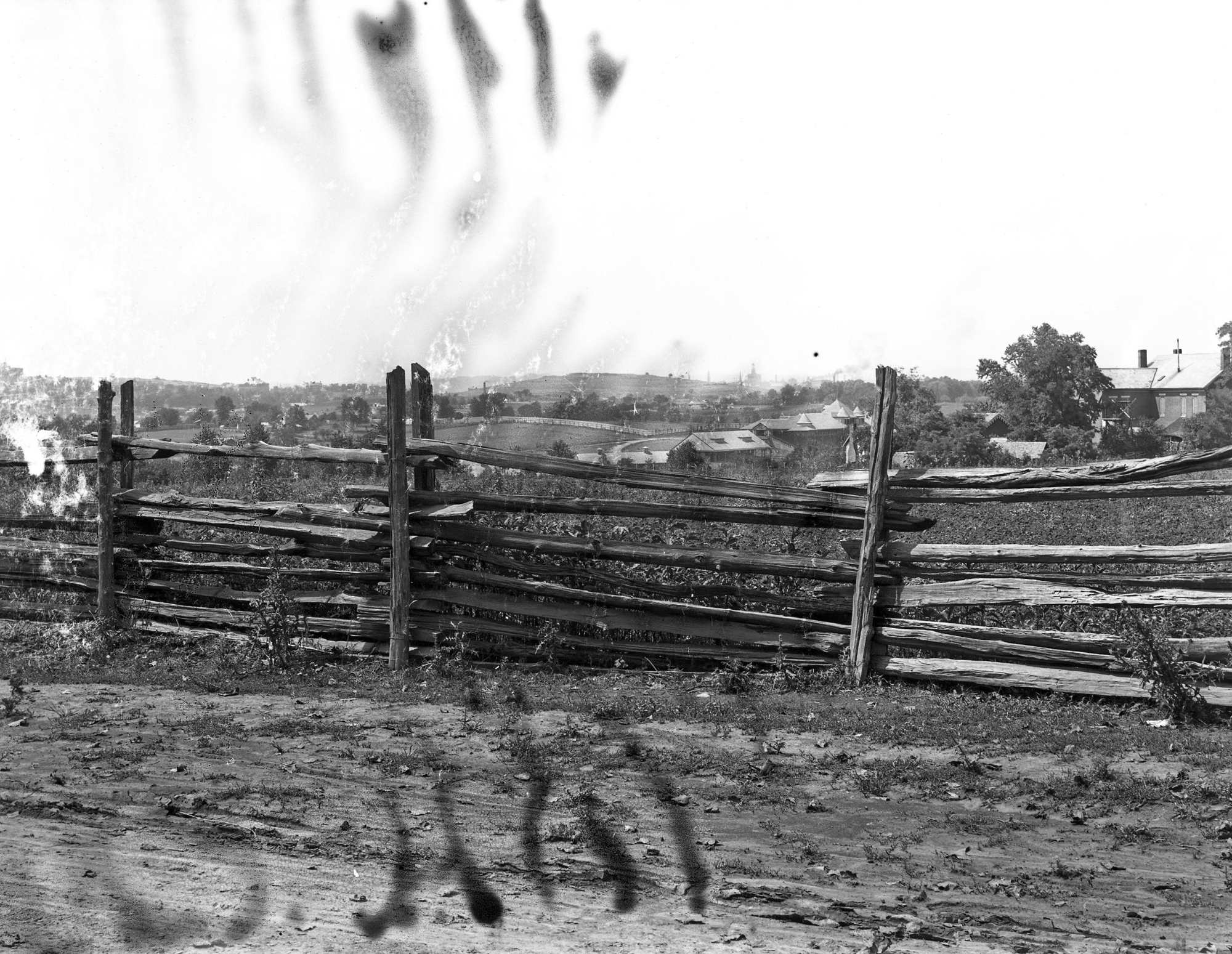
From the Collections of Dayton History. Copyright Dayton History. Title: “Nashville TN Ft. Negley” (Double click to enlarge)
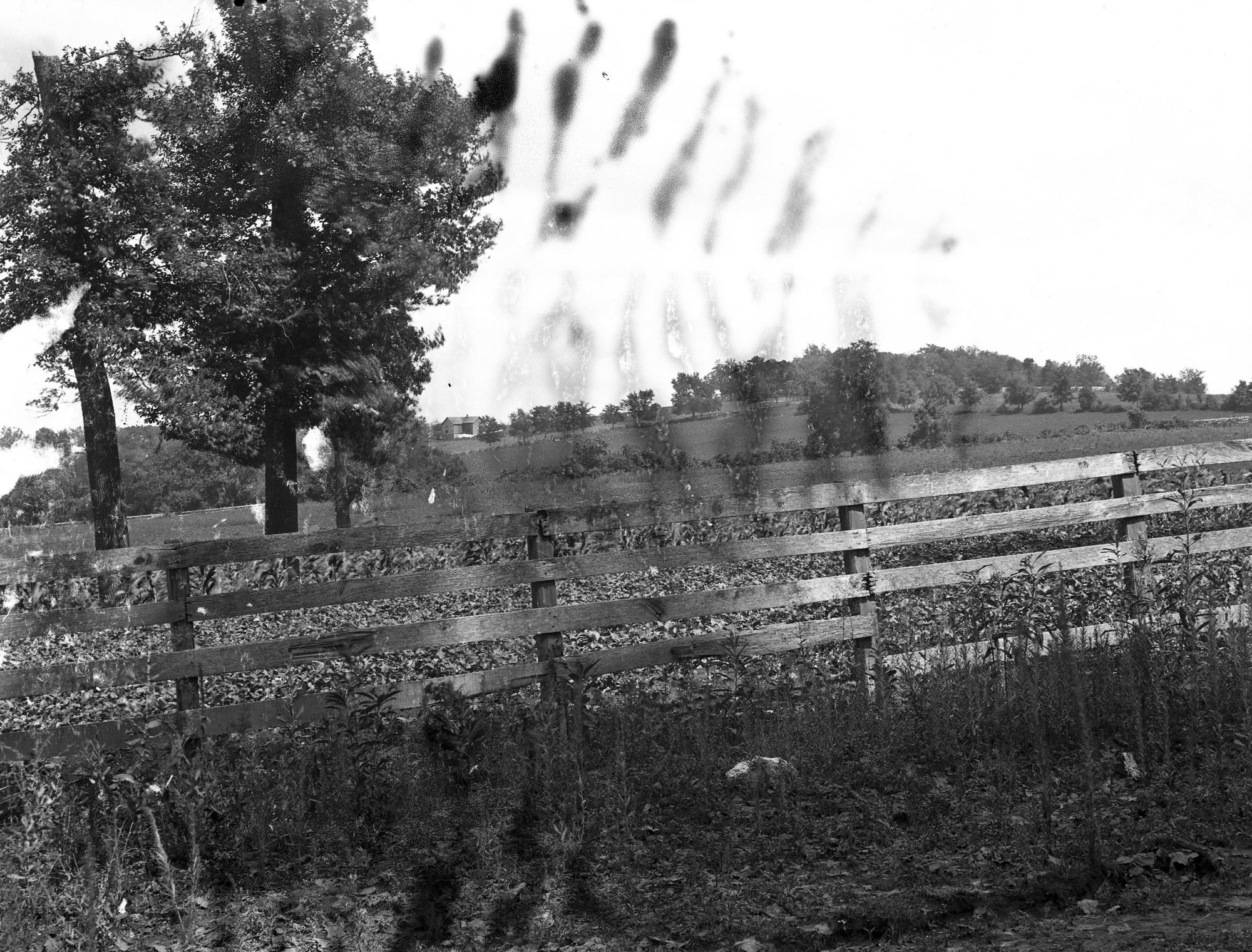
From the Collections of Dayton History. Copyright Dayton History. Title: “Rains Hill” (Double click to enlarge)
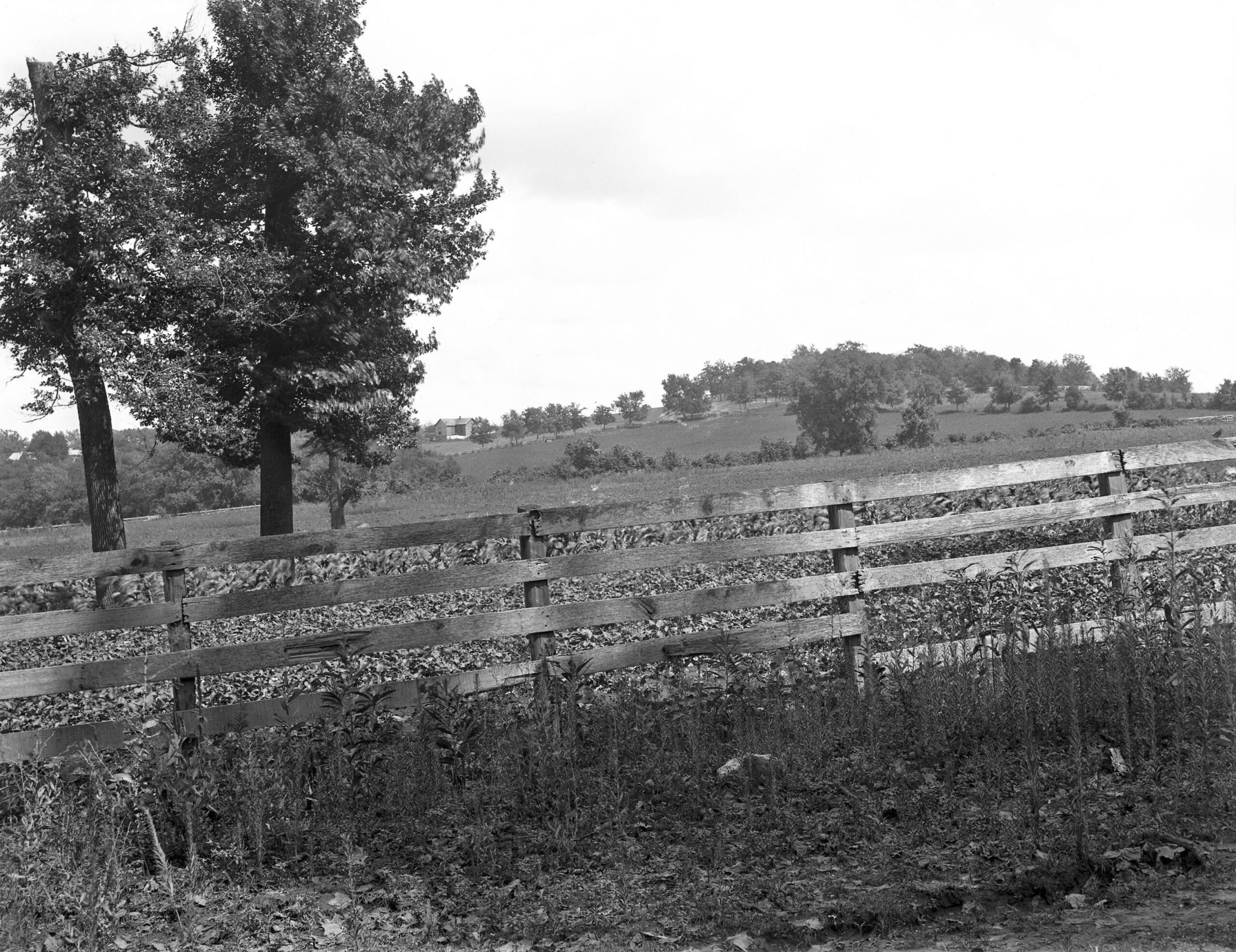
From the Collections of Dayton History. Copyright Dayton History. Title: “Rains Hill” (Double click to enlarge) [Copy of above print without smudge]
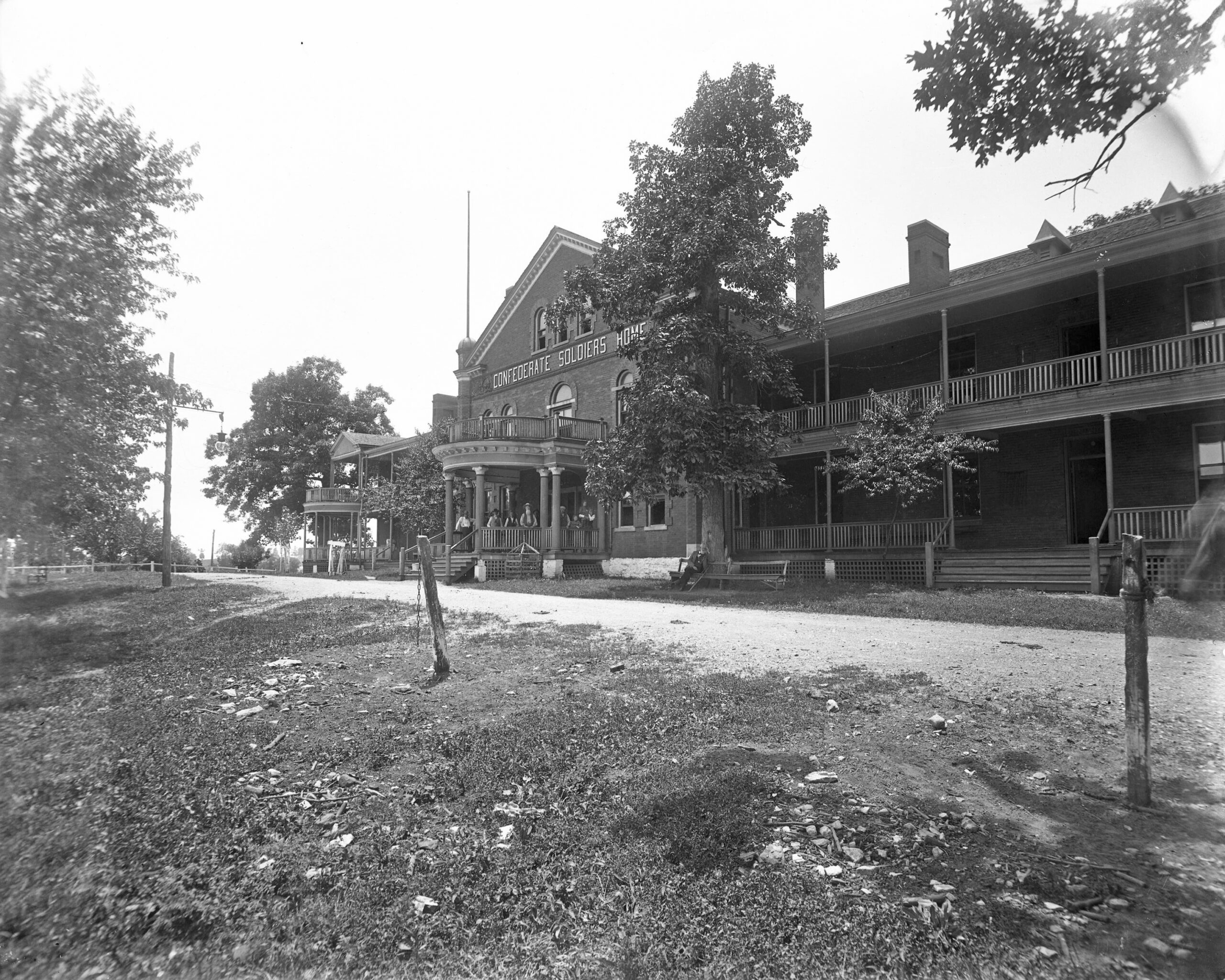
From the Collections of Dayton History. Copyright Dayton History. Title: “Confederate Soldiers Home (Double click to enlarge)
Note: The photo above shows the Confederate Soldiers Home which was built in 1892 on the grounds of the Hermitage Plantation. Some 700 retired Confederate veterans lived in its 125 rooms until it was closed in 1933. About half of its residents were buried in the adjacent cemetery, which still exists in Hermitage. For more information, click HERE.
June, 2021
NAMES ETCHED IN STONE FOR POSTERITY RE-EMERGE IN NEWLY-DISCOVERED “RELICS” OF THE BATTLE OF NASHVILLE
The Battle of Nashville Trust has become the recipient of an unusual “relic” of the Battle of Nashville – four 250-pound stone window sills from the famous Maxwell House Hotel, complete with the names of Union soldiers engraved into the surfaces.
Not only was the Trust the beneficiary of the rare artifacts, it was also the donor. The BONT Board elected to donate the sills to Travellers Rest Historic House Museum for permanent display.
The names of soldiers etched into these sills are there because, after construction on the hotel building began in 1859, it was taken over by the Union Army in 1862 and converted to “Exchange Barracks No. 1” to be used as a hospital for Union soldiers and a prison for Confederates in 1864.
John Banks, Civil War author and BONT board member, has written about the famous hotel, its war-time use, the fire that destroyed it in 1961, and his research into the real names found inscribed on the four sills. To read the full story, click on John’s Civil War Blog.
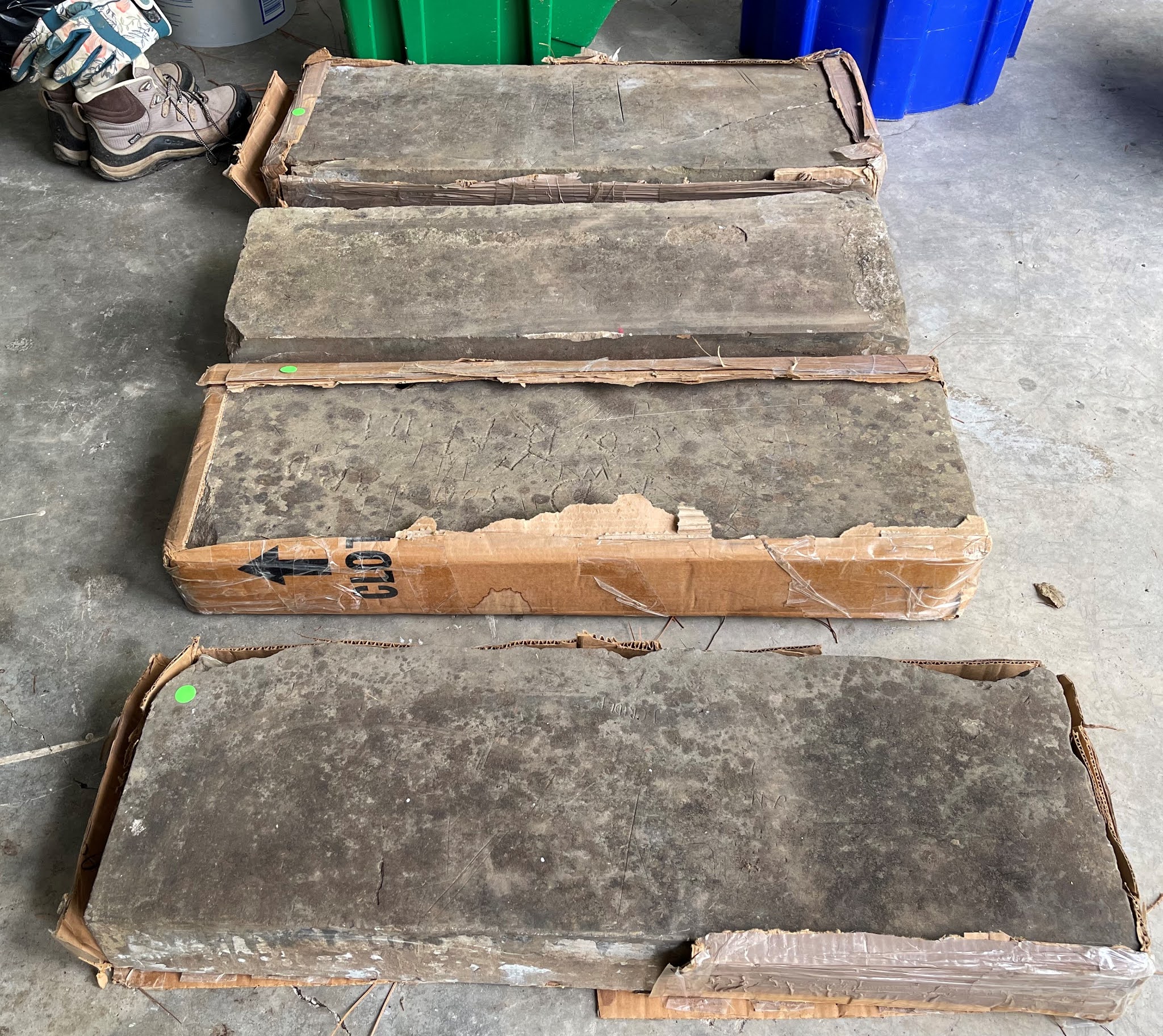
Above: Photo of stone sills etched with the names of wounded troops recovering in Maxwell House Hotel, 1864. Photo by John Banks
A private donor gifted BONT with the artifacts. They had been recovered by Gregory L. Wade of the Franklin Civil War Round Table, as described in his article for the North South Trader’s Civil War Magazine: Good To The Last Relic – The Maxwell House Hotel. 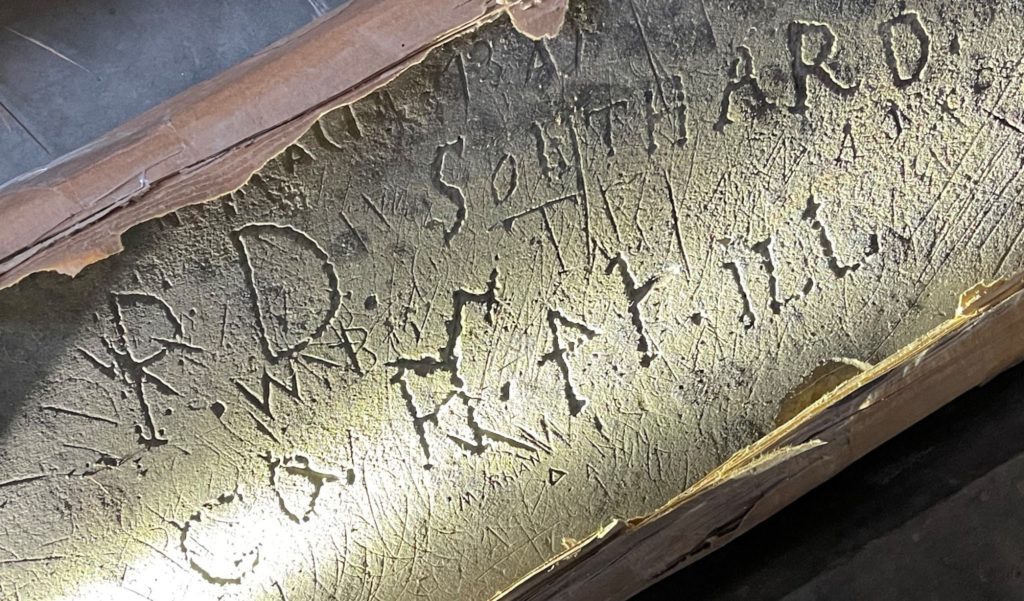 In the meantime, however, John Banks has been tracking down historical information about the men who scratched their names into the stones for posterity. For example, John’s photo above features Private Polk D. Southard, who he discovered to be a resident of Okaw, Illinois who enlisted on Christmas Day, 1863, when he mustered into the 41st Illinois Infantry Regiment. He ultimately found himself in Nashville where he apparently became a patient in Exchange Barracks No. 1 and carved his name into a stone sill of that building. A week after the Battle of Nashville ended, Southard transferred into the consolidated 53rd Illinois Infantry Regiment and about seven months later, returned to civilian life in July, 1865.
In the meantime, however, John Banks has been tracking down historical information about the men who scratched their names into the stones for posterity. For example, John’s photo above features Private Polk D. Southard, who he discovered to be a resident of Okaw, Illinois who enlisted on Christmas Day, 1863, when he mustered into the 41st Illinois Infantry Regiment. He ultimately found himself in Nashville where he apparently became a patient in Exchange Barracks No. 1 and carved his name into a stone sill of that building. A week after the Battle of Nashville ended, Southard transferred into the consolidated 53rd Illinois Infantry Regiment and about seven months later, returned to civilian life in July, 1865.
To see all data recovered as of June, 2021, in John’s research, click the following link: Maxwell House sills John Banks historical research 2021
June, 2021
VANDERBILT PROFESSOR EXAMINES DEPTH AND DETAILS OF “CIVIL WAR NASHVILLE” USING NEWEST TECHNOLOGIES
Brandon Hulette, a military science professor at Vanderbilt University, is using cutting-edge technology and other innovative techniques to guide his students towards a more detailed, in-depth view of the Federal occupation and battle of Nashville during the Civil War.
Hulette, a native of Brentwood with a life-long interest in the Civil War, is using a wide array of approaches in his course, “Telling the Story of Civil War Nashville,” including maps, overlays, lectures, reports, virtual reality, and physical visitations of battle grounds.
His lengthy resume in both military and civilian circles includes a Commission in the Medical Service Corps, U.S. Army Reserve for the past 16 years. He is a graduate of MBA in Nashville with later degrees in both Biological Science and Environmental Policy, post graduate work in Public Health and Epidemiology, and completion of a Master of Business Administration. He is board-certified in Biological Safety Microbiology, is a Registered Sanitarian, and is a Fellow of the American Academy of Project Management, as well as being a FEMA-Certified Continuity of Operations Planner and Advanced EMT. At Vanderbilt, he has faculty positions in both the Department of Military Science and the College of Arts and Sciences.
Below are three of the fascinating reports by his student:
 Civil War Nashville: Hospitals and Healing
Civil War Nashville: Hospitals and Healing
Presentation by Alyssa L Bolster & Jacob M Hale
For Story Map, click photo above; for video presentation, click here.
Naval Actions During the Battle of Nashville
Presentation by Ao Qu
For Story Map, click photo above; for video presentation, click here.
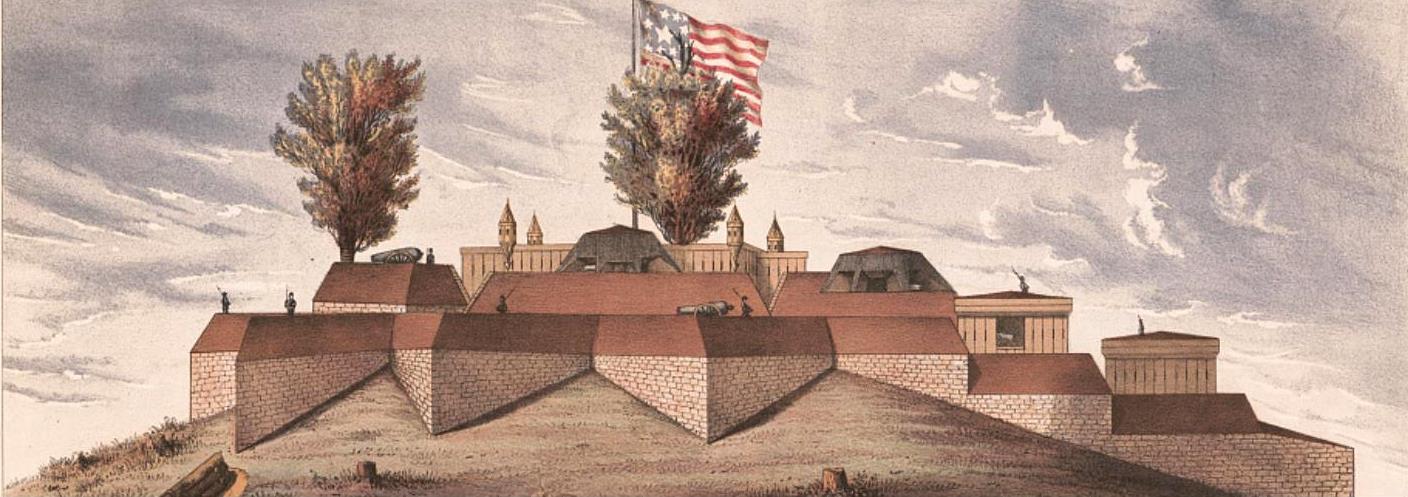
Fortress Nashville
Presentation by Grant Bowlds
For Story Map, click photo above; for video presentation, click here.
December, 2020
NASHVILLE AUTHOR DISCUSSES OVERVIEW OF BATTLE OF NASHVILLE
Author and historian Mark Zimmerman, a Battle of Nashville Trust member whose books include the excellent Guide to Civil War Nashville (2d ed. 2019), was interviewed in 2020 on Nashville Daily about his thoughts on the Battle of Nashville, its impact on the City of Nashville, and its aftermath. For an enjoyable and educational hour-long overview of the Battle of Nashville, listen below.
June 25, 2020
John Banks’ Civil War Blog Podcast: BONT’s Jim Kay
The Battle of Nashville Trust is fortunate to have two Board members who have a deep and far-ranging knowledge of the Civil War: Jim Kay, who as a kid grew up digging up Minié balls on the battlefield and became an expert on the Battle of Nashville, and John Banks, an author and historian who publishes his stories regularly on the John Banks’ Civil War Blog. In this Podcast, John and Jim, who is currently President of BONT, chat about interesting insights into the battle and battlefield:
October, 2020
A 6-Part Series
THE NOT SO CIVIL WAR IN TENNESSEE
(A Different Prism)
The author, Philip Duer, is a retired Nashville lawyer and former president of the Battle of Nashville Trust. He has a keen interest in all aspects of Civil War history, especially the Battle of Nashville, and has shared his knowledge in many ways, including writing and art, ranging from ink drawings of battle scenes to creating miniature models of soldiers and equipment. As a Vietnam combat veteran who served in the 25th Infantry Division (Tropic Lightning) in 1969, and decorated with a Purple Heart, Philip has personal experience in matters of military conflict, which is reflected in the depth of his knowledge and research in this 6-part series on the “behind the scenes” aspects of the Civil War. In it, he shines a light on all aspects of guerilla warfare, especially the prolific smaller skirmishes which occurred between the more famous “named” battles of the Civil War, and the activities and dangers of spies, couriers and others that fed information into both armies before and during the battles, including the espionage actions that surrounded Hood’s Tennessee Campaign and the Battle of Nashville. To help understand how these guerilla tactics affected the war, he has added the more modern perspectives of resistance fighters in World War II, and his own experiences in combat on the ground in Vietnam.
Part I of the series is included below. To read the entire series, click on: Guerilla Warfare.
By Philip Duer
We are all fascinated with the great battles of the Civil War; regiments, brigades, and divisions moving into action to slam into the opposing army. We are fascinated by the tactics and the military decisions that the army commanders made. We discuss what might have been if another course or tactic had been taken by playing armchair general. We are awed by the horrific battle casualties and we wonder how men could form up in line of battle to be mowed down by cannon fire and rifled muskets as a result of technology outpacing tactics.
We can all name the great battles of 4 years of conflict, but when we are called upon to put them down on paper, we are hard pressed to fill a page. Rare is the time that significant battles were fought close in time, Gettysburg and Vicksburg being the signature exception. At the start of the War months transpired between campaigns, armies going into winter quarters awaiting the commencement of the “campaigning season”. Did the War stop in those inactive periods? The answer is no.
There is a saying that all politics are local. The same can be said of combat. Doubtless many skirmishes happened in Tennessee where conventional forces faced each other in small unit actions. Most are lost to the attic of history, only to be rediscovered in long forgotten first person accounts, letters, operational records, and journals. But this article confines itself mostly to the “asymmetrical” side of the war in Tennessee.
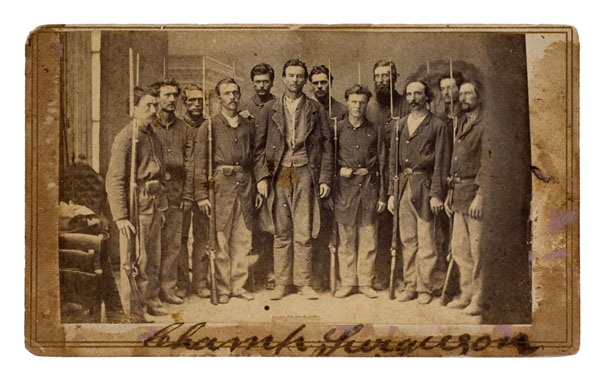
Above: Famed Confederate guerilla fighter Champ Ferguson following his capture, surrounded by his guards. It would appear that Ferguson was quite a celebrity, even to his captors at the Nashville Prison, in the same way as a John Dillinger
I have long heard that save for Virginia, Tennessee had more battles and skirmishes (10,000) than any other state. Missouri was third. But after naming the major battles in Tennessee, where and what are the thousands of skirmishes to support such a claim. Where are the sources one can go to verify this assertion….where do the numbers come from?
The answer is from a type of warfare that we think of as modern but which has been as old as Sun Tzu….”asymmetrical warfare.” Search and Destroy, Interdiction, Forward Operating Bases, Fire Support Firebases, Reconnaissance in Force, RAG’s (River Assault Groups)/ Brown Water Navy, Hearts and Minds, all tactics to combat asymmetrical warfare. Asymmetric war is guerilla war. It is based upon the tactics of ambush and hit and run with the ability to thrive in a protective and hostile population when the numbers of one side are not sufficient to meet an enemy in the field in conventional set piece battles.
In this writer’s opinion, these tactics and the counter measures to combat them were as relevant in the Civil War as they were in Vietnam and as they are in Afghanistan. This warfare is up close and personal and the dirty side of any war. The nomenclature may be different, but the strategy and tactics are the same. Anyone who has served in this type of environment can relate to the drudgery of patrolling and the sudden terror of unexpected combat. Forrest and Wheeler were not Guerillas, but they embraced the theories of that type of war in their cavalry operations. But going deeper into the type of combat that must have occurred to constitute such a high number of conflicts in Tennessee, one is left with the assumption that guerilla war was alive and well in the South.
I decided to write this article after I was asked by a local Nashvillian to provide some information on an ancestor who initially served in the 24th Tennessee (Strahl’s Brigade, Army of Tennessee) who subsequently enlisted, it appears in the 10th Tennessee Infantry (US). The first realization is that this man was probably captured and after becoming a prisoner, took the loyalty oath to the Union and became a “galvanized” Yankee. I had assumed all galvanized soldiers were shipped west to fight Indians but it appears that it may not always have been the case.
I searched some articles and books and found that the 10th Tennessee Volunteers (US) served in Nashville under Col. Alan C. Gillem, born in Jackson County, TN. This unit was formed in May through August of 1862. Gillem was subsequently promoted to Provost Marshal in Nashville and the 10th became known as Gillem’s Regiment. It also became known as The Governor’s Guard as it was posted part of the time on the Capitol grounds. Governor Andrew Johnson’s son, Charles Johnson, served as an asst. surgeon in the unit. The 10th also later provided railroad security and other protection. But in reading about this unit, I came upon after-action reports of 2 small unit patrols out of Nashville in February 1865. The mission of these patrols was to try and locate weapons and people who had been active in sniping at Union troops. These reports, by Captain Robert H. Clinton, 10th Tenn. Inf., are striking in their personal interaction with the local population. The reports can be found on the internet and I encourage you to read them. They refer to individual citizens and describe their homes. The February 12th patrol report from Captain Clinton of the 10th TN in part is set out below:
“ I proceeded on February 9th, at 6:00 pm with a force of 35 men belonging to the 14th Tennessee Cavalry of Cpt. J. L. Poston’s Company to the house of a Charles Luster, 30 miles south of Nashville at which place, according to the information, there was to be a Ball at which some 20 guerillas were to be present. 9 miles from this city on the Nolensville Pike I searched the house of a widow named Patterson whose son is a bushwacker and said to be the leader of a gang infesting that immediate neighborhood. I found one man in bed. The guide knowing nothing of him, I did not think it necessary to arrest him. In searching the house, the men found two shotguns, one Derringer pistol, and one carbine. I ordered them to be destroyed. They were loaded and ready for use. I then proceeded on the march passing through Triune at 11:30 pm…….”
The report goes on for some length. The 2nd patrol is termed a scout down the Nolensville Pike starting at 11:00 am on February 15th, 1865 to seek out armed men who were termed bushwackers interdicting and sniping on the road in the vicinity of a particular toll gate. This report is also very interesting reading and one is struck with the interaction with the local population, some citizens freely giving information to the patrol and others not so cooperative. I encourage you to read both of them.
These patrols and the people sought seem tame compared to what occurred in East Tennessee and especially on the Cumberland Plateau. Years ago, my wife and I were in an old grave yard looking at tombstones in Cades Cove in the Smoky Mountains and came upon at least one epitaph of a Tennessean “Murdered by Confederate Guerillas”.
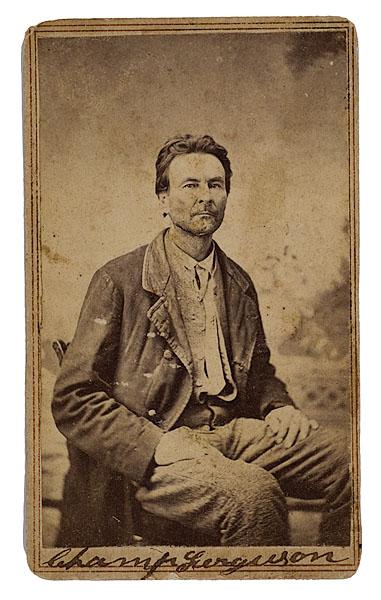 Bushwhacking, murder, and ambush were not exclusively the tools of southern sympathizers; It was a dirty business on both sides. There were Home Guard and Partisan Rangers, the former being Union ad hoc independent units, the Partisan Rangers being the southern equivalent, both numbering as little as 5 or 6 men to the dozens, depending on the threat involved. Both were formed in part to protect the respective populace from the threats and depredations of the other, especially in the Cumberland Mountains and plateau. Whereas the main Confederate Army was ejected from Tennessee after major engagements, the small independent companies of irregulars were not so easy to defeat owing to the intimate knowledge of the terrain by the bands operating therein, most being born and raised there.
Bushwhacking, murder, and ambush were not exclusively the tools of southern sympathizers; It was a dirty business on both sides. There were Home Guard and Partisan Rangers, the former being Union ad hoc independent units, the Partisan Rangers being the southern equivalent, both numbering as little as 5 or 6 men to the dozens, depending on the threat involved. Both were formed in part to protect the respective populace from the threats and depredations of the other, especially in the Cumberland Mountains and plateau. Whereas the main Confederate Army was ejected from Tennessee after major engagements, the small independent companies of irregulars were not so easy to defeat owing to the intimate knowledge of the terrain by the bands operating therein, most being born and raised there.
The ability to “shoot and scoot” and disappear into the rugged terrain of the mountains where operations by cavalry was hampered, was frustrating to regular army units sent into sweep the rugged terrain of their threat. This is not the first time that mountain country served as protection against an army. In looking for legal cases (Shepardizing as it was called before the internet) I came across an old Tennessee Report that discussed the final ceding of land to the Cherokee who did not come out of the mountains who had eluded the U. S. Army for years after the infamous Trail of Tears. These determined men and women would not leave their land and every attempt to capture them was futile).
Probably the best known of the Confederate irregulars was Champ Ferguson. No other person is more associated with murder in the Cumberland Mountains and in Kentucky than Champ Ferguson. Born in 1821 in Kentucky, he was executed by the Union Army in Nashville in October of 1865 after a lengthy trial by a federal military commission. His grave is off of Calfkiller Road near Sparta, TN. At trial, his defense team attempted to prove that he was a commissioned officer in the Confederate Army and was therefore entitled to the pardon made by Grant to Lee at Appomattox.
General Thomas would have none of that and once Ferguson had been coaxed out of the mountains with the anticipated promise of just going home as everyone else (Captain Wirz of Andersonville being the other exception to the pardon), he was put in prison, tried and executed in Nashville as a war criminal. Was he any different than “Tinker” Dave Beatty, a Union sympathizer who formed the Tennessee Independent Mounted Scouts who fought Ferguson in Fentress and Overton Counties, and operated between Jamestown and Sparta? The arguments go on as to who was the most ruthless. There were old scores to settle on the plateau, many of which pre-dated the Civil War.
Federal troops were stationed in or near plateau country to try and pacify the area but without much success. One of the little known skirmishes, the Battle of Dug Hill, would be the catalyst for the murder of men on leave, and some of Terry’s Texas Rangers near Monterey, Tennessee, as the “Black Flag” was unfurled by Col. Wm. B. Stokes, former Dekalb County Congressman, now Colonel of the 5th Tennessee Union Cavalry who had been ordered into the area to stop guerilla activity.
June, 2020
COPY OF OLDEST BOOK ON BATTLE OF NASHVILLE TELLS STORY OF BATTLE, EXPLAINS THE ORIGINAL HISTORICAL MARKERS
A 107-year-old booklet entitled The Battle of Nashville, the oldest book summarizing the Battle of Nashville, has found its way into the extensive Battle memorabilia collection of Jim Kay, president of the Battle of Nashville Trust.
Read the booklet: Oldest Battle of Nashville book pub. 1913
The booklet was published in 1913, some 49 years after the Battle and 43 years before publication of Stanley Horn’s iconic work, The Decisive Battle Of Nashville. The author, W. A. Beard, is noted on the cover to be writing on behalf of the Nashville Industrial Bureau. The book’s subtitle reads:
“The Limit of the Last Aggressive
Movement of the Armies of the Confed-
eracy, Hood’s Grand Maneuver Designed
to Prevent Sherman‘s March to the Sea.
Fought in the Southern Suburbs of
Nashville, December 15–16, 1864.”
Though Beard’s book was only nine pages in length, Nashvillians had previously had no succinct published account of the battle.
The booklet also contains seven pages summarizing the 20 historical markers existing at the time, many of which were reachable by street car lines. Jim Kay indicated that of the original 20, only two markers remain in existence: No. 14, marking Granbury‘s Lunette, and No. 19, marking the Nashville home of Aaron V. Brown, governor of Tennessee 1845 – 1847, known as “Melrose.”
June, 2020
END COMES FOR 400-YEAR-OLD WITNESS TREE THAT SAW A VIOLENT CLASH OF CAVALRIES AS PART OF THE BATTLE OF NASHVILLE
An ancient Bur Oak, which has witnessed buffalo thunder along the trail which later became Granny White Pike and was there to watch the legendary Battle of the Barricade during the Battle of Nashville, has finally lost its battle against time.
The Witness Tree of Richland Country Club, a stately Bur Oak (quercus macrocarpa) which dates to about 1613, was finally removed from its position on the Richland golf course on June 1, 2020.
Located about one hundred yards from Granny White Pike, Nashville’s most historic trail, the huge tree had witnessed buffalo migrating single file to the Great French Lick in present day downtown Nashville. It served as cover from the heat and storms for early Indians and later for the Creek, Cherokee and Chickasaw hunters. John Rains, one of Nashville’s earliest settlers, killed 32 bear in the cane breaks just north of this location in the 1770s.
Travelers from Nashville to Franklin went past this tree and this included Andrew Jackson, Thomas Hart Benton, John Overton and John Lea. This Bur Oak witnessed the construction of Granny White turnpike in 1849 on the old buffalo path.
On December 16, 1864, Confederate cavalry under the command of Col. D.C. Kelley and Col. Ed Rucker began its defense of the road to Brentwood as the Confederate army was swept from the field of the battle at Nashville three miles north. The Battle of the Barricade began nearby and the fierce fighting continued around this tree and to the south before the hand to hand combat ended in the cold darkness. On the same night, part of the victorious but exhausted U.S. cavalry under the command of General James Wilson camped under its branches.
The Tennessee Urban Forestry Council honored the Richland Bur Oak as No. 23 in its Landmark and Historic Tree Registry in 2013. “The Richland Witness Tree proudly stood watch for many years over the club at the No. 9 gold tee. It was a lasting tribute to those who have come and gone before us, lived their lives and made their marks on American soil,” said Jim Kay, president of the Battle of Nashville Trust and past president of Richland Country Club. With thanks to BONT Board Member John Banks, below are his final remarks regarding the remarkable tree:
Another Witness Tree, the Basket Oak, stands on the grounds of the Battle of Nashville Monument on Granny White Pike. For more on this ancient survivor of the battle, click here.
May, 2020
HOW THE BATTLE OF NASHVILLE WAS PHOTOGRAPHED
Some of the best known photographs of the Battle of Nashville were made by well-known Civil War photographer Jacob F. Coonley. (For a summary of the stories and photos of the two professional photographers in Nashville at the time of the battle, visit the Photos page here.)
Coonley had built his reputation and career in photography primarily in New York, Philadelphia and Washington, but when he heard that Confederate Gen. John Bell Hood was bringing his army to Middle Tennessee in an attempt to retake Nashville, he made his way to the area and was responsible for creating at least 10 stereo negatives on December 15 and 16, 1864. The original negatives are now in the Library of Congress.
Click the Coonley photo below to open a link to the April, 2013, newsletter of “Battlefield Photographer,” in which author John Kelley describes the movements and photos of Coonley during the Battle of Nashville.
According to Kelley, Coonley, 32 years old at the time, traveled around the city during the two days of the battle in a converted Federal ambulance wagon. The closest he got to the action was Fort Casino, now the site of the Nashville Reservoir on Eighth Avenue. In the distance of one of the photos he took from the high ground at Ft. Casino is Belmont Mansion, then the home of Mrs. Adelicia Acklen, which was a little less than one mile to the southwest of his location.
Special thanks on behalf The Battle of Nashville Trust to “Battlefield Photographer” and its board member John Banks, who is also on the board of BONT.
April, 2020
CONFEDERATE GENERAL’S DIARY SHEDS LIGHT ON BATTLE OF NASHVILLE ACTION, HORRIFIC ARTILLERY WOUND
The diary of Brig. Gen. Claudius W. Sears (pronounced “sars”) paints one Confederate officer’s personal picture of Hood’s Tennessee Campaign, beginning with his arrival in Columbia, on Nov. 27, 1864, extending through the trauma of being hit by a solid artillery ball in Nashville, and ending with his efforts to retreat southward through Dec. 25, 1864.
The diary came to the attention of Jim Kay, a Battle of Nashville historian and President of The Battle of Nashville Trust, and with the help of BONT board member John Banks, was transcribed from its difficult penmanship by an expert in that field, William Griffing (a/k/a, “Griff”) (Click here to read John Banks’s profile of Griff )
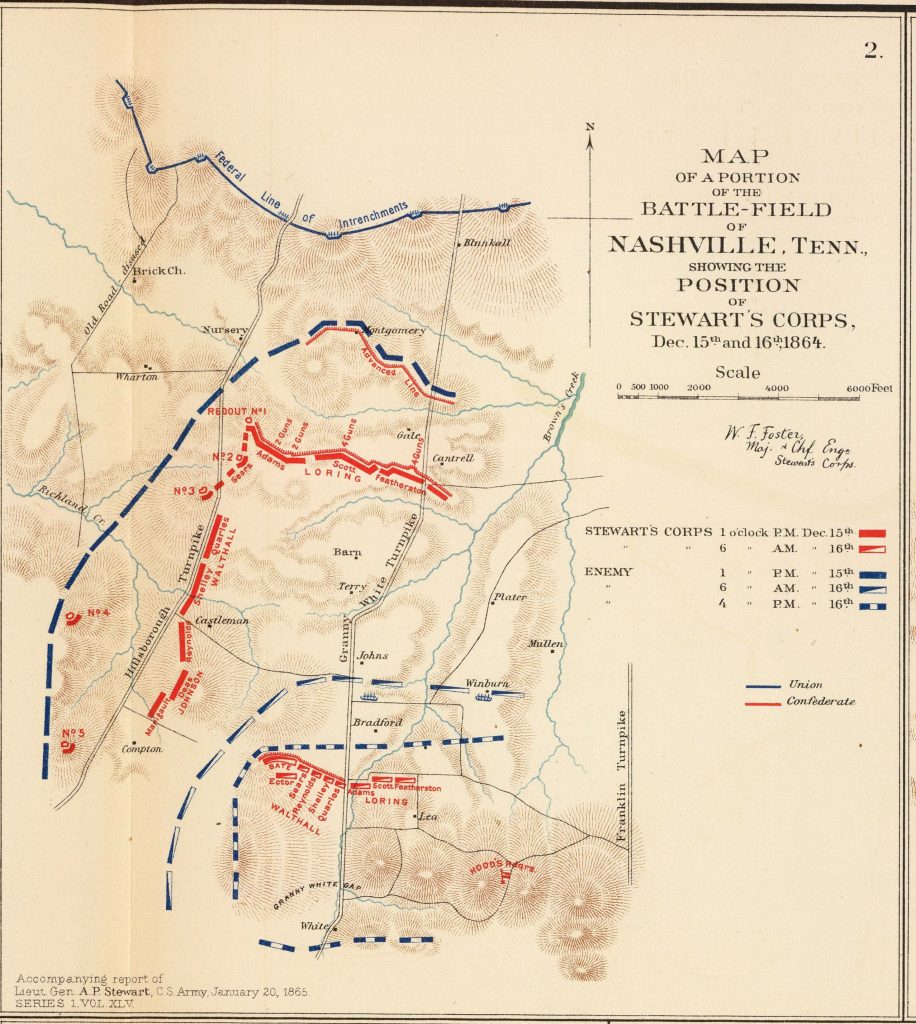 A copy of the general’s diary page describing the battle of Nashville is included below. Click the image to read the full transcription which has been posted on Griff’s blog site.
A copy of the general’s diary page describing the battle of Nashville is included below. Click the image to read the full transcription which has been posted on Griff’s blog site.
Gen. Sears was a Mississippian who had graduated from West Point in 1841 and after a brief stint fighting Seminoles in Florida, had settled into his role as president of St. Thomas’s Hall school in Holly Spring, MS. When the war began, he quickly ascended to the rank of colonel with the 46th Mississippi Infantry, and was a brigadier in Stewart’s Corps when Hood came to Tennessee. On Dec. 15, 1864, at age 47, he was commanding a brigade of 210 men from one of Stewarts’s divisions, who were positioned generally along the East side of Hillsborough Pike in a north-south line between Redoubt Nos. 2 and 3.
As that line broke late in the afternoon of Dec. 15, Sears was severely injured when he and his horse, “Billy,” were hit by an artillery shot. Jim Kay has concluded that Sears would have been an inviting target as he sat his horse scanning with field glasses, surrounded by his staff at the time of the injury, which probably occurred near the Plater house (which can be seen on some maps; click map image to enlarge) between Lealand Lane and Franklin Pike, south of Caldwell Lane.
Gen. Sears was taken a little over a mile away to the Ewing house on Franklin Pike, where his leg was amputated. The 46th Mississippi moved on without him and was positioned in Stewart’s line near present-day Harding Place. They had a tough day on Dec. 16, trying to hold the line from their trench works in a corn field between Shy’s Hill to the north and Granny White Pike to the South. Sears survived the horrendous injury and retreat, and spent much of the remainder of his long life as a professor of mathematics at the University of Mississippi.
Here is the story in Gen. Sears’s words (click image below for transcription by William Griffing):
April, 2020
Battle of Nashville Colt 1851 Navy Revolver Gets Restored, Fires Again
The story of Nashville songwriter Taylor Agan and his discovery of the history of his 4th Great Grandfather, 1st Lt. Jonathan J. Rapp of the 49th Ohio, is chronicled below in the Features section. Lt. Rapp was wounded on December 15, 1864, during the Union assault on Redoubt No. 1.
Taylor began collecting his family’s history when he was a student at Belmont University, and eventually located his 4th GGF’s diary and his classic Colt 1851 Navy, the .36 caliber revolver the officer was carrying with him on the Nashville battlefield.
He has now taken it to firearm specialist Rocky Marcario of Spring Hill, TN (another location where the sidearm had been carried in battle by Lt. Rapp), who restored it to shooting condition. In the video below, for the first time in many years, perhaps since the end of the war in 1865, Taylor has the privilege of firing the classic 6-shooter. His ancestor, who was 27 years old at the time of the Battle of Nashville, died at the age of 86, having survived wounds at Chickamauga and Nashville during the Civil War. (Click photo below)
Note: A Colt 1851 Navy revolver played a historic role in Spring Hill, TN, during the mysterious shooting of Maj. Gen. Earl Van Dorn by Dr. George Peters on May 7, 1863. Scroll down to read to story of “Crime of Passion? The Day the Doctor Shot the General.”
November, 2019
Wilson’s Cavalry: The March Through Alabama After Nashville
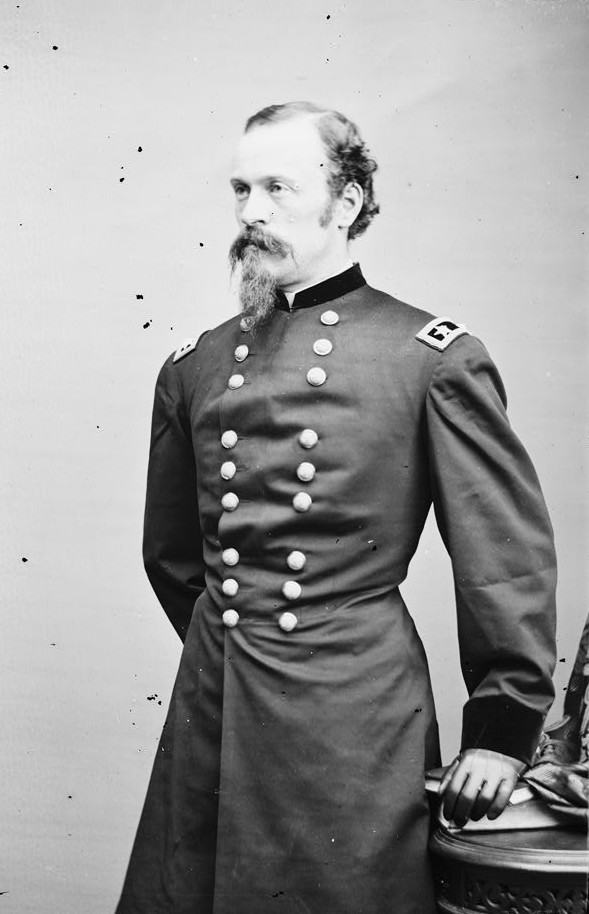 Among the remaining major military actions of the Civil War following the Battle of Nashville was a little-known destructive march through Alabama by the large Union cavalry force under Maj. Gen. James H. Wilson, who had played a major role in the battle of Nashville. In the Spring of 1865, following the two-day battle in Nashville, Wilson led his 13,500 troops south into Alabama on a raiding march similar to that of Sherman’s march to the sea.
Among the remaining major military actions of the Civil War following the Battle of Nashville was a little-known destructive march through Alabama by the large Union cavalry force under Maj. Gen. James H. Wilson, who had played a major role in the battle of Nashville. In the Spring of 1865, following the two-day battle in Nashville, Wilson led his 13,500 troops south into Alabama on a raiding march similar to that of Sherman’s march to the sea.
Confederate Gen. John Bell Hood’s army was no longer a force to reckon with. Hood himself, following the Battle of Nashville, had moved southwest, primarily into various areas of Mississippi, and eventually surrendered in Natchez in 1865.
The attached article, which appeared in the November, 2019 edition of Alabama Pioneers, describes the 525 mile raiding expedition of Wilson’s cavalry deep into Alabama in the spring of 1865, eventually ending in Macon, Georgia.
Because it illuminates events which occurred after the battle of Nashville, BONT includes it here for its post-Nashville perspective, and for the unique letter of one of Wilson‘s riders, Private Charles Wooster of Co. G, 2nd military volunteer cavalry. The article was published by historical writer and novelist Donna Causey:
“To Tuscaloosa and Beyond: Letter from A Union Cavalry raider in Alabama, March-April 1865”
July 18, 2019
What Will A Confederate Tree Reveal?
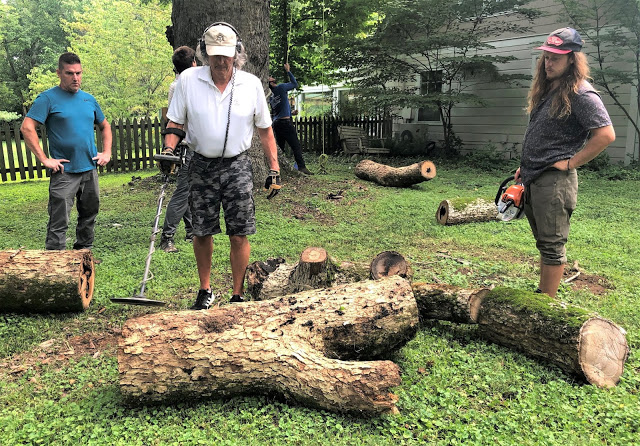
BONT President Jim Kay will soon find out if a rare Battle of Nashville “Witness Tree” near his home contains bullets or shrapnel from the battle.
This “Witness Tree,” defined as one that was present at the time of the battle, is a huge oak in Oak Hill along the Confederate line of December 16, 1864, and also near Kay’s home. When a storm damaged the tree and offered the opportunity to examine some of its large limbs, Kay deployed his metal detector and discovered the tell-tale audio signatures of metal within the wood. Select pieces have been sent away for X-ray examination.
The full story, with photos, has been chronicled by journalist/blogger John Banks in his Civil War Blog. Click HERE to read and see the full story.
February, 2019
CIVIL WAR TIMES ARTICLE DISCUSSES CURRENT STATE OF NASHVILLE BATTLEFIELD
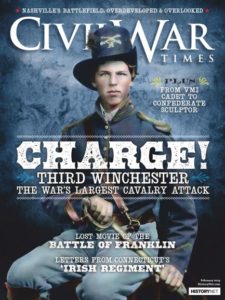 The February, 2019, issue of Civil War Times features an article by author John Banks about the Battle of Nashville battlefield, or rather, its non-existence. Banks, who recently moved to Nashville, is a member of the Battle of Nashville Trust board. The theme of his article, entitled “Battlefield of the Mind,” is that the battlefield essentially no longer exists except in remnants, and in the imagination.
The February, 2019, issue of Civil War Times features an article by author John Banks about the Battle of Nashville battlefield, or rather, its non-existence. Banks, who recently moved to Nashville, is a member of the Battle of Nashville Trust board. The theme of his article, entitled “Battlefield of the Mind,” is that the battlefield essentially no longer exists except in remnants, and in the imagination.
To view the article, click on the following link:
Civil War Times – Feb. 2019 (00157041xAE58A)
Banks is the author of two books about the Civil War as well as a Civil War blog, and is a frequent contributor to various historical publications.
The point made by this article centers around the thought that, in contrast to preserved fields of conflict such as Gettysburg and Chickamauga , the Nashville battlefield and the battle itself are hard to imagine now that the ground has been overtaken by residential and commercial development, or otherwise victimized by neglect.
This reality only serves to emphasize the significance of the important parts of the battle ground saved and maintained by The Battle of Nashville Trust, especially Shy’s Hill and Redoubt No. 1.
December 5, 2018
NEW HISTORICAL MARKER SHOWS POSTION OF FEDERAL TROOPS JUST BEFORE ATTACK ON SHY’S HILL
On December 5, 2018, the Metro Historical Commission erected a historical marker near the corner of Compton Trace and Harding Place, showing the area where Gen. John McArthur began the Federal assault on Shy’s Hill late in the afternoon of December 16, 1864.
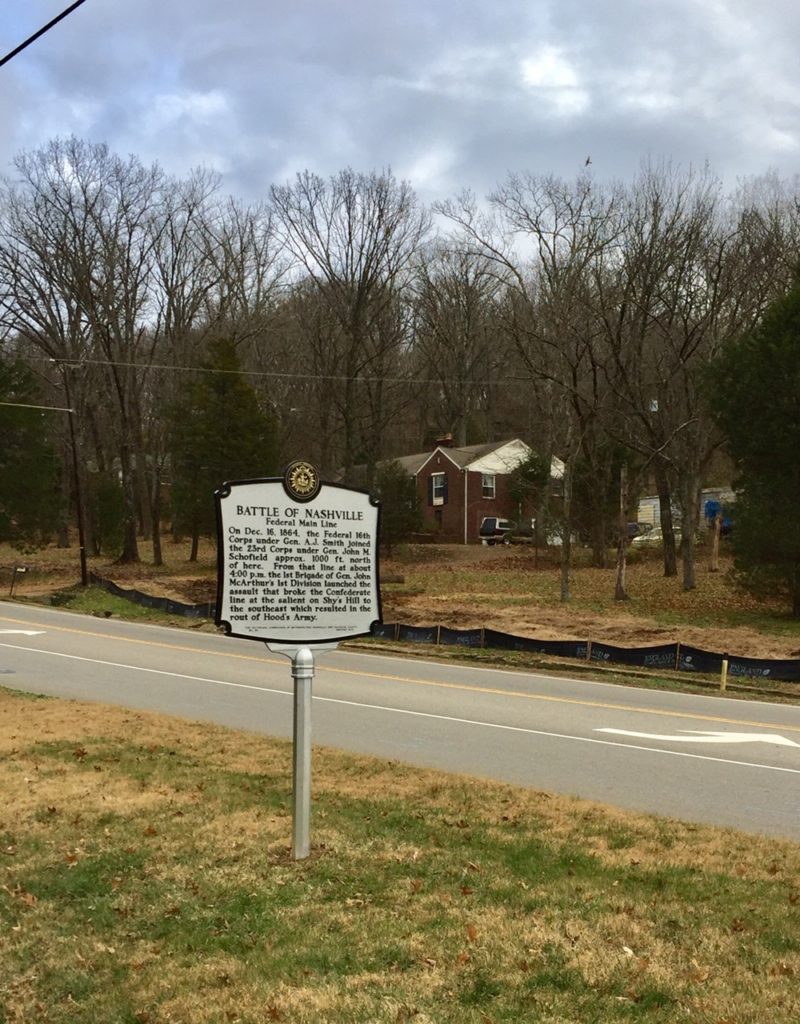
Above, Metro Historical marker near area where Federal forces launched their attack on Shy’s Hill. The rise of the Hill, then known as Compton’s Hill, can be seen in the background. For a summary of the battle, click HERE.
November 2. 2018
FLAG CEREMONY HONORS THOSE WHO BUILT FORT NEGLEY
December 7, 2018 marks the 156th anniversary of the construction of Fort Negley.
In honor of the occasion, on November 2, 2018, Ms. Tina Cahalan Jones from the Slaves To Soldiers Project spoke along with TSU Professor Dr. Learotha Williams Jr. in an event 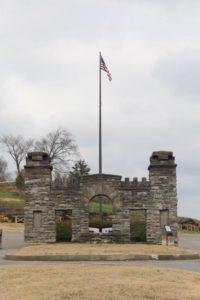 commemorating the 2,771 African American laborers who constructed the fortifications around Nashville during the Civil War.
commemorating the 2,771 African American laborers who constructed the fortifications around Nashville during the Civil War.
As part of the ceremony, 2,771 American flags were planted on the Fort grounds to commemorate each of the individual names listed in the “Employment Rolls and Nonpayment Rolls of Negroes Employed in the Defenses of Nashville, Tennessee, 1862-1863.”
Many former African American slaves sought refuge with the Federal Army during the occupation of Nashville, but were conscripted to build Fort Negley in 1862, and then, once the forts were completed, they enlisted in the US Colored Troops. Ms. Jones’s speech focused on the men of the 12th US Colored Infantry who were largely recruited out of the ranks of these laborers.
Confederate Map of Ft. Negley
During the debate regarding the preservation of Ft. Negley park, a Confederate map of Nashville, apparently drafted in 1862 – 1863, was discovered in the National Archives. The map appears to be hand-drawn and depicts the location of “Ft. St. Cloud,” the original name of Ft. Negley, which was constructed on a prominence on the Overton property known as Saint Cloud Hill.
The map contains a descriptive paragraph of the Fort, although it is partially obscured by damage to the original document.
The City of Nashville was captured by Union forces in February, 1862, and remained occupied until after the Battle of Nashville on December 15-16, 1864, and the end of the war in 1865. Below is a copy of the map (click to enlarge; 2nd click results in largest format):
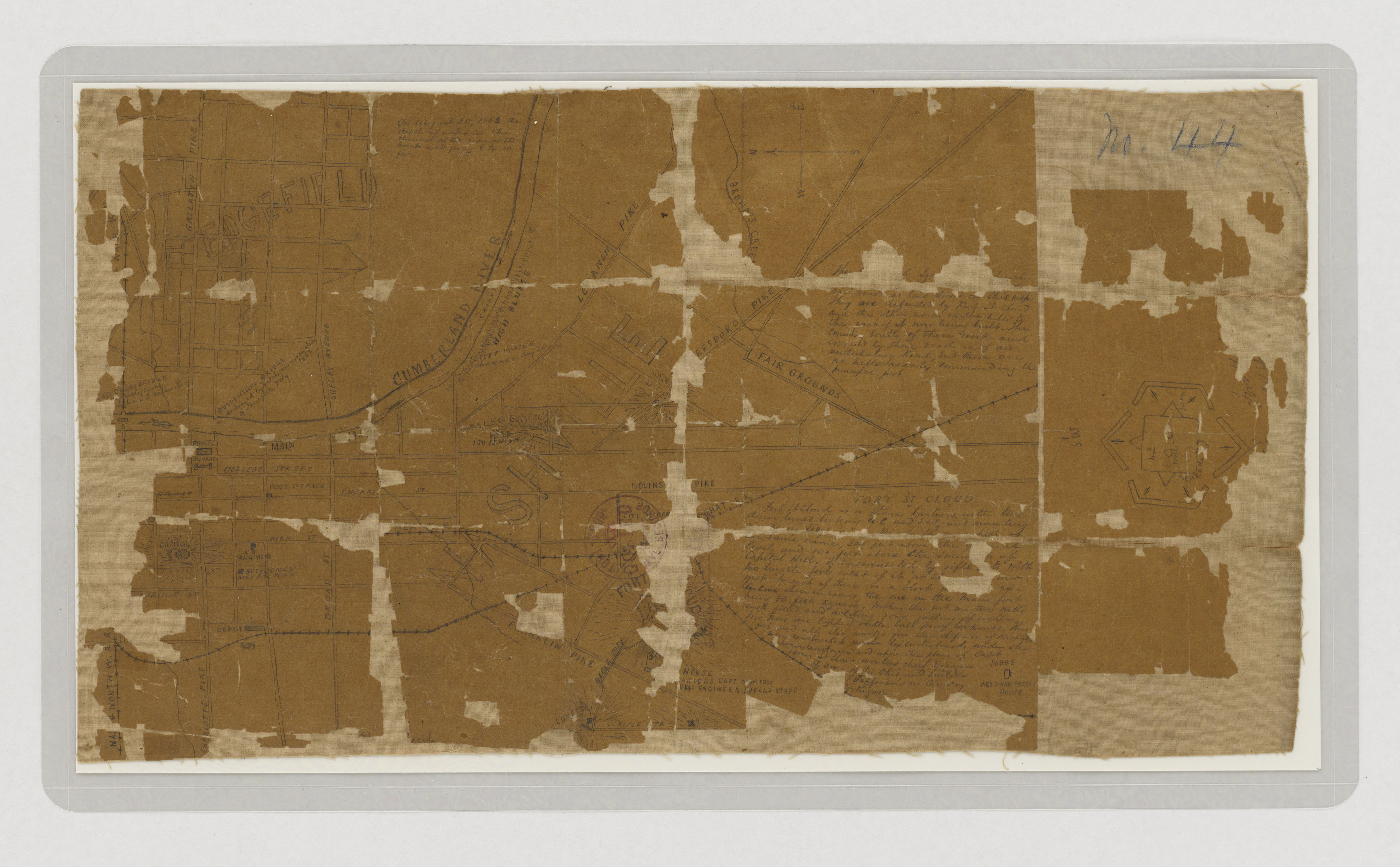 Friends of Fort Negley provided the following from two experts who have attempted to read the handwritten description of the Fort. They arrived at two versions; the first is one showing known or very probable words, and blanks for missing or unreadable words:
Friends of Fort Negley provided the following from two experts who have attempted to read the handwritten description of the Fort. They arrived at two versions; the first is one showing known or very probable words, and blanks for missing or unreadable words:
“Fort St Cloud is a stone bastion, with two
______ _____ looking N.E. and S.W., and ________ing
_____ ______ siege ___________________ hill of
the same name, 300 feet above the ________ _______
level and 100 feet above the summit of
Capitol Hill. It is connected by rifle pits with
two lunette forts west of it ____ ______ _______
_____ ______ each of these is a block of ex-
tensive dressed stones, the one in the main fort
being 80 feet square. Within the fort are two wells
each filled and holding _______ gallons of water
____ ______ are topped with bomb proof lookouts. This
fort and all the works for the defence of Nashville
were constructed under by contrabands under the
______ _______ and upon the plans of Capt
James St Clair Morton, Chief Engineer
Of Army of the Ohio, and builder
___Jefferson in the Dry
Tortugas.”
The version below makes an attempt, using educated guesswork and speculation, to supply the missing or illegible words. The possible substituted words are underlined.
Fort St Cloud is a stone bastion, with two
demi lunes looking N.E. and S.W., and mounting
six heavy siege guns. W_____ ____ hill of
the same name, 300 feet above the general
level and 100 feet above the summit of
Capitol Hill. It is connected by rifle pits with
two lunette forts west of it as shown on our map.
In each of these is a block house of ex-
tensive dimensions, the one in the main fort
being 80 feet square. Within the fort are two wells
each filled and holding 2000 gallons of water
Two hills are topped with bomb proof lookouts. This
fort and all the works for the defence of Nashville
were constructed under by contrabands under the
superintendence and upon the plans of Capt
James St Clair Morton, Chief Engineer
Of Army of the Ohio, and builder
___Jefferson in the Dry
Tortugas.”
April, 2017
THE STORY OF MY 4th GREAT GRANDFATHER
By Taylor Agan
Web Note: This interesting tale of family discovery written by Nashville songwriter Taylor Agan highlights the importance of the Descendants page of the BONT website. BONT invites anyone whose ancestors participated in the Battle of Nashville to submit their family history for inclusion in the Descendants Page, which helps to “bring to life” the names and statistics of the men who fought on Nashville soil in1864. Taylor’s story also highlights the importance of the preservation of historic sites like Redoubt No. 1, which can serve to connect multiple generations of families whose members were involved in the Civil War in Nashville.
The story of discovering my 4th great grandfather’s role in the Battle of Nashville has a bit of backstory. Growing up I was blessed to know all 8 of my great grandparents. One of my great grandmothers told many stories of her father, Max Rapp, who grew up in a small farmhouse in Indiana and moved to Hollywood, California to compose music for movies. He worked at Universal Pictures during its golden years beginning in the 1930s until his death in 1960.
Hearing stories of Max made me want to write music as well. In the fall of 2012, I moved to Nashville to attend Belmont University’s Songwriting Program. One of the songs I wrote during my time there was called Picking Up The Leaves that turned into a much larger project about my ancestry. As an idea for the music video, I visited over 100 cemeteries in 20 different states and took friends along to capture the trips on camera. I’ve discovered so much about my heritage and have met the most amazing people along the way (the project is almost finished, stay tuned!).
One of the trips I took was to Warsaw, Indiana where I visited the farmhouse Max grew up in before moving to Hollywood. The family who lives there welcomed me with open arms as I showed them old photographs passed down of their home. They mentioned they knew a few Rapps who attended their church…as it turns out, they were Max’s distant cousins who still lived in Indiana. Our 2 sides of the family hadn’t been in contact since Max moved to Hollywood in 1928.
Jim & Linda Rapp started telling me stories about Max’s great grandfather, Captain Jonathan J. Joseph Rapp, who was wounded during the battle of Nashville. The battle sites around my city suddenly took a very personal meaning. They shared several photographs with me, letters, and the $10 bill with a bullet hole that was in his pocket when he was wounded. They also told me me of other heirlooms Captain Rapp passed down to different sides of the family including his diary, his pistol, some medals and more. In fact, just last month (March 2017) I talked to another descendant in Oregon who has Captain Rapp’s diary and pistol. Slowly but surely, I’m reconnecting the pieces of Captain Rapp’s story (and at the same time reconnecting our family). My ancestor’s role during the battle is now the lens through which I look at Nashville and its rich history.
Here’s what I know. At the time of the Battle of Nashville, Jonathan J. Rapp was 1st Lieutenant of Company C in the 49th Ohio. On the first day of the battle (Dec 15th, 1864), he was one of five men from the 49th who were wounded during the assault on Redoubt #1 / Montgomery Hill. This is interesting, due to the fact that Redoubt #1 was one of my favorite spots to study outdoors during my schooling at Belmont. Also interesting to note, the only car accident I’ve ever been in was at the corner of Hillsboro & Woodmont at the bottom of the hill. Family curse?
Here are Jonathan’s own words about the Franklin / Nashville campaign from one of his post-war memoirs in my possession:
“At Franklin took place one of the fiercest battles of the war. The entire Confederate Army seemed to be on us. They got in our rear and cut off our retreat. The fight began with a charge about four o’clock in the afternoon, Nov. 30, and there was hot work but the enemy were repulsed. Having confidence in their superior numbers they made four more charges and part of the time the fight was hand to hand, but at each attack they were badly whipped. We captured thirty stands of colors, 1500 prisoners, (among them three generals) during one of the charges when they broke through our lines. The fighting ceased at eight o’clock in the evening and we continued our retreat to Nashville arriving there next day. There was no further fighting until the Battle of Nashville. During this time Smith’s army of about 15,000 reinforced us and a general attack was planned on the Confederate army which was entrenched outside the city, which was made Dec. 15 and lasted two days. 15,000 men were taken prisoner and the balance of the army so cut up there was nothing left of it, although they were pursued to the Tennessee River and given up. During the 4 years and 7 months service I was wounded twice: first at Chickamauga and second at Nashville.”
Just 2 months before he was mustered out, Jonathan was promoted to Captain of Company C in September 1865. In August 1871, Captain Rapp’s son Harvey was born. Harvey is the father of Max, the person who inspired me to move to Nashville to write music. It’s humbling to think about Captain Rapp’s role during the battle of Nashville. Had that bullet wound proven to be fatal, his son Harvey never would’ve been born, Max wouldn’t have become a Hollywood composer, my great grandmother wouldn’t have shared those stories with me, and I wouldn’t be writing this right now.
One last thing I find interesting about this tangled story… during my college years I worked as a docent / tour guide at the Belmont Mansion. In the grand salon sits a 1930 Steinway grand piano with a stamp underneath that says “Property of Universal Pictures.” The serial number can be traced back to the music department during the same time Max worked there for 25 years. I believe he would’ve not only played it, but would compose on it often. It’s the same piano where I began writing Picking Up The Leaves.
Taylor Agan
Songwriter at Centricity Music
Managing Editor for CentricWorship
Worship Leader for Redemption City
Letter from Capt. William T. Smith of the 42nd Georgia
FIRST PERSON ACCOUNT OF THE BATTLE AT PEACH ORCHARD HILL
Cliff Roberts of Georgia, following a Nashville battlefield tour by Jim Kay of BONT, sent the following personal account of the 42nd Georgia’s December 16, 1864, engagement with Federal troops at Peach Orchard Hill, and his escape through cornfields south of Nashville and finally his rescue in the town of Franklin. The personal details of his account of the battle portray both the high risk and the humor of combat on that decisive day. Below is the introduction to the article by Mr. Roberts:
“Attached is the perspective of Captain William T. Smith (1842-1904), of the Independent Rebels of Gwinnett County. ‘Close Calls’ was a series of articles by Confederate veterans from Georgia that appeared in the Atlanta Journal around 1900. To my utter frustration, the Journal has never been digitized and indexed, so I don’t have an exact date of the article (yet). The article was pasted into a scrapbook of Colonel Lovick P. Thomas, also of the 42nd Georgia.
“At the beginning of the war, William T. Smith of Gwinnett County served several months in Company H of the 16th Georgia with his brother James Smith. William resigned due to bad health, but re-enlisted in Company B of the 42nd Georgia.
After the Battle of Tazewell, he was promoted to 1st Lieutenant and served in that capacity until the Tennessee campaign, where he was promoted to captain after the death of Ben Weaver at the Battle of Franklin. Smith married Mary Jones in 1865, and they would have seven children. The Smith family lived for 15 years in Titus County, Texas where Captain Smith was elected justice of the peace for two terms and served in the Texas Legislature for three terms. In 1881, they returned to Buford, Georgia. Captain Smith was a successful merchant and served four terms in the Georgia Legislature. The Confederate Pension Act of 1888 was largely the result of his labors. He also served as a Trustee.”
Here is his account (click to enlarge for easier reading):
March, 2017
BRENTWOOD RESIDENT LOCATES SITE OF FORT
The combination of historical inquisitiveness by Nashvillian Rob Field, the use of Google satellite imagery, and a rare map posted on the Battle of Nashville Preservation Society’s website, has resulted in an interesting new find – an aerial view of the remains of the long-vanished Fort Brentwood.
The fort, built in 1862 by Union troops to guard the railroad trestle at the Little Harpeth River in Brentwood, TN, was part of the Union Army’s stronghold on Middle Tennessee at the time and was home for the 104th Illinois and 19th Michigan regiments.
On March 25, 1863, the stockade was attacked and captured by the 4th Mississippi and the 10th Tennessee Calvary units led by Gen. Nathan Bedford Forrest, bringing about the surrender by Capt. Elijah Bassett of the 19th Michigan, along with about 200 men, all supplies, arms and a dozen wagons. It was eventually reclaimed by Union Forces led by Brig. Gen. Green Clay Smith with about 700 Union cavalry, causing Forrest to retreat west towards Hillsboro Road.
It is unclear exactly how, when or why the fort was destroyed, but Rob Field, who grew up as a kid in Brentwood, became curious about the location of the fort after viewing a photograph of a map on the Battle of Nashville Trust’s website, www. Bonps.org.
The photo is of a copy of an original drawing by John L. Anderson, probably drawn in 1863 and made available on the BONPS website courtesy of the Jim Kay Collection. The only other known sketch of the stockade was completed by Anson Smith and is in The National Archives.
After seeing the outline of the fort as depicted on the map, Field decided to view satellite imagery to see if any features of the landscape along the Little Harpeth River could offer a clue as to the location. Tracing the course of the river, the ghostly, faint outline of the fort emerged from fields located immediately northeast of the point at which the current rail line crosses the Little Harpeth, just west of I-65 and north of Concord Road.
A comparison of the contours of the outer walls of the Stockade and the straight lines of pale grass in the field make it almost certain that the remnants of the fort lie just under the surface of the field. Field sent his images and explanation to BONT, which are reprinted below with his permission (NOTE: click any photo to enlarge):
“Here’s what I believe to be the Brentwood stockade, visible in the fields south of town”:
“If you look in the large field (which is tan to the left half and green to the right) in the center of the image, between the highway and the railroad tracks and just west of “The Heritage at Brentwood”, you can make out the outline of the stockade breastworks (it’s lighter in color.)”
“Here’s a comparison with the crude map drawn during the time period. You can see that the lighter outlines in the field match pretty well to the curves of the map, especially in the jagged top left edge. The slightly darker area with the single tree may correspond with the remains of the raised redoubts. The highway would appear to have destroyed the easternmost section of the stockade.”
UNION OFFICER’S BOOK HARSHLY DESCRIBED NASHVILLE’S BEST-KNOWN CITIZENS
In 1864, Federal officer John Fitch was with the Union Army in occupied Nashville and wrote a “best-selling” book entitled “The Annals of the Army of the Cumberland.” In it, he described the city and its citizens, with special emphasis on the city’s most influential and wealthiest men. The book was reviewed by Nashville Tennessean feature writer Hugh Walker in a lengthy article published in October, 1966. The photocopies below are from the collection of Jim Kay. (Click on image to zoom)
Union Letter Describes Nashville During the Battle
The two-page letter below was written on December 19, 1864, by Union officer Charles Grundy who was stationed in Nashville during the Battle of Nashville. He did not see action in the battle, because, according to his letter, he had not been able to join his command with Gen. Sherman. In this letter, with excellent penmanship which makes the cursive very readable, Grundy describes his summary of and observations during the battle of Nashville on the field, and what was happening in the city of Nashville at the time. NOTE: A PDF file containing the typewritten transcription of the handwritten letter is located below the photocopies of the letter. The document is from the collection of Jim Kay.
Typed transcription of Charles Grundy Letter written three days after the battle
Recollections Of A Confederate Major
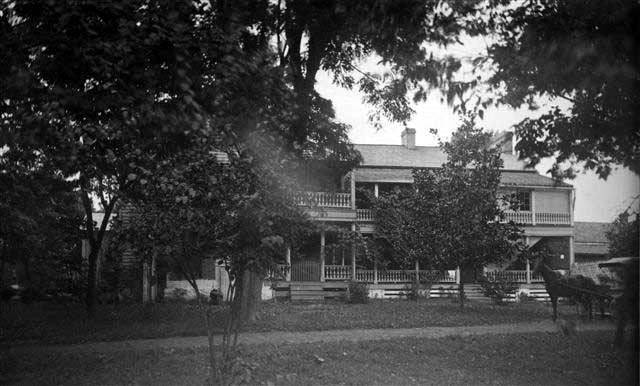
Travellers Rest, headquarters of Gen. John Bell Hood
Maj. Joseph B. Cummings was assigned to the staff of Gen. John Bell Hood. After the war, he wrote a colorful first-person account of his involvement in the battle and Hood’s staff, from the end of the Battle of Franklin to his final retreat back to Franklin. His paper, ‘War Recollections,” is in the Southern Historical Collection at the University of North Carolina at Chapel Hill. In this excerpt, he gives a personal glimpse of his days at Traveller’s Rest (John Overton’s home) where Hood set up his Nashville HQ, his faithful devotion to a barrel of Robinson (Robertson?) County whiskey, his “damn fool” exploits on a white horse during the fighting, a surprising meeting with a Union soldier, and his night time escape through open fields after the rout of the Confederate army on December 16.
Recollections of the Battle of Nashville by Maj. Joseph Cummings
Local Historian Describes Battlefield’s History
The link below contains a talk by Ridley Wills, II, a Nashville historian who has authored numerous books on local history, to the Lealand Garden Club of Nashville on October 7, 2013. The paper presents a very readable and fact-filled description of the history of the area of South Nashville which surrounded the Lealand Plantation and was a hotly-contested part of the battlefield during the Battle of Nashville.
Mr. Wills is a descendent of William Giles Harding, owner of Belle Meade Plantation, one of the city’s most prominent historic sites and which Mr. Wills wrote about in his book, The History of Belle Meade: Mansion, Plantation and Stud. In addition to his prolific output of books exploring Tennessee and Nashville history, he is also a past winner of the Tennessee History Book Award (1991), and has served as adjunct professor of history at Belmont University in Nashville.
Ridley Wills Lealand speech October 2013
BONT Included In USA Today “Travel Tips”
The Battle of Nashville Trust, along with numerous other Middle Tennessee Civil War resources, sites and locations, has been listed as a go-to resource for exploration of Battle of Nashville information. Also listed are Travellers Rest, Belmont Mansion, Fort Negley and others.
To see the article, go to USA Today Travel Tips.
Book: Tennessee’s Railroads During the Civil War
The Chattanooga Country: Gateway to History (the Nashville to Atlanta Rail Corridor of the 1860s) by Dr. James W. Livingood, presents a detailed overview of the status and importance of the rail system as it existed in Tennessee during the Civil War. It was published by the Chattanooga Area Historical Society in 1995. The volume is available through the CAHS for $15.00. See the link below for information about the book and Dr. Livingood. The book is hardcover with dust jacket and 698 pages in length.
Smithsonian.com Article: Dealing With Prostitution in Civil War Nashville
During the Union occupation of Nashville during the Civil War, prostitution was one of many problems the occupying forces had to deal with, and they came up with interesting answers to the questions. The article is available at :
Smithsonian.com Past Imperfect blog.
Article from the New York Times, February 8, 1865.
The article below was written for The New York Times about six weeks after the Battle of Nashville. It is in the form of a letter dispatched from a Times columnist who sent more than 50 dispatches from areas affected by the Civil War, many of them originating from Tennessee.
”FROM NASHVILLE”
Effects of the War on Tennessee — Destruction of Property Through Hood — Restitution — Death’s Doing Since Dec. 15 — A Good Sanitary Exhibit for 1865 — A Parting Word.
Nashville, Tenn, Sunday, Jan 29, 1865.
The citizens of Nashville will long remember Hood. The sense of the injuries inflicted on them and their city by his recklessness and folly, will have more than a passing poignancy. Before Hood came on his quixotic errand, the condition of the city was anything by seemly and desirable. It had long ceased to challenge praise from visitors of the ground of its beauty. The marring hoof of war had trodden too deeply for that. But it retained, in spite of three or four years incessant trampling of iron heels, many bright signs to show what it had been in it palmiest day. A number of its fairest edifices, lying without and around the city, had been but slightly touched by war’s deforming fingers. And though the citizen, as speaking to the stranger of Nashville now, and contrasting it with Nashville as before the war, sighed as some old Trojan, exclaimed, “”Ilsum fuit” [sic] might do, there were yet attractive points, here and there, to greet the eye, and give assurance that the city’s former claims to admiration were not placed a little too high.
Hood’s coming, and the effects it brought, made the little remnant less. The huge gaping trench and rifle-pit cordon around the city, stands a hideous disfiguration. It will stand thus for long, for these ghastly cuts, like those upon animate bodies, require time to cure. Right through many a smiling yard and fruitful garden, as the summer showed them, these remorseless gulches too their way, the fences on every side being torn down, and wept in to aid and finish the defences. Houses on the outskirts stood in all directions, and stand yet, bare of post or picket, as if a fence were thought a superfluity, and the people loved to have all things in common.
Many fences were carried away by the soldiers and burnt for fuel, on the biting cold days just before the battle. It was a “military necessity” for which it would be hard to blame the brave fellow who were shivering on the icy ground, and found nothing else to warm them. Even a part of the cemetery fence was demolished, as all would have been by the troops in their strait, had not the most energetic measures been restored to, to protect it. Hood’s forces around the city kept fuel from getting into it, and hence the pressure. A considerable section of Nashville, adjacent to the cemetery, is lying fenceless to-day.
Outside of the city limits, the havoc and desolation are more strikingly seen. Not only are the fences utterly swept away, but in many instances houses are burned or partially demolished by shells. From a stand-point half a mile beyond Fort Negley, and in the direction of the Franklin Pike, along which the most desperate fighting of the two days took place, the eye takes in numbers of houses that once lay nested in the bosom of tasteful shrubbery or rich forest growths, now denuded and bare as if planted in the heart of some Western prairie. I rode out to the house of Mrs. A. V. Brown, two miles and a half from the city, and just beyond the first line of rebel rifle-pits. The pits remained just as the rebels left them, and very artistically finished structures they were. They ran in front of Mrs. Brown’s house, which, with the fences around it, were not molested, though reported at one time burned. A strong rebel guard kept the premises from harm, and the family did not leave the house during the battles, nor while the rebels lay around. It is marvelous that the fast-falling shells from our forts and batteries did the house no injury, while others in its vicinity were dismantled. It has been Mrs. Brown’s singular good fortune to find protectors in both belligerents during all the rebellion. The sister of Gen. Pillow and the widow of one of our former Cabinet officers, her relations, added to her amiable and benevolent character, and the charms of her hospitable home, have seemed to make loyal and rebel rival each other in acting toward her the part of friends and guardians. Mrs. Ackland’s house, also, one of the most elegant in Nashville, situated just within our lines, and the headquarters of Gen. Wood during the battle of the 15th and 16th of December, enjoyed similar immunity. Some others near the battle-ground, and with shot and shell flying all around them, had an equally fortunate escape.
The destruction of property, however, was immense all around the city. It would be hard to write down the sum accurately in figures. Greater values were absorbed and sunk through the last abortive struggles of Hood than the rebellion ever inflicted on the State before. A good deal of these parties will seek to recover from the Government. Where private property was taken from Union citizens for the purposes of the Government, a claim may be put in, and a competent tribunal will decide how fair restitution shall me bade. It will be a slow process, and a difficult one, to decide truly between the many and conflicting claims which by and by will press upon the proper court. This will prove one of the troublesome sequels to the rebellion. The greater matter settled, however, the lesser ones will adjust themselves in due time.
The number of deaths in the various hospitals here since Dec. 15, is a trifle under 1,300, far the greater part have been wounds received in battle. The soldier’s cemetery contains a total of 11,500 of our heroic men, who devoted life for the country — a number equaling the entire population of many pretentious towns. This is but a fraction of the stupendous necrology that this dire rebellion has written up; and what an appalling picture does war present looked at in this aspect. To counterbalance this, the gains from the struggle must be great indeed. And they will be. Given the death of slavery alone, as the fruit of these frightful throes, and who will say that all these sacrifices have not been amply repaid?
The Winter mortality among the black people and the enlisted soldiers in colored regiments is large. It has averaged for this month and part of December, twenty deaths a day. Fifteen of these are from contrabands, about five from soldiers. The cold weather is hard upon the half-clad, half-fed and half-housed blacks, who have sought the asylum of the city in crowds. With all the considerate aid the Government can give them the condition of many is wretched enough. Freedom however, they sigh for, and will have when attainable; any lowly and suffering lot as freeman, in preference to slavery, though the chains may sit easily in some exceptional cases. The colored soldiers have good care in the hospitals provided for them. The numbers brought in wounded show how gallantly they performed their part in the recent battles. But wintry exposure in the field, affects them more than it does those of the more fortunate race. They suffer more from sickness proportionably [sic], and sickness seizes them with [a] stronger and more tenacious grasp. Field service, however, in the sultry season deems to harm them less. Their claim to being good soldiers, to rendering signal service to the cause they love to fight in, is established beyond dispute.
The Sanitary Commission’s work for this department during the year ending Jan. 1, 1865, deserves a glance. The number of articles distributed among our soldiers in hospitals and in the field, for this period reached the total of 1,021, 433 — one bushel, one pound, one gallon, and so on being counted as one article. There were disbursed 150,000 pounds of canned fruit, 114,655 pounds crackers, 72,823 pounds condensed milk, 35,446 bushels of potatoes, 25,484 bushels of onions, 36,397 bottles of wine and liquors, 51,854 gallons of pickles, and other articles of highest value to the needy soldier, on a like liberal scale. The streams of the people’s show, have continue to flow to with the steady and unimpeded current. It is one of the most marvelous spectacles that the eye has witnessed. It is a splendid record that will challenge praise from the coming ages, in behalf of a great Christian people, whose sentiments and acts proved them worthy of the trust which God devolved upon them.
Your correspondent, assigned to another department, closes with this letter the series addressed to the Times from Tennessee, but of fifty-two letters written since June of 1863, not one has failed to reach its destination, nor to appear in due time to afford perchance a transient interest to some of your many readers. A twenty months’ observation from a very interesting standpoint has enabled me to aid a little, I hope, in illustrating certain phases of the war, its effects on the border states, and especially Tennessee, the steadiness with which the great principles involved in the issue have advanced, and the sure and probably speedy triumph to crown the struggle for Union and Freedom. It has been pleasant to speak words of hope and good cheer in regard to the brightening future through the columns of a paper which, and has been, in full accord with the grand progressive movements of the age, and has hopefully stood by the righteous cause of nation unity and a sorely tried Government in the darkest hours. The worst danger is overpast [sic]. The nation will live. Its path, like that of the just, will grow brighter and brighter. And to have contributed something to his august and inestimable result, will be to the humblest helper a life-long glory and joy.
C.V.S.
Maps of Forest Hills Stone Wall Fences
During the summer of 2007, the staff of the R.O. Fullerton Laboratory for Spatial Technology at Middle Tennessee State University (MTSU) mapped the locations of stone fences in the City of Forest Hills, the small residential city in south-central Davidson County, Tennessee which comprises part of the Battle of Nashville battlefield. The mapping project was initiated at the request of Forest Hills Commissioner William Coke with the objective of developing a GIS (Geographic Information System) spatial data layer of stone fence locations.
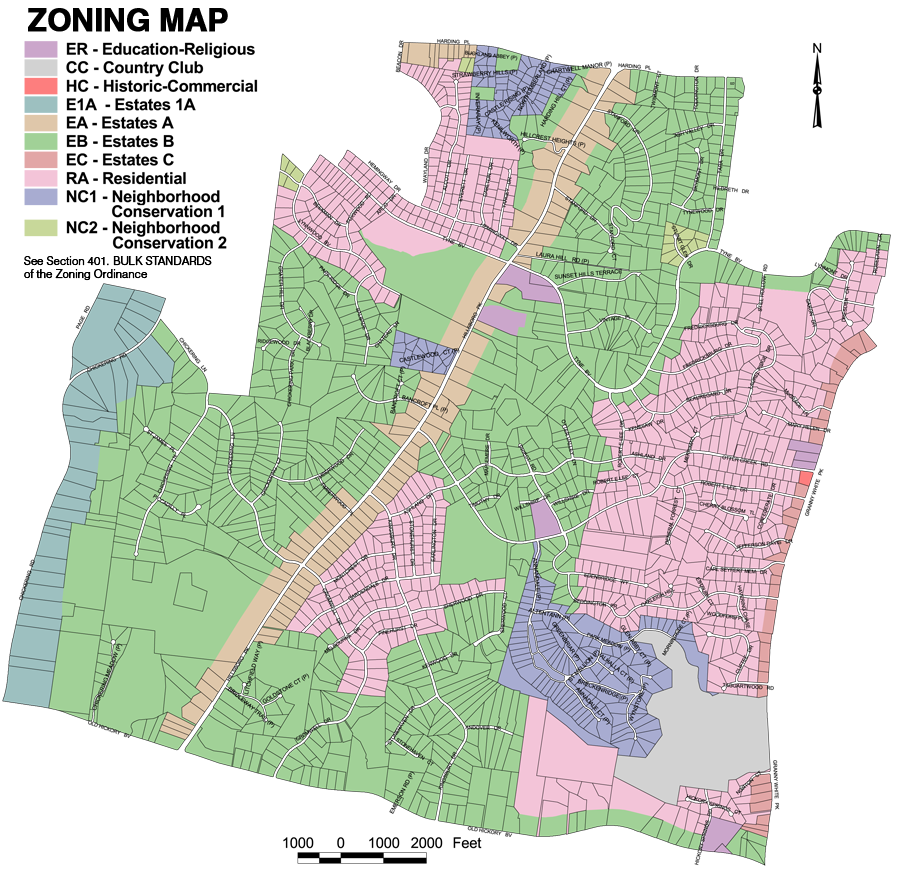
Above, a map showing present-day Forest Hills, bordered on the north by
Harding Place and on the east by Granny White Pike (Click to enlarge)
The project is important for its identification of dry-stacked stone wall fences that could have played a role in the battle. The 2007 study supplements an earlier 2001 study commissioned by Forest Hills which primarily concentrated on stone walls lining public streets. Both studies offer interesting insights into dry-stacked limestone walls, their history, location and preservation. Both can be found on the Forest Hills website:
2007 GPS Mapping of Stone Fences (R.O. Fullerton Laboratory for Spatial Technology at MTSU)
2001 A Survey of Stone Fences (Cumberland Research Group, Murfreesboro)
1963 Tennessean Article Revives Story
Confederate Mystery: Recovered Revolver Rekindles Strange Tale of Murder
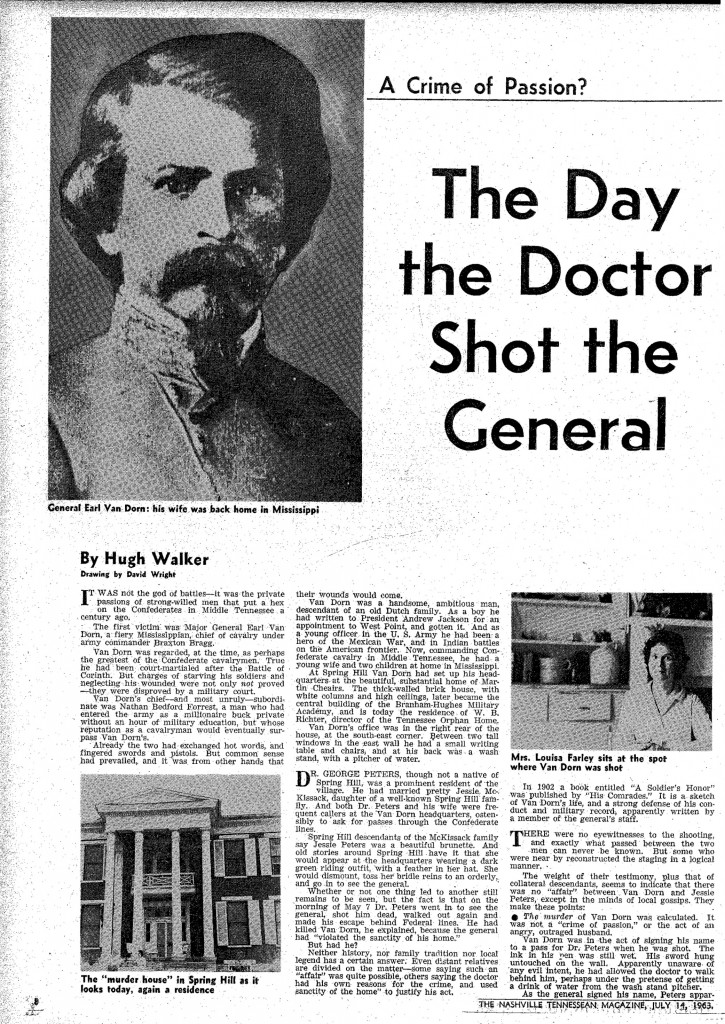
Above: Part I of Article (Click to Enlarge)
Edwin C. Bearss — History’s Pied Piper
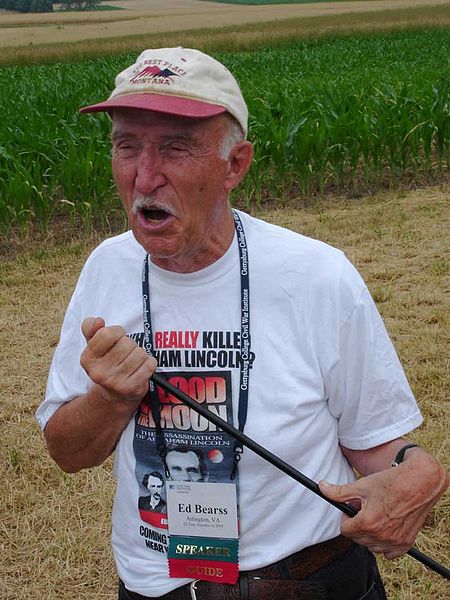 Ed Bearss is one of the country’s foremost military historians, focusing for most of his career on the Civil War as well as World War II, in which he served in the Pacific with the US Marine Corps and was wounded in combat. As a civilian, he became a legendary battlefield tour guide, serving as Chief Historian of the National Park Service from 1981 to 1994. His extensive knowledge of the Civil War and its battlefields has made him a household name among those who have studied the conflict. His work in this field includes being featured in Ken Burns’s PBS series on The Civil War.
Ed Bearss is one of the country’s foremost military historians, focusing for most of his career on the Civil War as well as World War II, in which he served in the Pacific with the US Marine Corps and was wounded in combat. As a civilian, he became a legendary battlefield tour guide, serving as Chief Historian of the National Park Service from 1981 to 1994. His extensive knowledge of the Civil War and its battlefields has made him a household name among those who have studied the conflict. His work in this field includes being featured in Ken Burns’s PBS series on The Civil War.
Mr. Bearss is a much sought after speaker and was in Nashville for a presentation on July 16, 2012 during which he spoke to a packed house gathered at the Looby Theater. To view and listen to a recording of his comments, click this link.
Below, BONT presents Edwin Cole Bearss — History’s Pied Piper, the complete 76-page biography written by John C. Waugh in 2003 for the Edwin Cole Bearss Tribute Fund, Inc., proceeds of which are dedicated to battlefield preservation. It chronicles the life and work of this consummate historian:
NOTE: Click link below to read book. This is a large PDF file. Please allow sufficient time for loading.
Edwin Cole Bearss
June, 1976
INTERVIEW WITH STANLEY F. HORN
This wide-ranging interview of Stanley Horn took place in Nashville in June, 1976 when he was 87 years old. The interviewer was Charles W. Crawford. Mr. Horn by then had authored 10 books, including the first detailed account of the Battle of Nashville entitled The Decisive Battle of Nashville, published in 1956. His many accomplishments in the area of Tennessee history included serving as State Historian of Tennessee and chairman of the Tennessee Civil War Centennial Commission.
Interview with Stanley Horn
___________________________________________________________
The South Is Risen, by Cara Moses.
Link to an interesting story about the Battle of Nashville
Rebel Yell
The recording below was made in the 1930’s with credits to WBT radio in Charlotte, NC
National Archives: Record Ordering Demystified: 10 East Steps
Genealogical Research
Effectively Tapping into Local, County, State Historical Societies and Libraries
By Barry J. Ewell
A detailed 69-page guide to researching your roots.
Nashville National Cemetery
1420 Gallatin Road South, Madison, TN 37115
(615) 860-0086
Office hours: M-F 8-4:30.
Gates open for visitation during daylight hours.
For more information, go to the cemetery website:
BURIAL LISTINGS:
On this website, there are 12,769 listings for Civil War-era soldiers (Union) buried at the National Cemetery.
View Burial Listings of Civil War-ear Soldiers
(Alphabetized by Last Name):
A | B | C | D | E | F | G | H | I | J | K | L | M
N | O | P | Q | R | S | T | U | V | W | XYZ
In addition, there are 4,131 unknown soldiers buried there.
Information for known burials includes (in order) Last Name, First Name and (if available) Middle Initial, Burial Section, Grave Number, Date of Death, State, and Rank.
HISTORY OF THE CEMETERY
 This hallowed ground was established as a U.S. Military Cemetery on Jan. 28, 1867. The Louisville & Nashville Railroad runs through the cemetery, dividing it into two nearly equal halves. The stone wall around the cemetery and the limestone archway at the front entrance were constructed in 1870. Among other outbuildings and structures, a speaker’s rostrum was completed in 1940.
This hallowed ground was established as a U.S. Military Cemetery on Jan. 28, 1867. The Louisville & Nashville Railroad runs through the cemetery, dividing it into two nearly equal halves. The stone wall around the cemetery and the limestone archway at the front entrance were constructed in 1870. Among other outbuildings and structures, a speaker’s rostrum was completed in 1940.
Roll of Honor, No. XXII, dated July 31, 1869, submitted to Quartermaster General’s Office, U.S.A., Washington, D.C., recorded the graves of 16,485 Union soldiers interred in the national cemetery at Nashville, Tennessee and remains as a part of the cemetery’s historical records.
Originally there were 16,489 interments (burials) of known soldiers and employees: 38 were officers, 10,300 were white soldiers, 1,447 were colored soldiers, and 703 were employees.
Among the unknown, there were 3,098 white soldiers, 463 colored soldiers and 29 employees. The deceased had been gathered from an extensive region of Middle Tennessee and southern Kentucky. The number of distinct burial places from which these bodies were taken is 251.
 A very large proportion of the dead in the cemetery, however, were transferred from the hospital burial grounds in and around the city of Nashville and from temporary burial grounds around general hospitals in Nashville and nearby battlefields of Franklin and Gallatin, Tenn. Reinterments were also made from Bowling Green and Cave City, Ky.
A very large proportion of the dead in the cemetery, however, were transferred from the hospital burial grounds in and around the city of Nashville and from temporary burial grounds around general hospitals in Nashville and nearby battlefields of Franklin and Gallatin, Tenn. Reinterments were also made from Bowling Green and Cave City, Ky.
During the Civil War, if marked at all, wooden headboards with the names and identifying data painted thereon marked graves of those who died in general hospitals, on the battlefields, or as prisoners of war. Many of these headboards deteriorated through exposure to the elements. The result was that when the remains were later removed for burial to a national cemetery, identifications could not be established, and the gravesites were marked as unknown.
NOTABLE MONUMENTS, MARKERS:
- Statue dedicated in 2006 to the United States Colored Troops who fought in the Civil War, including both days of The Battle of Nashville at Granbury’s Lunette and Peach Orchard Hill. This is the only free standing monument of a United States Colored Troop in America. Sculptor Roy W. Butler used William Radcliffe of the 13thUSCT as a model for the statue.
-
- One of the oldest private markers in the cemetery is a spire located in Section M, Grave 16234, which was dedicated to the memory of James A. Leonard of the 1st Kansas Battery. He was killed by guerillas on Jan. 23, 1864 and interred on Jan. 27, 1864.
- In 1920, the State of Minnesota erected a monument in Section MM inscribed, “In memory of her soldiers here buried who lost their lives in the service of the United States in war for Preservation of the Union–AD 1861-1865.”
- Chaplain Erastus M. Cravath, 101st Regiment Ohio Volunteer Infantry, was interred in Section MM, Grave 16694, in 1900. Chaplain Cravath was one of the founders of Fisk University in Nashville, and served for 25 years as its president.
- Colonel James W. Lawless, 5th Kentucky Cavalry, was buried in Section MM, Grave 10662, on June 25, 1899. Col. Lawless was born in Ireland and came to the United States at the age of 16.
Colonel Edward S. Jones, Commander of the 3rd Pennsylvania Cavalry, was also the founder of the Department of Tennessee and Georgia Grand Army of the Republic and served as Commander for many years. He was interred in Section MM, Grave 16520, in Nov. 1866.
“General George Thomas, The Sledge of Nashville,” by Historian Brian S. Wills
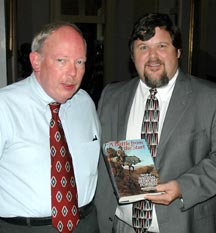
BONPS Program Director Mac Mellor, left, and speaker Brian Steel Wills, who shows his acclaimed biography of Nathan Bedford Forrest
Gen. George Henry Thomas, the victorious Union commander at the Battle of Nashville, was a native Virginian and career soldier who felt honor-bound to stay loyal to the Union when the Civil War began. The military career of General Thomas was the subject of a BONT program on June 17, 2004, at Belmont Mansion featuring Brian Steel Wills, a professor of history at the University of Virginia at Clinch Valley. Professor Wills is also a tour guide and biographer of Nathan Bedford Forrest with a biography of General Thomas in the works — “The Sledge of Nashville.” In 1860, Thomas supported the unsuccessful Presidential candidacy of Tennessean John Bell of the Constitutional Union Party. He was offered the position as Chief of Ordnance for the state of Virginia but he turned it down.
Because he fought for the Union, his family disowned him, “turned his picture to the wall,” and there was no reconciliation after the war.
Prior to the Battle of Nashville, Gen. U.S. Grant had nearly relieved Thomas of command because he was “too slow” in attacking Hood’s army.
After the battle, despite Thomas’ valuable military leadership at Mill Springs, Murfreesboro, Chickamauga, Missionary Ridge, Atlanta, and Nashville, Grant virtually dissolved Thomas’ command, scattering his troops throughout the Western Theater.
Wills considers Thomas to be one of the best generals of the Civil War, if not the best, ranking above even Grant and Sherman. Thomas was a graduate of West Point (ranking 12th in the 1840 class of 42) and fought in the Seminole and Mexican wars. Being a Virginian, his loyalty to the Union was often questioned. President Lincoln had his doubts, at least until Thomas’ West Point roommate, William T. Sherman, vouched for him.
Thomas was honest to a fault and did not participate in army politics. He was not much at self promotion.
During the 1862 Kentucky campaign, the command of the Dept. of the Ohio was offered to Thomas, but he turned it down because he thought it unfair to replace his commander, Gen. Don Carlos Buell, in the middle of a campaign.
Later, Thomas was “mortified” when he was overlooked and Buell was replaced by Gen. William S. Rosecrans, an officer of junior rank. Nevertheless he carried on as the loyal soldier that he was.
At Murfreesboro, his men held the center and prevented a rout of Rosecrans’ army. Asked after the first day if the beleaguered army should retreat, he replied, “I can think of no better place to die.” Days later, it was the Confederates who retreated.
At Chickamauga, a great Confederate victory, Thomas prevented a complete disaster and commanded an orderly retreat, earning the name “Rock of Chickamauga.”
At Missionary Ridge, his men stormed and carried the heights, stealing the honors from Grant’s favorite, Sherman. But, again, Thomas refused to take much of the credit.
Wills noted that writing a biography of Thomas is not an easy task in that his wife, a native Northerner, destroyed all of the general’s papers upon his death in 1870. He is buried at Oakwood Cemetery in Troy, NY, his wife’s home.
